Please use a modern browser to view this website. Some elements might not work as expected when using Internet Explorer.
- Landing Page
- Luxury Yacht Vacation Types
- Corporate Yacht Charter
- Tailor Made Vacations
- Luxury Exploration Vacations
- View All 3704
- Motor Yachts
- Sailing Yachts
- Classic Yachts
- Catamaran Yachts
- Filter By Destination
- More Filters
- Latest Reviews
- Charter Special Offers
- Destination Guides
- Inspiration & Features
- Mediterranean Charter Yachts
- France Charter Yachts
- Italy Charter Yachts
- Croatia Charter Yachts
- Greece Charter Yachts
- Turkey Charter Yachts
- Bahamas Charter Yachts
- Caribbean Charter Yachts
- Australia Charter Yachts
- Thailand Charter Yachts
- Dubai Charter Yachts
- Destination News
- New To Fleet
- Charter Fleet Updates
- Special Offers
- Industry News
- Yacht Shows
- Corporate Charter
- Finding a Yacht Broker
- Charter Preferences
- Questions & Answers
- Add my yacht
- Yacht Charter Fleet

Video: First look at 140m superyacht SOLARIS totally unveiled
- Share this on Facebook
- Share this on X
- Share via Email
By Nina Done 24 March 2021
New video footage of the elegant 140m mega yacht SOLARIS reveals more of her spectacular design features following her official launch from the Lloyd Werft shipyard in February — which was slightly hampered by a case of heavy fog. She has now left the German shipyard to undergo sea trials before her expected delivery this summer.
Penned by Australian designer Marc Newson in his debut superyacht project, SOLARIS is the culmination of four years under construction where the project has been mired in secrecy. Her preparation for sea trials comes after much excitement that's rippled through the yachting industry.
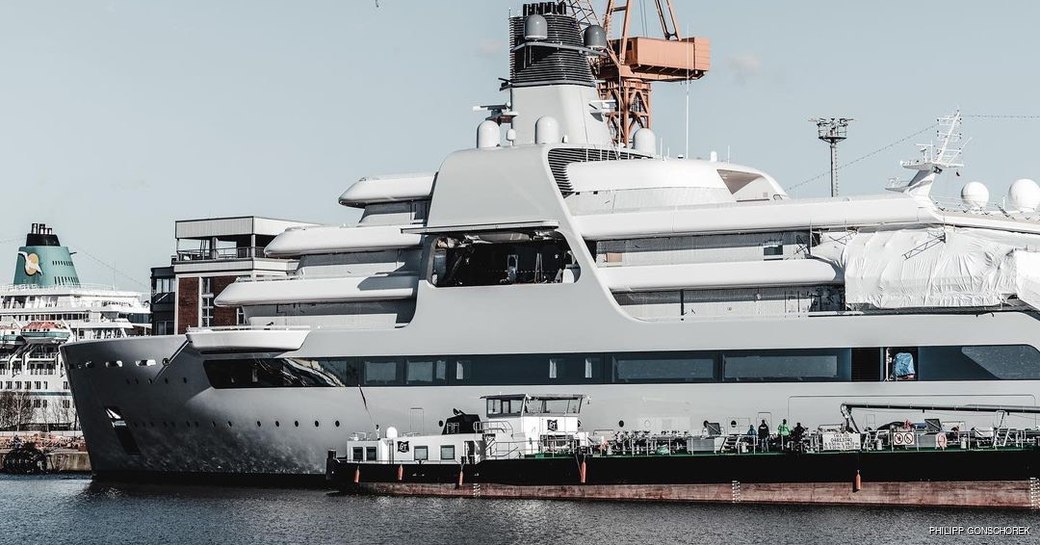
The video footage reveals an aft glass-bottomed pool, 2 beach clubs, an expansive swim platform and pronounced wing stations on either side offering enhanced visibility for the captain whilst maneuvering.
In addition, floor-to-ceiling windows will allow plenty of natural light throughout her interiors, with exterior glass railings offering unique views of her surroundings whilst enjoying the alfresco entertainment.
18 megawatts of combined propulsion...will propel SOLARIS at speeds unheard of for superyachts of this size.
SOLARIS boasts a whopping 8 decks, helipad, plus hangar and generous beach club aft. She also has a tender garage equipped with a crane for launching tenders, cleverly designed to be hidden away from the main guest areas.
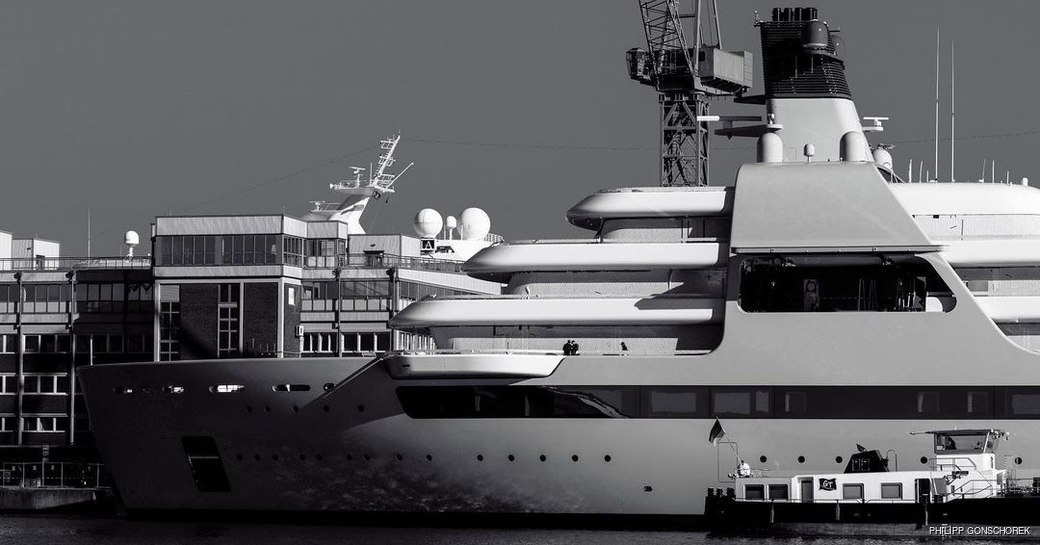
Her elegant appearance is accentuated by the large arch that wraps across the beam midships, providing a dramatic contrast with the sleek lines of her pale grey hull and crisp white superstructure.
Enhanced power
18 megawatts of combined propulsion delivered through two state of the art Azipods managed by an ABB Engine Management System will propel SOLARIS at speeds unheard of for superyachts of this size.
Availability for yacht charter?
SOLARIS is being built for an experienced owner and it is believed that she will not be offered for charter by those in the industry. If you would like to visit areas outside of the usual cruising grounds of the Mediterranean and Caribbean then please take a look our selection of expedition yachts for charter that are currently available.
For further advice please get in touch with your chosen yacht charter broker . Video by: DrDuu Photos: Philipp Gonschorek
Explorer yachts

73m Picchiotti 2014
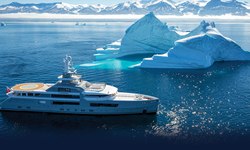
75m Abeking & Rasmussen 2016
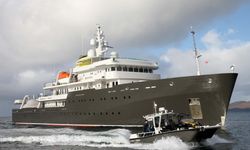
78m Piriou 2015

73m Admiral Yachts 2018
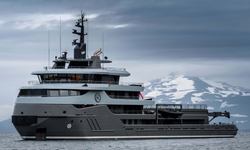
68m Royal Niestern Sander 2012 / 2020
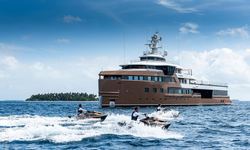
77m Damen Yachting 2020
RELATED STORIES
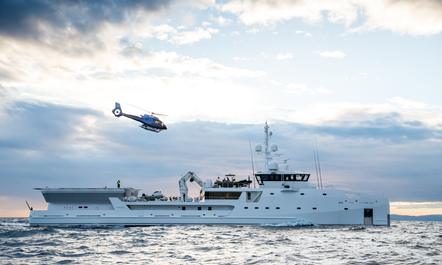
Previous Post
Ultra modern 45m AQUARIUS newly available for charter in Turkey this summer
Greece to welcome tourist yacht charters from mid-May
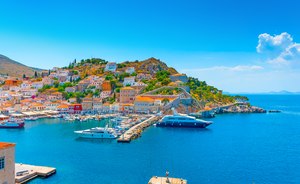
EDITOR'S PICK
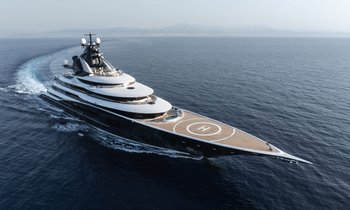
Latest News

18 September 2024
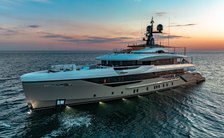
17 September 2024

16 September 2024
Yacht Reviews
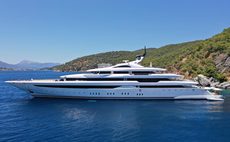

Charter Yacht of the week
Join our newsletter
Useful yacht charter news, latest yachts and expert advice, sent out every fortnight.
Please enter a valid e-mail
Thanks for subscribing
Featured Luxury Yachts for Charter
This is a small selection of the global luxury yacht charter fleet, with 3704 motor yachts, sail yachts, explorer yachts and catamarans to choose from including superyachts and megayachts, the world is your oyster. Why search for your ideal yacht charter vacation anywhere else?

136m | Lurssen
from $3,328,000 p/week ♦︎
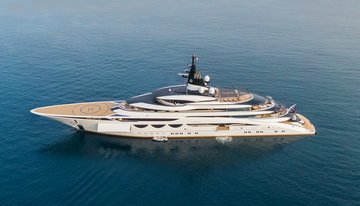
115m | Lurssen
from $2,874,000 p/week ♦︎
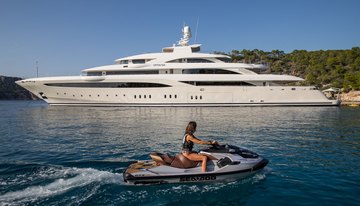
85m | Golden Yachts
from $1,001,000 p/week ♦︎
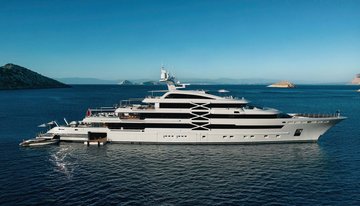
88m | Golden Yachts
from $1,222,000 p/week ♦︎
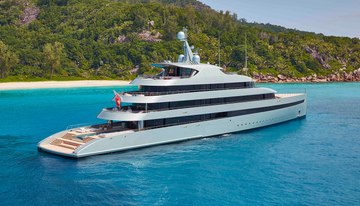
84m | Feadship
from $1,111,000 p/week ♦︎

93m | Feadship
from $1,556,000 p/week ♦︎
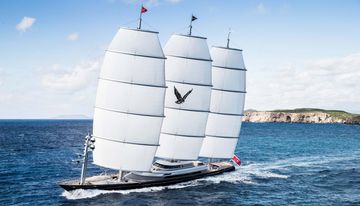
Maltese Falcon
88m | Perini Navi
from $490,000 p/week
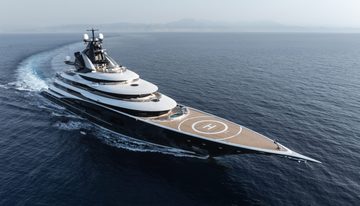
122m | Lurssen
from $3,000,000 p/week
As Featured In
The YachtCharterFleet Difference
YachtCharterFleet makes it easy to find the yacht charter vacation that is right for you. We combine thousands of yacht listings with local destination information, sample itineraries and experiences to deliver the world's most comprehensive yacht charter website.
San Francisco
- Like us on Facebook
- Follow us on Twitter
- Follow us on Instagram
- Find us on LinkedIn
- Add My Yacht
- Affiliates & Partners
Popular Destinations & Events
- St Tropez Yacht Charter
- Monaco Yacht Charter
- St Barts Yacht Charter
- Greece Yacht Charter
- Mykonos Yacht Charter
- Caribbean Yacht Charter
Featured Charter Yachts
- Maltese Falcon Yacht Charter
- Wheels Yacht Charter
- Victorious Yacht Charter
- Andrea Yacht Charter
- Titania Yacht Charter
- Ahpo Yacht Charter
Receive our latest offers, trends and stories direct to your inbox.
Please enter a valid e-mail.
Thanks for subscribing.
Search for Yachts, Destinations, Events, News... everything related to Luxury Yachts for Charter.
Yachts in your shortlist

Find anything, super fast.
- Destinations
- Documentaries

Lloyd Werft 140m Explorer Mega Yacht SOLARIS Delivered
By Jenna Mehdi
Yesterday marked the delivery of 140m luxury explorer yacht SOLARIS to her new owner. Having successfully completed sea trials, SOLARIS has departed Lloyd Werft’s yard in Bremerhaven to embark upon life after launch.
One of the most highly anticipated and reported-on launches of 2021, SOLARIS’ delivery marks the finalisation of one of the largest megayacht projects to be completed this year.
Lloyd Werft’s shipbuilding capacity was truly put to the test on this behemoth project; amongst other industry ‘firsts’, SOLARIS features over 2,000 square metres of glass and the largest ABB Azipod® system ever installed on a superyacht.
Lloyd Werft commented on the delivery: ‘ The handover marked the successful completion of this extraordinary project, which has been realised over several years of planning and building…
A number of very individual demands, some of them never experienced before in yacht building, have been incorporated into this project.
As we did with the legendary LUNA, we have once again built a yacht of the very highest quality.’
At 140m, SOLARIS is the largest explorer yacht to ever be built. Her design is a true evolution of her predecessor and Lloyd Werft flagship 115m LUNA . The new flagship cements the German yard’s status as a leader of the 100m+ building landscape.
"A number of very individual demands, some of them never experienced before in yacht building, have been incorporated into this project." Lloyd Werft Shipyard
"A number of very individual demands, some of them never experienced before in yacht building, have been incorporated into this project."
More news About…
Companies linked to this story, yachts in this story, more news from ..., new launches.

The global authority in superyachting
- NEWSLETTERS
- Yachts Home
- The Superyacht Directory
- Yacht Reports
- Brokerage News
- The largest yachts in the world
- The Register
- Yacht Advice
- Yacht Design
- 12m to 24m yachts
- Monaco Yacht Show
- Builder Directory
- Designer Directory
- Interior Design Directory
- Naval Architect Directory
- Yachts for sale home
- Motor yachts
- Sailing yachts
- Explorer yachts
- Classic yachts
- Sale Broker Directory
- Charter Home
- Yachts for Charter
- Charter Destinations
- Charter Broker Directory
- Destinations Home
- Mediterranean
- South Pacific
- Rest of the World
- Boat Life Home
- Owners' Experiences
- Conservation and Philanthropy
- Interiors Suppliers
- Owners' Club
- Captains' Club
- BOAT Showcase
- Boat Presents
- Events Home
- World Superyacht Awards
- Superyacht Design Festival
- Design and Innovation Awards
- Young Designer of the Year Award
- Artistry and Craft Awards
- Explorer Yachts Summit
- Ocean Talks
- The Ocean Awards
- BOAT Connect
- Between the bays
- Golf Invitational
- BOATPro Home
- Superyacht Insight
- Global Order Book
- Premium Content
- Product Features
- Testimonials
- Pricing Plan
- Tenders & Equipment

UAE One: Futuristic 140m “UAE flagship” concept presented by Italian designer
A 140-metre superyacht called UAE One has been revealed by the Milan-based designer Enzo Manca. The superyacht design is, according to Manca, "very different from the usual megayachts."
The bold concept has been tailored for the United Arab Emirates, "with the idea it should become the official flagship mega yacht of the state." According to Manca, the concept was designed with input from a Sheikh, with a focus on privacy and additional space for international meetings, as well as multiple transfer options, including a "mini-internal port" for tenders and a submarine.
Taking inspiration from defence ships and spanning nine decks over 2,800 square metres while towering up to 40 meters, the concept's exterior is defined by its distinctive curving lines. The tinted, mirrored windows and strong militant style add to the privacy element.
Reminiscent of an aircraft carrier — with its two heliports ideal for foreign delegates —the expansive circular deck space hosts various luxury amenities.
The 28-metre beam accommodates an 18-metre swimming pool that sits transversely, while the wellness centre and spa transform the concept from its military-style beginnings into a superyacht.
For further relaxation, the huge circular sofa positioned at the bow has been designed around a central fireplace to admire the 360-degree views. Meanwhile, the exterior lounging areas are shaded for additional comfort.
The yacht's interior space includes accommodation in various configurations, with one owner’s suite, eight master cabins and 14 mini-suites, with official interior design renderings still under development.
Three additional meeting rooms and a press area are envisioned for private, international meetings and gatherings. The crew quarters, comprising 35 cabins, will be large enough for staff of 65.
The UAE ONE concept aligns with Manca's existing portfolio of unique superyacht concepts.
Sign up to BOAT Briefing email
Latest news, brokerage headlines and yacht exclusives, every weekday
By signing up for BOAT newsletters, you agree to our Terms of Use and our Privacy Policy .
More stories
Most popular, from our partners, sponsored listings.
Superyachts of 140m (459 ft) In Length
Adapt your search results here:
Ocean victory.
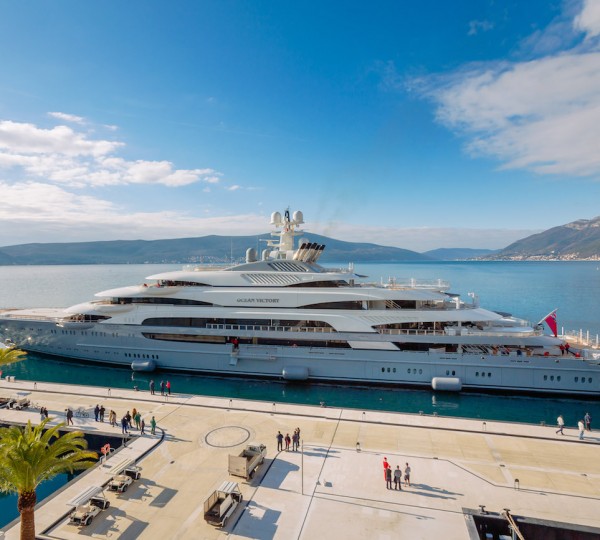
Project REDWOOD
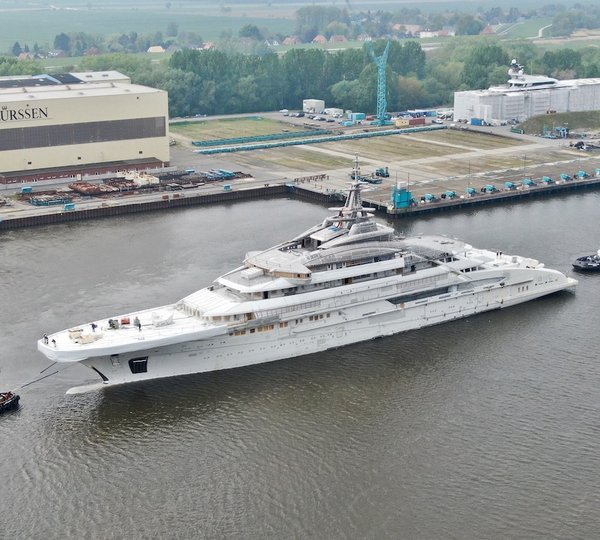
PROJECT SOLARIS
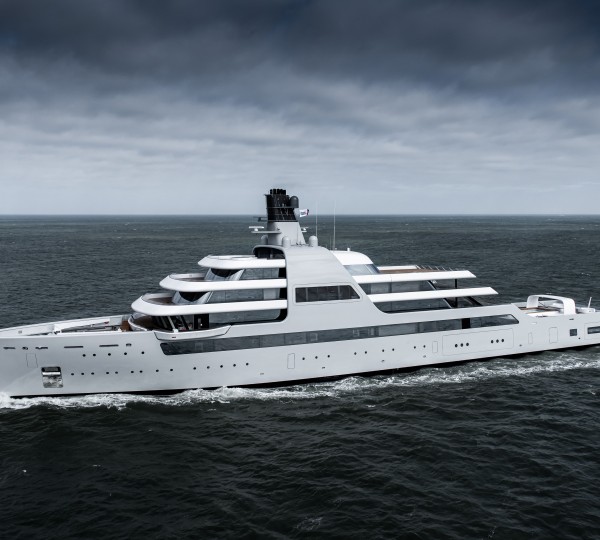
Project LUMINANCE
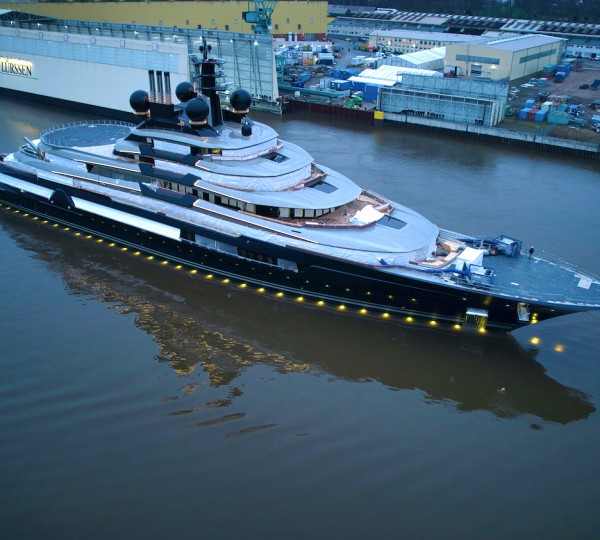
SCHEHERAZADE
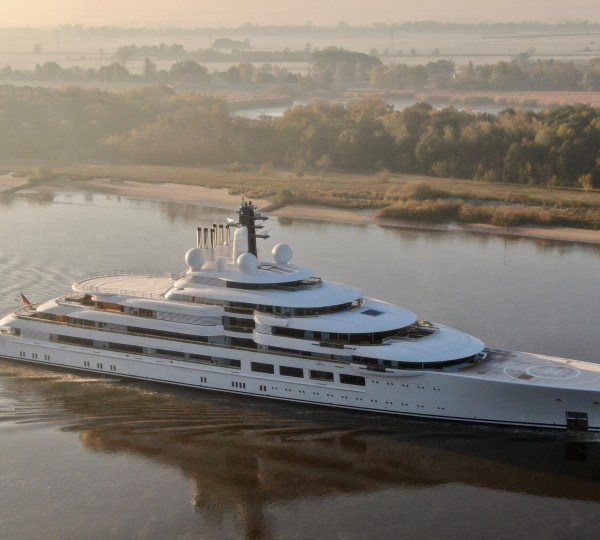

Home About Yachts GTX Concept Surface Shipyard
Pershing yachts

The ultimate expression of the Pershing thrill. The Pershing 140 is not only Pershing’s first all-aluminum superyacht. It is also the first yacht with a raised helm station directly connected to the sun deck. It is the first to set the area dedicated to the owner on the main deck and is also the first to have a beach area that can open fully on three sides.
The profile of the Pershing 140 displays the sleek lines that symbolize the brand's sporting, competitive spirit, enhanced by such iconic details as the two side wings integrated into the superstructure at the beginning of the walkways. The distinctly contemporary shape of the bow enhances the model's aerodynamics, guaranteed by the mooring cover with an automatic up/down mechanism that maintains the streamlined design.
Pershing 140 comes with four MTU 16 V 2000 M96L 2600 HP engines. The hydro-jet propulsion assures excellent performance levels, both at cruising and maximum speed. Consistent with the Pershing DNA, the domotics and electronic systems are all state-of-the-art and coniugate performance with well-being and relaxation. Three Seakeeper 35s guarantee absolute comfort even while at anchor.
The three large decks and spacious outdoor areas make living on board the Pershing 140 extremely comfortable. The revolutionary stern area architecture is designed to enhance onboard entertainment and is exhalted by the large beach club right at the water’s edge. To offer a personalised and unique thrill, all on-board decorations are tailored to reflect the owner’s style.

Need more details?
Request brochure

Need more details?
* * *
* Request a brochure Need more details?
-->
Copyright© 2024

Ferretti S.p.A.
Tax code and VAT no. 04485970968 Registered Office Via Irma Bandiera, 62 – 47841 Cattolica (RN) Italy REA no. RN 296608 - Companies Register no. 04485970968 Share capital € 338.482.654,00 fully paid-up PEC: [email protected]
Concept Design by Craq Design Studio
Development by Yodigito

Cookies on our site
For more information
Cookie Center
This website uses technical cookies, which are necessary for you to browse it and which help us to provide the service. With your consent, we use profiling cookies to offer you an increasingly agreeable browsing experience, to facilitate interaction with our social-media features, and to enable you to receive marketing messages tailored to your browsing habits and interests. To accept all profiling cookies, click ACCEPT ; to decline, click REFUSE . For more information about the cookies we use, please see our Cookie Policy.
always active
Millennium Super Yachts
Millennium 140.
Specifications: Tri-Deck Luxury Hi- Speed Yacht Principle Dimensions Length Overall - 139'3" (42.40m) Length Waterline - 107'3" (32.75m) Beam - 27'1" (8.250 m) Draft - 6'2" (1.88m) Fuel - 15,000 gal (56,781 l) Speed Based on tank tests at the Wolfson Unit of the University of Southampton, and preliminary sea trials 70 Knots is expected with all propulsion systems operating and maximum speed of approximately 45 Knots on diesel propulsion alone. Propulsion Twin Paxman 18VP185 Diesels (5300 Hp) Driving Maneuverable Lipps Water Jets Twin Lycoming Jet Turbines (TF40) (4700 Hp) Driving Fixed Lipps Water Jet Booster Hull Plating: Alustar Aluminum Modified Full Planning Hull With Deep Vee Entry Naval Architect: Frank Mulder: Holland Principle Suppliers Generators - Northern Lights Air Conditioning - J.D. Knowles Turbine Gear - Allen Gear Turbines - Lycoming/Allen Industries Electronics - Imtech Sore Power Converter - Mastervolt Entertainment System - Intellect Audio Hydraulics & Stabilization - Quantum Engineering Fixtures and Sanitary Ware - Serdaneli Appliances - Sub-Zero, Miele, GE Tri-Deck Layout Helm Deck: Encompasses primary navigation bridge, Captain's cabin, Engineer's cabin, sky lounge with wet bar and entertainment center, and aft deck lounging area with retractable sun awning. Helm area includes Helm seat, two double wide observer seats, fully integrated helm station and electronics, Helm Dinette (seats 4-6) Main Deck: Luxurious owners cabin forward with walk in closets, his and her baths, Jacuzzi Tub, and shower, galley with country kitchen (seats 8) appliances include SubZero and Miele, dining room (seats 10), main saloon, entry foyer, and aft deck entertainment area with built in settees and tables and retractable sun awning. Lower Deck: Crew quarters forward with two twin bunk rooms, and crew lounge. Guest quarters include two twin guest staterooms, one double guest stateroom with 3 large hull windows, and a luxurious king VIP stateroom with 3 large hull windows. Engine room aft. Interior Furnishings are built to full scale luxury standards with burl walnut and lacquer finishes utilizing techniques from the luxury aircraft industry, including nomex honeycomb core materials, marbles and granites bonded to aluminum honeycomb backing and other weight saving techniques and materials.

Home: Introduction to Millennium Super Yachts
Line: introduction to line of john staluppi's millennium super yachts, news: monthly updates for john staluppi news, john staluppi: philanthropist, yacht builder, car magnate, millennium 160, millennium 118, millennium 80, millennium 75.


Custom Line 140′ [NEW]
At 42.15 metres in length overall and with a maximum beam of 8.57 metres the new Custom Line flagship marries timeless elegance with Italian design and leading-edge technology.
Created in partnership with the Product Strategy Committee led by Mr. Piero Ferrari and the Ferretti Group Engineering Department.
The project has a profoundly sporty aesthetic, as well as offering the highest standards of comfort for owner and guests.
![Custom Line 140′ [NEW] - Featured Custom Line 140′ [NEW] - Featured](https://www.mennyacht.com/wp-content/uploads/2022/11/CustomLine140NewCruising_0006_63284-1000x667.jpg)
Technical details
MTU 16V 2000 M96L
Contact specialist
Mennyacht sales, direct contact.

- New Luxury Yachts
- New available for 2024
- Used Luxury Yachts
- Chase boats and tenders
- Used tenders and toys
- Destinations
Choose your favourite yacht brand

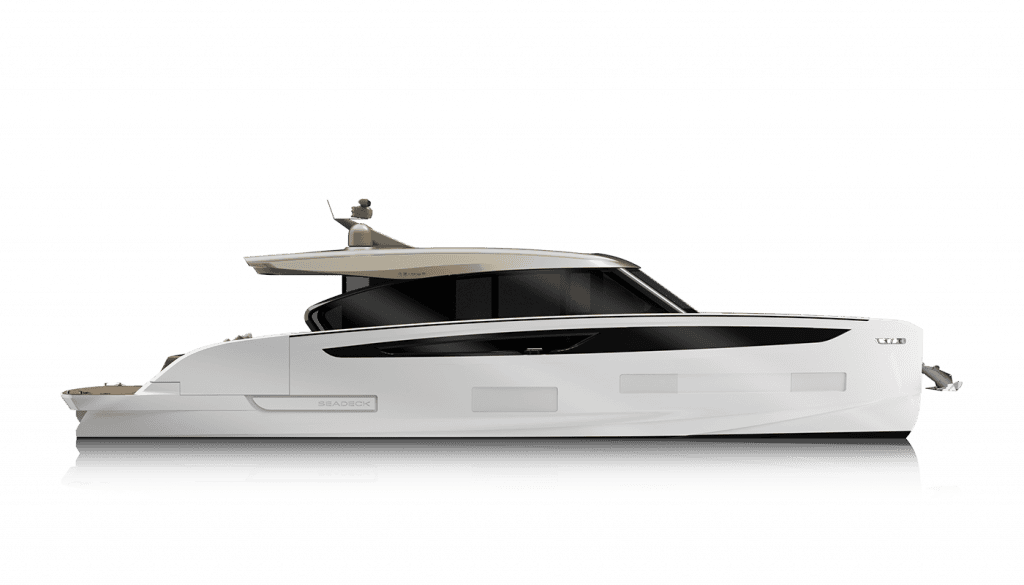
Find a dealer
Charter club, news & events.

Three decks + One, pure freedom
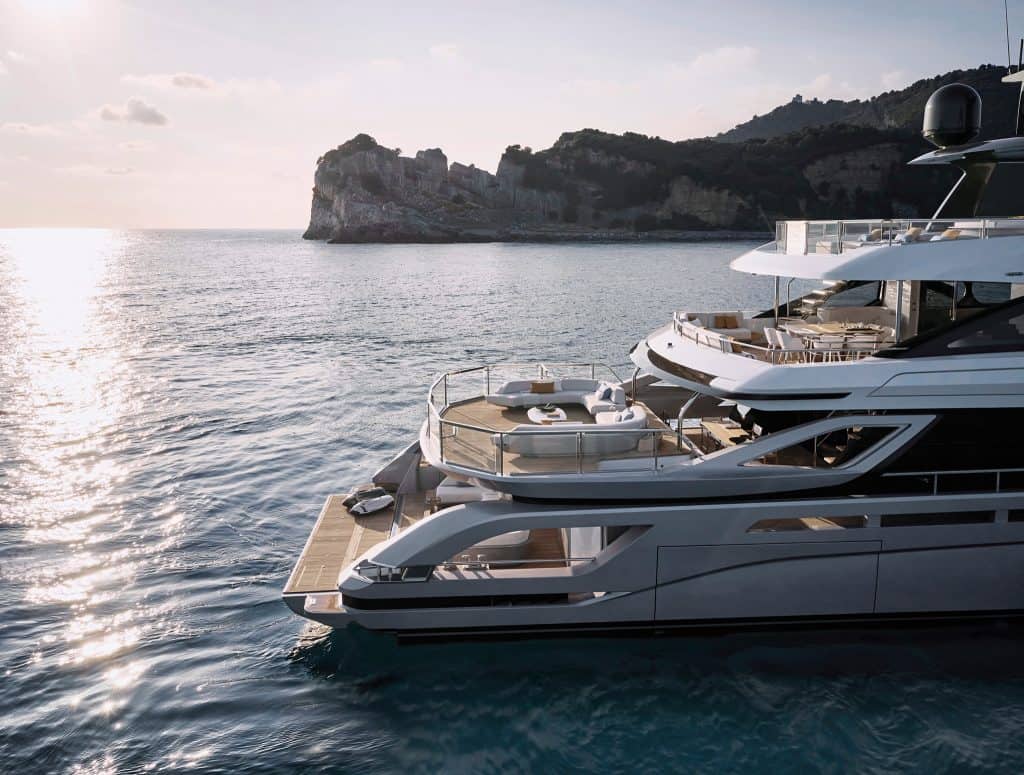
The luxurious layout liberates life on board, interpreting the environment and the spaces anew through the different levels offered by the staggered decks. From the stunning Sea View Terrace, to the elegant private patio and the lively beach area just above the sea’s scintillating surface, the Three Decks + One solution is a flexible and deeply enveloping ocean experience.
A natural multi-purpose philosophy
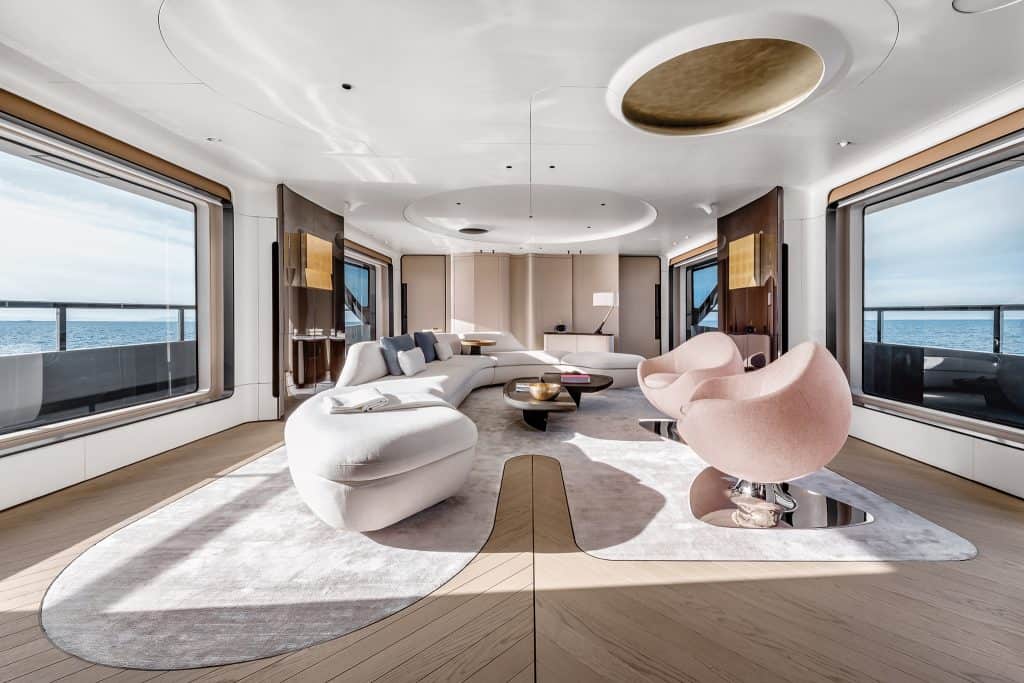
All exterior and interior living areas are conceived as light-filled and airy settings with authentic adaptability in mind. The multi-purpose intention of the ambiences is designed to meet the contemporary demands of a less formal lifestyle on board, resolving the daily requirements of the different guests on the Azimut Grande Trideck.
Function and style, reimagined
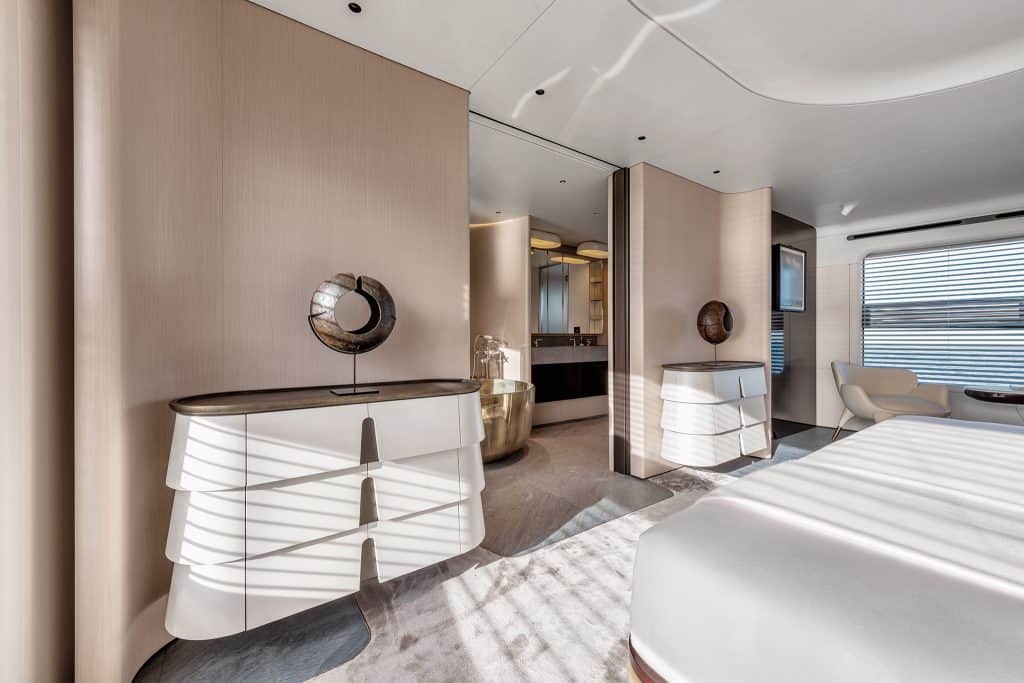
The concept of the interior ambiences, the furnishings as well as every design element, are all conceived and crafted by designer Achille Salvagni. Inspired by the essence of water, a wholesome and organic vision reimagines the role of space with a uniquely artisanal approach, embracing a natural but precious way of life on board.
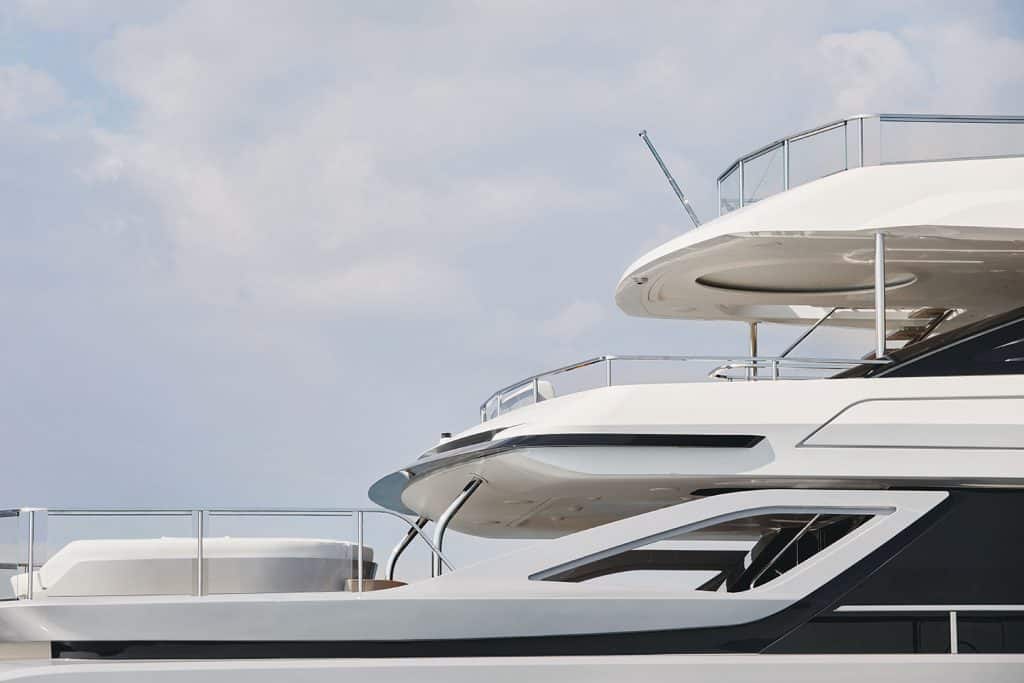
BREATHTAKING OPEN-AIR BEAUTY
The stage-like Sea View Terrace is born to overlook the marine panorama from a uniquely privileged point of view, suspending spectacularly over the water. At the same time, the superior sundeck makes for a perfectly relaxing sunbathing area, while the upper deck below it boasts the main outdoor dining area. Last but not least, the beach area beautifully and naturally connects the guests with the water and their natural surroundings.
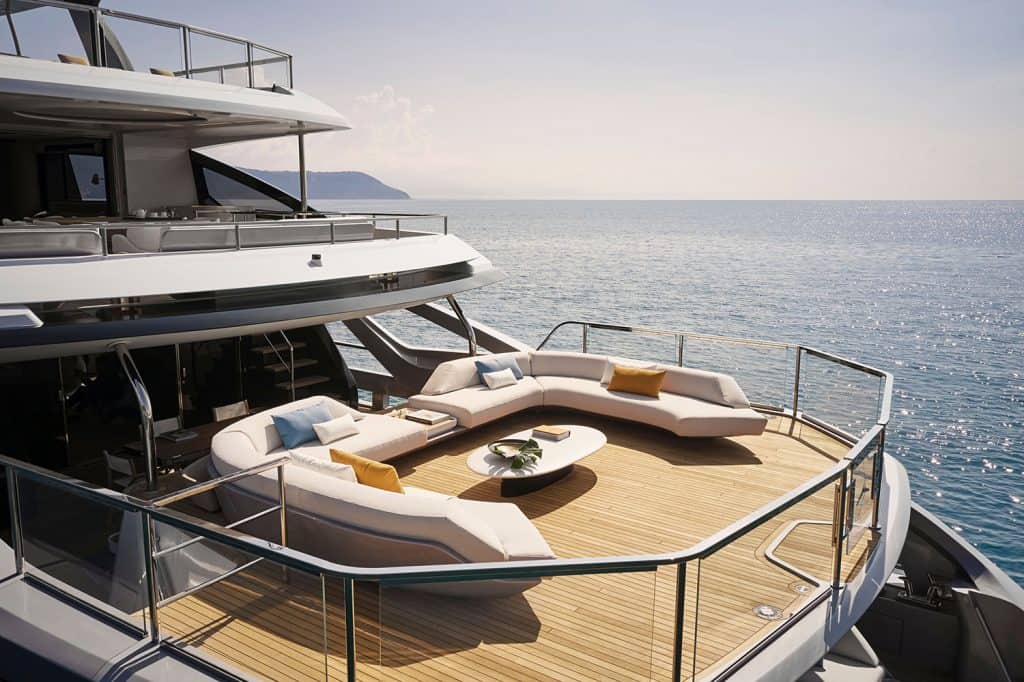
THE PLEASURE OF PRIVACY
Nestled between the Sea View Terrace and the entrance to the salon, the main deck delivers another particularly surprising space: the refined and reserved private patio. An extension of the indoor living ambience as well as a protected outdoor zone, this creative and intimate environment encourages conviviality through easy-going lunching, dining or lounging moments.

ABSOLUTE AESTHETICS
As a detailed continuation of the reinvented spatial integrity on the Grande Trideck, the design-oriented attitude of every element exposes a liquid-like and essentialist soul. Every intervention occurs to remove the superfluous, focusing on a profoundly artisanal identity that enhances the architectural quality of the surroundings and the preciousness of the loose furniture through noble materials and special finishes.
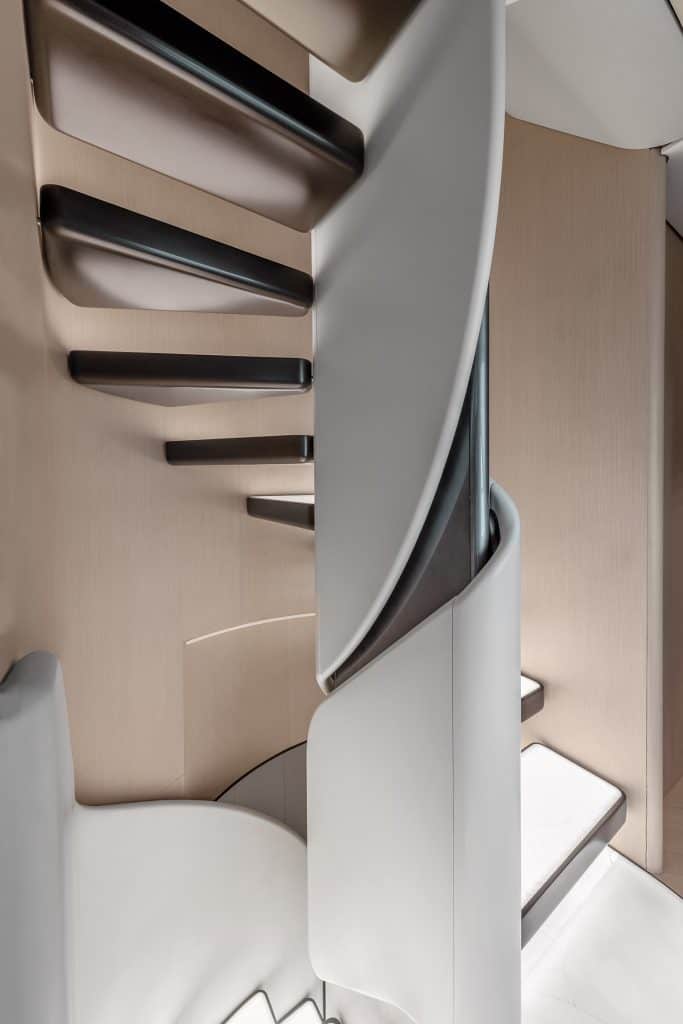
Our advanced toolkit
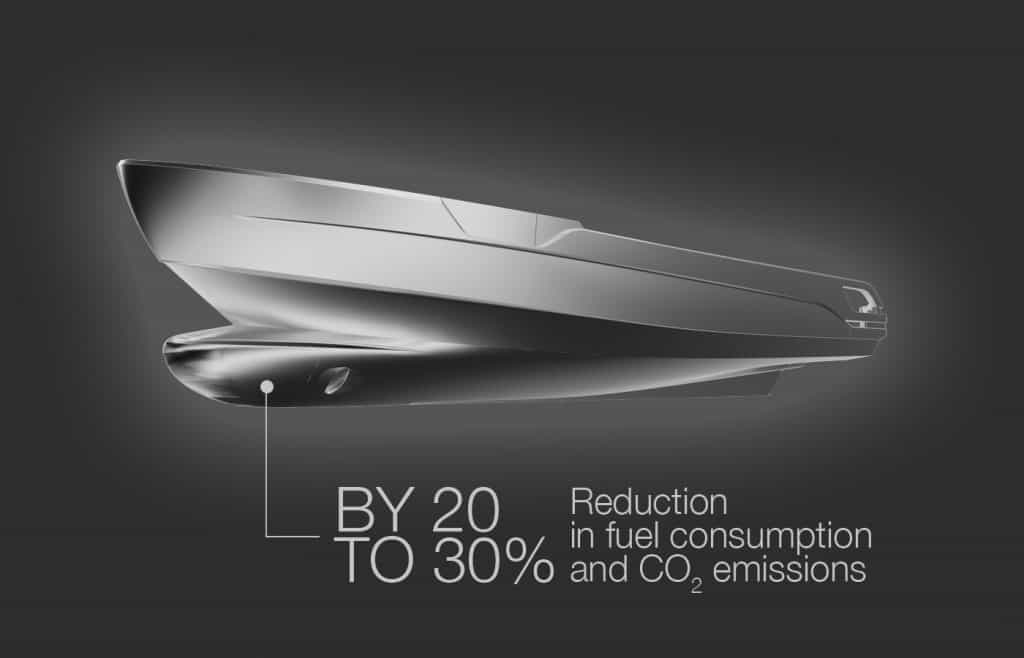
AZIMUT D2P DISPLACEMENT TO PLANING HULL
The high-efficiency D2P® Displacement-to-Planing hull, combined with the extensive use of carbon fiber, reduces fuel consumption and CO2 emissions by 20 to 30%* at both slow and fast cruising speeds. The double chine hull comes to a wave piercer at the bow, minimizing the impact of sea conditions while increasing the waterline length and therefore reducing drag.
* compared to vessels of the same weight and size with a traditional hard-chine hull
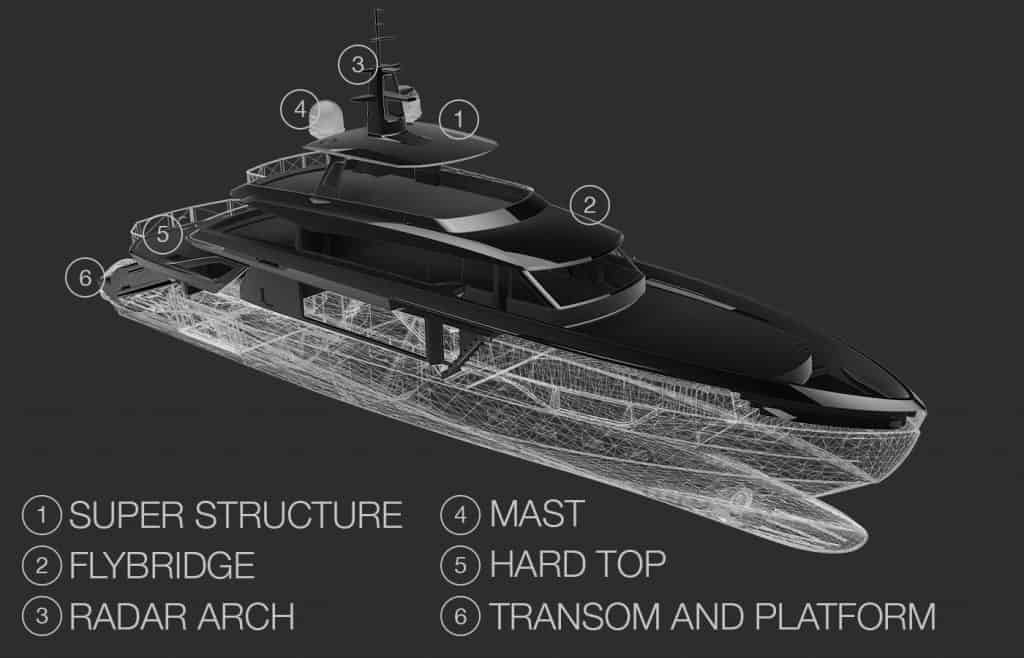
Azimut’s pioneering use of carbon fiber lamination goes beyond pure performance. The Carbon-Tech Generation offers expanded volumes on board, while maintaining excellent dynamic stability and perfect handling. Preserving the yacht’s low center of gravity, the carbon fiber was focused on the upper parts of the yacht, lightening the laminated components by up to 30% and reducing the natural roll momentum up to 15%.
A 130kW/h lithium-ion battery pack can support the yacht’s hotel load for up to 4 hours during the day and up to 8 hours at night. Now, it’s possible to enjoy the full superyacht experience without the noise, vibration and emissions of the generators, making daytime activities more pleasant and nighttime relaxation more peaceful.

GRANDE TRIDECK AT A GLANCE
- Length overall (incl. pulpit) 38,22 m (125’ 5’’)
- Beam max 7,98 m (26’ 2’’)
- Draft (incl. props at full load) 2,05 m (6' 9'')
- Displacement (at full load) 190 t (418874 lb)
- Building material GRP + Carbon Fibre
- Exterior designer Alberto Mancini
- Interior designer Achille Salvagni Architetti
- Hull designer P.L. AUSONIO Naval Architecture & Azimut Yachts R&D Dept.
- Builder Azimut Yachts
- Keel D2P Displacement to planing hull
- Certifications Rina Class Pleasure
- Cabins 5/6 + 4 crew
- Berths 10 + 6 crew
- Head compartments 7 + 4 crew
- Engines 2 x 2400 hp MTU 2 x 2600 hp MTU
- Maximum speed (test load) up to 23/25 kn
- Cruising speed (performance test mass) up to 19/20 kn
- Fuel capacity approx 22.500 l (5945 Gal)
- Water capacity approx 4000 l (1057 Gal)
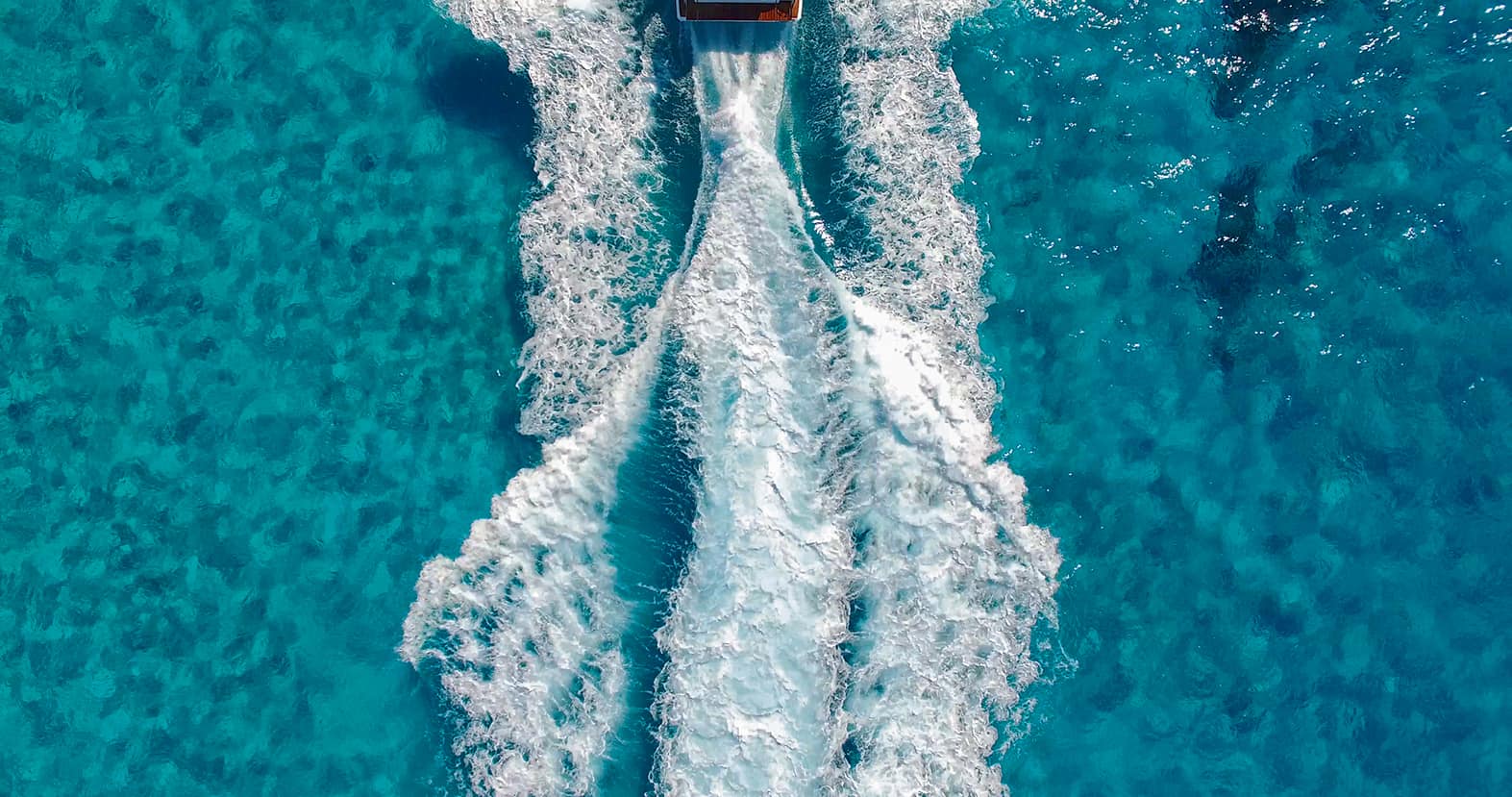
Azimut updates
Choose to remain updated on Azimut’s yachts, launches, shows and more by subscribing to our newsletter.
I have read Azimut Benetti s.p.a. privacy notice and:
I agree to receive the newsletter about Azimut’s world from Azimut Benetti s.p.a.
You will soon receive your first newsletter with the latest Azimut news.
Follow us on WECHAT

Please keep me updated on everything about this yacht.
Non venderemo mai i tuoi dati, manterremo i tuoi dati al sicuro e non condivideremo mai i tuoi dati con terze parti per scopi di marketing. You can update your contact details at any time by emailing [email protected] or change your mind by clicking “unsubscribe” in any email you receive from us.
I agree to receive, via email, informational material regarding Azimut products from Azimut Benetti s.p.a..
We have successfully received your request and will contact you shortly.
Our newsletter will provide you with the latest news, on boat launches, previews and shows.
Complete the form below to be contacted by a dedicated dealer who will gladly respond to your questions and requirements.
I agree with the disclosure of my personal data to other companies belonging to Azimut Benetti s.p.a. group and /or to third-party companies affiliated with Azimut Benetti s.p.a. for the sale of its products.
We have successfully received your request. One of our select dealers will contact you shortly.
Specify your request
Fill in the required fields and submit the form.
I have read Azimut Benetti s.p.a. privacy notice.
Thank you for your interest
Se hai scelto di non accettare i cookie di profilazione e tracciamento, puoi aderire all’abbonamento "Consentless" a un costo molto accessibile, oppure scegliere un altro abbonamento per accedere ad ANSA.it.
Ti invitiamo a leggere le Condizioni Generali di Servizio , la Cookie Policy e l' Informativa Privacy .
Accesso Consentless
Puoi leggere tutti i titoli di ANSA.it e 10 contenuti ogni 30 giorni a €16,99/anno
- Servizio equivalente a quello accessibile prestando il consenso ai cookie di profilazione pubblicitaria e tracciamento
- Durata annuale (senza rinnovo automatico)
- Un pop-up ti avvertirà che hai raggiunto i contenuti consentiti in 30 giorni (potrai continuare a vedere tutti i titoli del sito, ma per aprire altri contenuti dovrai attendere il successivo periodo di 30 giorni)
- Pubblicità presente ma non profilata o gestibile mediante il pannello delle preferenze
- Iscrizione alle Newsletter tematiche curate dalle redazioni ANSA.
Per accedere senza limiti a tutti i contenuti di ANSA.it
Scegli il piano di abbonamento più adatto alle tue esigenze.
Se hai cambiato idea e non ti vuoi abbonare, puoi sempre esprimere il tuo consenso ai cookie di profilazione e tracciamento per leggere tutti i titoli di ANSA.it e 10 contenuti ogni 30 giorni (servizio base):
Se accetti tutti i cookie di profilazione pubblicitaria e di tracciamento, noi e 750 terze parti selezionate utilizzeremo cookie e tecnologie simili per raccogliere ed elaborare i tuoi dati personali e fornirti annunci e contenuti personalizzati, valutare l’interazione con annunci e contenuti, effettuare ricerche di mercato, migliorare i prodotti e i servizi.Per maggiori informazioni accedi alla Cookie Policy e all' Informativa Privacy .
Per maggiori informazioni sui servizi di ANSA.it, puoi consultare le nostre risposte alle domande più frequenti , oppure contattarci inviando una mail a [email protected] o telefonando al numero verde 800 938 881. Il servizio di assistenza clienti è attivo dal lunedì al venerdì dalle ore 09.00 alle ore 18:30, il sabato dalle ore 09:00 alle ore 14:00.
- ANSA English
- ANSA Europa-UE
- ANSA NuovaEuropa
- ANSA America Latina
- ANSA Brasil
- ANSA China 中国
- ANSA Corporate
- Commissione Ue
- Turista morta a Napoli
- ResponsAbilmente
- ANSA Verified
- Salute&Benessere
- Terra&Gusto
- Osservatorio IA
- Canale ANSA2030
- Primo Piano
- Industry 4.0
- Criptovalute news
- Fondimpresa
- Human Tech Expo
- L'intervista
- Mobilità e infrastrutture
- Real Estate
- Fisco & Lavoro
- Cassa di previdenza
- Ordini professionali
- Tutte le news
In evidenza
- Approfondimenti
- ABC Investimenti
- Business Wire
- Blue Economy
- Ultima ora di Economia
- America Latina
- Medio Oriente
- Mediterraneo
- Nord America
- Ultima ora di Mondo
- Un film al giorno
- Un libro al giorno
- Libri e Film
- Il libro in piazza
- Altre Proposte
- Tutte le notizie di Libri
- Ultima ora di Cultura
- Altri Sport
- OLIMPIADI 2024
- Paralimpiadi
- Ultima ora di Sport
- Future Tech
- Internet e Social
- Software e App
- Tutte le notizie di Tecnologia
- Scuola, Università e Giovani
- Salute & Benessere
- Terra & Gusto
- Emilia-Romagna
- Friuli V.G.
- Trentino Alto Adige/Südtirol
- Valle d’Aosta
Siti internazionali
- Notiziario Teleborsa
- Codici Sconto
- Orientamento Università Online
Nautica, eccellenza Crn al Monaco yacht show 2024

- Regione Marche
- Primo piano
- Terra&Gusto
- Marche & Europa
ANCONA , 17 settembre 2024, 15:13
Redazione ANSA

- RIPRODUZIONE RISERVATA
Crn, specializzato nella progettazione, ingegnerizzazione e costruzione di superyacht pure custom fino a 95 metri, sarà presente al prossimo Monaco Yacht Show 2024, in programma dal 25 al 28 settembre nell'iconica cornice di Port Hercule, nel cuore di Monte-Carlo. In questo luogo - faro dell'industria nautica globale - Crn si appresta a raccontare un nuovo capitolo della sua storia di eccellenza artigianale, maestria tecnica, competenza e perizia lunga oltre 60 anni, presso l'Appontement Jules Soccal - SYBAss Avenue, stand n°JS1. Fondato nel 1963, Crn ha rivoluzionato il mondo dello yachting realizzando progetti unici e riconoscibili e introducendo standard che sono diventati riferimento mondiale nella nautica da diporto di lusso. Oggi il cantiere navale di Ancona - polo multibrand di Ferretti Group - è un sito strategico e produttivo fondamentale che rappresenta l'arte del saper fare, del design e della progettazione navale, con livelli straordinari di ricerca e innovazione: valori che sono da sempre presenti nel Dna di Crn. Qui si progettano e costruiscono i super e megayacht Crn in metallo dai 60 ai 95 metri, tutta la gamma made-to-measure Custom Line da 30 ai 43 metri in composito e i branded flagship superyacht totalmente in alluminio: Riva Superyacht Division dai 50 metri, Custom Line 50 metri e Pershing 140. Sono 4 i superyacht Crn in costruzione presso la Superyacht Yard di Ancona. Il nuovo Crn M/Y 143 Project Maranello - 67 metri in acciaio e alluminio, il cui varo è atteso per il prossimo autunno 2024 - unisce il know-how e la qualità progettuale e costruttiva di Crn con la creatività dello studio Nuvolari Lenard sia per gli esterni che per gli interni. Per il 2026 è prevista la consegna di Crn M/Y 145 Project Thunderball, il 70 metri in acciaio e alluminio realizzato in collaborazione con lo studio di architettura Vripack - che ne ha progettato le linee esterne e l'architettura navale, quest'ultima insieme al team Ferretti Group Superyachts Division Engineering - e con lo studio Nauta Design, che ne ha sviluppato gli interiors e gli arredi delle aree outdoor. Con il varo atteso nel 2026, Crn M/Y 144 sarà la nuova ammiraglia dello storico marchio con la sua lunghezza fuori tutto di 86 metri: l'architettura navale è stata sviluppata da FG Superyachts Division Engineering, mentre gli esterni sono stati disegnati dallo studio di architettura Vallicelli Design. Infine, il nuovo 67 metri CRN M/Y Project 146, che segna la decima collaborazione del cantiere con lo studio Nuvolari Lenard: il varo è atteso per il 2027.
Riproduzione riservata © Copyright ANSA
Da non perdere
- prevPageLabel
- nextPageLabel
Nyt: Israele dietro l'attacco coi cercapersone contro Hezbollah
Seul e tokyo: la corea del nord ha lanciato missili balistici, champions: fonseca, il milan è fragile in difesa, caracas arresta quarto statunitense, cospirava contro maduro, maltempo: auto travolte dall'acqua nel foggiano, disperso vf, champions: milan - liverpool 1-3, sky news, mossad modificò i cercapersone prima della consegna, israele arruola richiedenti asilo offrendo permessi di soggiorno.
Condividi articolo
Newsletter ANSA
Veloci, dettagliate, verificate. Nella tua casella mail.

Beirut, attentato sui cercapersone: i feriti arrivano all'ospedale

L'attentato in Libano e in Siria: il video di una delle esplosioni

30 anni di "Friends", gli abiti del set vanno all'asta a Los Angeles

Ecco la nuova commissione Ue

Von der Leyen: "Fitto? 'L'Italia e' un Paese molto importante"

Meloni firma con De Luca l'accordo per lo sviluppo e la coesione per 3,5 miliardi

Iene Vegane a Milano contro la Fashion Week: "Si puo' essere belli anche senza animali morti"


Studio sulle antibiotico resistenze, entro il 2050 39 milioni di morti


- Visit Our Blog about Russia to know more about Russian sights, history
- Check out our Russian cities and regions guides
- Follow us on Twitter and Facebook to better understand Russia
- Info about getting Russian visa , the main airports , how to rent an apartment
- Our Expert answers your questions about Russia, some tips about sending flowers

Russian regions
- Chelyabinsk oblast
- Khanty-Mansi okrug
- Kurgan oblast
- Sverdlovsk oblast
- Nizhny Tagil
- Tyumen oblast
- Yamalo-Nenets okrug
- Map of Russia
- All cities and regions
- Blog about Russia
- News from Russia
- How to get a visa
- Flights to Russia
- Russian hotels
- Renting apartments
- Russian currency
- FIFA World Cup 2018
- Submit an article
- Flowers to Russia
- Ask our Expert
Yekaterinburg city, Russia
The capital city of Sverdlovsk oblast .
Yekaterinburg - Overview
Yekaterinburg or Ekaterinburg (Sverdlovsk in 1924-1991) is the fourth most populous city in Russia (after Moscow, St. Petersburg, and Novosibirsk), the administrative center of the Ural Federal District and Sverdlovsk Oblast.
This city is one of the country’s largest transport and logistics hubs, as well as an important industrial center. It is unofficially called the “capital of the Urals.”
The population of Yekaterinburg is about 1,493,600 (2022), the area - 468 sq. km.
The phone code - +7 343, the postal codes - 620000-620920.
Ekaterinburg city flag
Ekaterinburg city coat of arms.
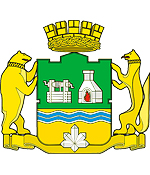
Ekaterinburg city map, Russia
Ekaterinburg city latest news and posts from our blog:.
26 May, 2020 / Unique Color Photos of Yekaterinburg in 1909 .
2 December, 2018 / Yekaterinburg - the view from above .
21 November, 2018 / Abandoned Railway Tunnel in Didino .
4 December, 2017 / Stadiums and Matches of the World Cup 2018 in Russia .
3 January, 2017 / Ekaterinburg, the Capital of the Urals: Then and Now .
More posts..
News, notes and thoughts:
4 April, 2011 / Free travel on new high-speed trains should allay fans' fears about long journey to Ekaterinburg - the most far-flung city on Russia's list of sites for 2018 World Cup. Let's hope the train will not break down in the middle of nowhere.
1 February, 2011 / Today is the 80th anniversary of the birth of Boris Yeltsin, the first president of Russia. President Medvedev today unveiled a monument to Yeltsin in his home city Ekaterinburg. First one in Russia.
History of Yekaterinburg
Foundation of yekaterinburg.
The territory along the Iset River, which served as a convenient transport route from the Ural Mountains deep into Siberia, has long attracted settlers. The oldest of the currently discovered settlements on the territory of present Yekaterinburg was located next to the Palkinsky Stone Tents rock massif and dates back to the 6th millennium BC.
From the 7th-3rd centuries BC, ancient metallurgists who mastered the smelting of copper lived in this settlement. Copper figures of birds, animals, people, arrowheads, various household items were found here. Later they learned how to make iron products. All discovered settlements were destroyed as a result of fires, possibly during raids of the conquerors.
The territory occupied by present Yekaterinburg became part of Russia in the middle of the 17th century. At that time, it had practically no permanent population. The first Russian settlements were founded in the second half of the 17th century. At the beginning of the 18th century, the first ironworks were built here.
In the spring of 1723, by decree of Emperor Peter I, the construction of the largest iron-making plant in Russia began on the banks of the Iset River. Construction began on the initiative of Vasily Tatishchev (a prominent Russian statesman). He was supported by Georg Wilhelm de Gennin (a German-born Russian military officer and engineer), on the initiative of which the fortress plant was named Yekaterinburg in honor of Empress Catherine I (Yekaterina in Russian), the wife of Peter I.
More Historical Facts…
The historic birthday of Yekaterinburg is November 18, 1723. On this day, a test run of the plant equipment was carried out. Its main products included iron, cast iron, and copper. In 1725, the Yekaterinburg Mint began production on the territory of the fortress and became the main producer of copper coins in the Russian Empire. Until 1876, it produced about 80% of the country’s copper coins. In the 1720s, the population of Yekaterinburg was about 4,000 people.
Yekaterinburg - one of the economic centers of the Russian Empire
In the middle of the 18th century, the first ore gold in Russia was discovered in this region, which was the beginning of the gold industry in the country. As a result, Yekaterinburg became the center of a whole system of densely located plants and began to develop as the capital of the mining region, which spread on both sides of the Ural Range.
In 1781, Catherine II granted Yekaterinburg the status of a county town in the Perm Governorate. The population of the town was about 8,000 people. In 1783, the town received a coat of arms depicting an ore mine and a melting furnace, which symbolized its mining and metallurgical industries (similar images are depicted on the current coat of arms and flag of Yekaterinburg).
In 1783, the Great Siberian Road was opened - the main road of the Russian Empire that passed through Yekaterinburg. It served as an impetus for the transformation of Yekaterinburg into a transport hub and a center of trade. Thus, Yekaterinburg, among other towns of the Perm Governorate, became the key town for the development of the boundless and rich Siberia, the “window to Asia”, just as St. Petersburg was the Russian “window to Europe.”
In 1808, the Yekaterinburg plant was closed, and the history of the town entered a new stage related to the development of a large regional center with a diversified economy. At the beginning of the 19th century, the gold mining industry flourished. At the same time, deposits of emeralds, sapphires, aquamarines, diamonds, and other precious, semiprecious, and ornamental stones were discovered in the Urals. Yekaterinburg became one of the world centers for their artistic processing.
After the abolition of serfdom in 1861, the mining industry of the Urals experienced a severe crisis, a number of plants were closed. In 1878, the first railway was constructed across the Urals and connected Yekaterinburg with Perm. In 1888, the Yekaterinburg-Tyumen railway was built, and in 1897 - the railway to Chelyabinsk, which provided access to the Trans-Siberian Railway. Yekaterinburg became a major railway junction, which contributed to the development of the local food industry, especially flour milling. In 1913, the population of Yekaterinburg was about 69,000 people.
Yekaterinburg in the first years of Soviet power
On November 8, 1917, Soviet power was established in Yekaterinburg. On April 30, 1918, the last Russian emperor Nicholas II and his family members with a few servants were transported from Tobolsk to Yekaterinburg. They were placed in the “House of Special Purpose”, the mansion of engineer Nikolai Ipatiev requisitioned for this purpose, and transferred under the supervision and responsibility of the Ural Regional Soviet.
In July 1918, units of the White Siberian army approached Yekaterinburg, under this pretext the leadership of the Ural Regional Soviet decided to shoot the imperial family. On the night of July 16-17, 1918, it was done in the basement of the Ipatiev House.
10 days later, units of the Czechoslovak Legion entered Yekaterinburg. Over the next 12 months, it was under the control of anti-Bolshevik forces. On July 14, 1919, the Red Army reoccupied the city. Soviet authorities and the Yekaterinburg Province with a center in Yekaterinburg were restored. In 1920, the population of the city was about 94,400 people.
The political center of the Urals moved from Perm to Yekaterinburg. In 1923, Yekaterinburg became the administrative center of the vast Ural Oblast, which in size exceeded the territory of the present Ural Federal District of Russia. In 1924, the city council decided to rename the capital of the new region to Sverdlovsk - in honor of Yakov Sverdlov, a Bolshevik party administrator and chairman of the All-Russian Central Executive Committee.
Sverdlovsk - a Soviet industrial giant
During the years of Stalin’s industrialization, Sverdlovsk was turned into a powerful industrial center. The old factories were reconstructed and new large factories were built, including giant machine-building and metal processing plants. In 1933, the construction of the future flagship of Soviet engineering (Uralmash) was completed. The population of Sverdlovsk grew by more than 3 times, and it became one of the fastest growing cities in the USSR.
January 17, 1934, Ural Oblast was divided into three regions - Sverdlovsk Oblast with a center in Sverdlovsk, Chelyabinsk Oblast with a center in Chelyabinsk, and Ob-Irtysh Oblast with a center in Tyumen. By the end of the 1930s, there were 140 industrial enterprises, 25 research institutes, 12 higher educational institutions in Sverdlovsk. In 1939, the population of the city was about 425,500 people.
Along with other Ural cities, Sverdlovsk made a significant contribution to the victory of the USSR in the Second World War. In total, more than 100,000 residents of the city joined the Red Army. 41,772 people didn’t return from the war: 21,397 - killed in battles, 4,778 - died from wounds in hospitals, 15,491 - went missing, 106 - died in prisoner of war camps.
Sverdlovsk became the largest evacuation point, more than 50 large and medium enterprises from the western regions of Russia and Ukraine were evacuated here. During the war years, industrial production in Sverdlovsk grew 7 times.
After the war, this city became the largest center for engineering and metalworking in Russia. During the Cold War, Sverdlovsk, as a key center of the defense industry, was practically closed to foreigners. In 1960, in the sky above the city, Soviet air defense shot down the U-2 spy plane of the US manned by Francis Gary Powers.
On January 23, 1967, a millionth resident was born in the city and Sverdlovsk became one of the first Russian cities with a population of more than 1 million people. In 1979, Sverdlovsk was included in the list of historical cities of Russia.
On October 4, 1988, a serious accident occurred at the Sverdlovsk railway station. The train carrying almost 100 tons of explosives rolled downhill and crashed into a coal freight train. An explosion occurred, aggravated by the proximity of a large warehouse of fuels and lubricants. The funnel at the site of the explosion had a diameter of 40-60 meters and a depth of 8 meters, the shock wave spread 10-15 kilometers. The explosion killed 4 people at the station and injured more than 500 people. About 600 houses were severely damaged.
Yekaterinburg - one of the largest cities of the Russian Federation
On September 4, 1991, the Sverdlovsk City Council of People’s Deputies decided to return the city its original name - Yekaterinburg. The population of the city was about 1,375,000 people. The restrictions on foreign visitors to the city were also lifted, and soon the first consulate general was opened here - the United States of America (in 1994).
The transition to a market economy led to a reduction in production at industrial enterprises, inert giant plant found themselves in a particularly difficult situation. In 1991, the construction of the television tower was stopped. The city was flooded with chaotic small retail trade in temporary pavilions and markets. These years were the heyday of organized crime, Yekaterinburg became one of the “criminal capitals” of Russia. The economic situation began to improve by the end of the 1990s.
In 2000-2003, the Church on Blood in Honour of All Saints Resplendent in the Russian Land was built on the site of the Ipatiev House in Yekaterinburg. In 2008-2009, the Koltsovo Airport was reconstructed. In June 15-17, 2009, SCO (Shanghai Cooperation Organization) and BRIC (Brasilia, Russia, India, China) summits were held in Yekaterinburg.
In 2015, the Presidential Center of Boris Yeltsin, the first president of Russia, was opened in Yekaterinburg. On March 24, 2018, the abandoned unfinished television tower was dismantled. It was the tallest building in the city (almost 240 meters) and became one of the symbols of Yekaterinburg. 4 matches of FIFA World Cup 2018 were played in Yekaterinburg.
Today, Yekaterinburg is the largest center of attraction not only of Sverdlovsk Oblast, but also of the surrounding regions. By some socio-economic indicators, this city ranks third in Russia, after Moscow and St. Petersburg. Along with the development of trade and business, the city lost the status of the country’s largest industrial center.
On the streets of Yekaterinburg
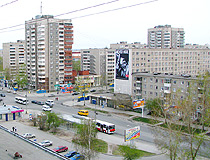
Soviet-era apartment buildings in Yekaterinburg
Author: Alex Kolm
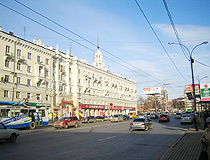
In the central part of Yekaterinburg
Author: Serg Fokin
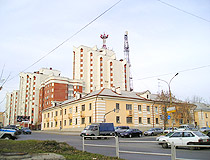
Yekaterinburg street view
Author: Krutikov S.V.
Yekaterinburg - Features
Yekaterinburg is located in the floodplain of the Iset River on the eastern slope of the Middle Urals in Asia, near its border with Europe, about 1,800 km east of Moscow. Since the Ural Mountains are very old, there are no significant hills in the city.
This relief was a favorable condition for the construction of the main transport routes from Central Russia to Siberia (the Siberian Route and the Trans-Siberian Railway) through Yekaterinburg. As a result, it has become one of the most strategically important centers of Russia, which still provides a link between the European and Asian parts of the country.
Yekaterinburg is located in the border zone of temperate continental and continental climates. It is characterized by a sharp variability in weather conditions with well-defined seasons. The Ural Mountains, despite their low height, block the way to the masses of air coming from the west from the European part of Russia.
As a result, the Middle Urals is open to the invasion of cold Arctic air and continental air of the West Siberian Plain. At the same time, warm air masses of the Caspian Sea and the deserts of Central Asia can freely enter this territory from the south.
That is why the city is characterized by sharp temperature fluctuations and the formation of weather anomalies: in winter from severe frosts to thaws and rains, in summer from heat above plus 35 degrees Celsius to frosts. The average temperature in January is minus 12.6 degrees Celsius, in July - plus 19 degrees Celsius.
The city has a rather unfavorable environmental situation due to air pollution. In 2016, Yekaterinburg was included in the list of Russian cities with the worst environmental situation by this indicator. Car emissions account for more than 90% of all pollution.
Yekaterinburg ranks third in Russia (after Moscow and St. Petersburg) in the number of diplomatic missions, while their consular districts extend far beyond Sverdlovsk Oblast, and serve other regions of the Urals, Siberia, and the Volga region.
In terms of economy, Yekaterinburg also ranks third in the country. It is one of the largest financial and business centers of Russia. The main branches of production: metallurgical production and metalworking, food production, production of electrical equipment, electronic and optical equipment, production of vehicles, production of machinery and equipment, chemical production.
Almost all types of urban public transport are presented in Yekaterinburg: buses, trolleybuses, trams, subways, taxis. Yekaterinburg is the third largest transportation hub in Russia: 6 federal highways, 7 main railway lines, as well as Koltsovo International Airport, one of the country’s largest airports. The location of Yekaterinburg in the central part of the region allows you to get from it to any major city of the Urals in 7-10 hours.
Yekaterinburg has an extensive scientific and technical potential, it is one of the largest scientific centers in Russia. The Presidium and about 20 institutes of the Ural Branch of the Russian Academy of Sciences, 66 research institutes, and about 30 universities are located here.
This city is a relatively large tourist center. A significant part of tourists visit it to honor the memory of the last Russian emperor and his family killed by the Bolsheviks in the basement of the Ipatiev House in 1918.
There are about 50 different museums in Yekaterinburg. One of the world’s largest collections of constructivist architectural monuments has been preserved here. In total, there are over 600 historical and cultural monuments in the city, of which 43 are objects of federal significance. The City Day of Yekaterinburg is celebrated on the third Saturday of August.
Interesting facts about Yekaterinburg
- It was founded by the decree of the first Russian Emperor Peter I and the last Russian Emperor Nicholas II was shot here;
- In 1820, the roof of the UK Parliament building in London was made of roofing iron produced in Yekaterinburg;
- Ural steel was used in the construction of the Eiffel Tower in Paris;
- Ural copper was used in the construction of the Statue of Liberty in New York;
- During the Second World War, Sverdlovsk was the center of broadcasting in the USSR;
- Equipment for the world’s deepest borehole (Kola Superdeep Borehole, 12,262 meters) was produced in Yekaterinburg;
- Boris Yeltsin, the first president of Russia, began his political career in Yekaterinburg;
- Minor planet #27736 Yekaterinburg, discovered by the Belgian astronomer Eric Elst on September 22, 1990, was named in honor of this city;
- Two most northern skyscrapers in the world are located in Yekaterinburg: the Iset residential tower (209 m) and the Vysotsky business center (188 m), they are the tallest buildings throughout Russia east of Moscow.
Pictures of Yekaterinburg
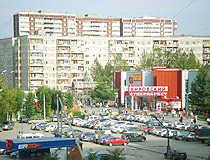
Yekaterinburg city view
Author: Andrey Zagaynov
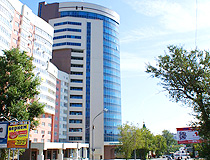
Modern architecture in Yekaterinburg
Author: Yury Baranov
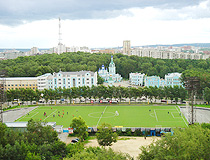
The territory of the central stadium of Yekaterinburg before reconstruction
Author: Sergey Likhota
Main Attractions of Yekaterinburg
Sevastyanov House - a palace of the first quarter of the 19th century built in the architectural styles of pseudo-Gothic, Neo-Baroque, and Moorish traditions and painted in green, white, and red tones. Today, it is the most beautiful building in Yekaterinburg and one of its symbols. The house stands on the promenade of the Iset River, very close to the city dam. Lenina Avenue, 35.
“Plotinka” - the dam of the city pond on the Iset River built in the 18th century. From an architectural point of view, it is an ordinary bridge. However, it is of particular importance for the residents of Yekaterinburg since the construction of the entire city started from this place. Today, this is the main place for festivities in Yekaterinburg. Lenina Avenue.
Observation Deck of the Business Center “Vysotsky” - an open-air observation deck on the 52nd floor at an altitude of 168 meters. From here you can enjoy the views of all of Yekaterinburg. On the second and third floors of this skyscraper there is the memorial museum of Vladimir Vysotsky - a singer, songwriter, and actor who had an immense effect on Soviet culture. Malysheva Street, 51.
Vaynera Street - the central avenue of Yekaterinburg, the so-called “Ural Arbat”. One of its parts from Kuibysheva Street to Lenina Avenue is a pedestrian street. This is one of the oldest streets in Yekaterinburg laid in the middle of the 18th century. Along it, you can see merchant mansions, shops, administrative buildings, most of which were built in the late 19th and first half of the 20th centuries.
Rastorguev-Kharitonov Palace (1794-1824) - one of the most valuable architectural manor and park ensembles in Yekaterinburg, an architectural monument of federal significance built in the classical style and located in the city center. Karla Libknekhta Street, 44.
Church of the Ascension (1792-1818) - one of the oldest churches in Yekaterinburg located next to the Rastorguev-Kharitonov Palace. This beautiful building combines the features of baroque, pseudo-Russian style, and classicism. Klary Tsetkin Street, 11.
Yeltsin Center - a cultural and educational center dedicated to the contemporary history of Russia, as well as the personality of its first president, Boris Yeltsin. The museum dedicated to his life is one of the best museums in Russia. Borisa Yeltsina Street, 3.
Yekaterinburg Museum of Fine Arts - the largest art museum in the Urals housed in two buildings. This museum is best known for its unique collection of Kasli art castings and the world-famous Kasli cast iron pavilion - a participant in the 1900 Paris World’s Fair.
The following collections can also be found here: Russian paintings of the 18th - early 20th centuries, Russian avant-garde of 1910-1920, Russian porcelain and glass of the 18th - 20th centuries, Russian icon painting of the 16th-19th centuries, Western European art of the 14th-19th centuries, stone-carving and jewelry art of the Urals, Zlatoust decorated weapons and steel engraving. Voevodina Street, 5; Vaynera Street, 11.
Museum of the History of Stone-Cutting and Jewelry Art . A unique collection of this museum consists of gem minerals, works of jewelers and stone-cutters of the Urals, and products created at the Ural lapidary factory. The museum has Malachite and Bazhov halls, the Emerald Room, and several exhibition galleries where visitors can see works made of colored stone and metal created by local artists. Lenina Avenue, 37.
Sverdlovsk Regional Museum of Local Lore . At first, its collection consisted of four departments: mineralogical, botanical, zoological, and paleontological. Later, numismatic, ethnographic, and anthropological sections were added. Today, there are more than 700 thousand exhibits here. Lenina Avenue, 69/10.
Museum of the History of Yekaterinburg . This museum occupies a historic building of the 19th century. In addition to the main exhibition, you can see the wax figures of Peter the Great, Catherine II, Nicholas II, the Ural manufacturers Demidov, and the founders of Yekaterinburg.
Old Railway Station of Yekaterinburg - one of the most beautiful and picturesque buildings in the city built in 1878. In 2003, after a large-scale reconstruction, the Museum of the History of Science and Technology of the Sverdlovsk Railway was opened here. Vokzal’naya Ulitsa, 14.
Yekaterinburg Circus . Visible from a lot of points of the city, the building of the Yekaterinburg Circus is known for its amazing dome consisting of trellised openwork semi-arches, which is not typical for circuses in Russia. 8 Marta Street, 43.
White Tower (1929-1931) - a former water tower 29 meters high located at a certain distance from the center of Yekaterinburg, an architectural monument of Constructivism. Today, it is used as a cultural site. Bakinskikh Komissarov Street, 2?.
Keyboard Monument - a contemporary art object made on a scale of 30:1 in 2005. This 16x4 meter concrete keyboard consists of 104 keys spaced 15 cm apart. From here the famous tourist route “Red Line” begins (a self-guided tour of the historic city center). The monument is located on the embankment of the Iset River next to the House of the Merchant Chuvildin (Gorkogo Street, 14A).
Ekaterinburg city of Russia photos
Places of interest in yekaterinburg.
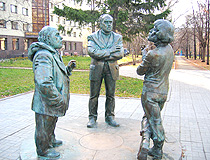
Sculpture of talking townspeople in Yekaterinburg
Author: Pichugin Mikhail
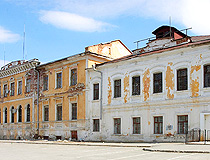
Old buildings in Yekaterinburg
Author: Andrew Golovin
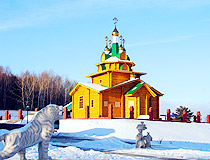
Wooden Church of the Holy Martyr Arkady in Yekaterinburg
Author: Kutenyov Vladimir
Street transport of Yekaterinburg
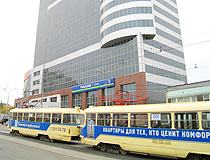
Tram in Yekaterinburg
Author: Andrey Permyakov
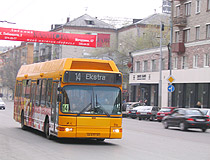
Bus in Yekaterinburg
Author: Per Heitmann
The questions of our visitors
All 5 questions
The comments of our visitors
Rating: 3.1 /5 (286 votes cast)
Yekaterinburg
| |
|---|
| |
| and the from |
| |
| |
| Show map of Russia Show map of Sverdlovsk Oblast |
| Coordinates: 60°36′46″E / 56.83556°N 60.61278°E / 56.83556; 60.61278 |
| Country | |
|---|
| | |
|---|
| Founded | 18 November 1723 |
|---|
| City status since | 1781 |
|---|
| Government |
|---|
| • Body | |
|---|
| • Head | Alexey Orlov |
|---|
| Area |
|---|
| • Total | 1,111 km (429 sq mi) |
|---|
| Elevation | 237 m (778 ft) |
|---|
| Population ( Census) |
|---|
| • Total | 1,349,772 |
|---|
| • Estimate | 1,536,183 |
|---|
| • Rank | in 2010 |
|---|
| • Density | 1,200/km (3,100/sq mi) |
|---|
| |
|---|
| • Subordinated to | of Yekaterinburg |
|---|
| • of | , City of Yekaterinburg |
|---|
| |
|---|
| • Urban okrug | Yekaterinburg Urban Okrug |
|---|
| • of | Yekaterinburg Urban Okrug |
|---|
| | ( ) |
|---|
| | |
|---|
| | +7 343 |
|---|
| ID | 65701000001 |
|---|
| City Day | 3rd Saturday of August |
|---|
| Website | |
|---|
Yekaterinburg [lower-alpha 1] is a city and the administrative centre of Sverdlovsk Oblast and the Ural Federal District , Russia. The city is located on the Iset River between the Volga-Ural region and Siberia , with a population of roughly 1.5 million residents, [14] up to 2.2 million residents in the urban agglomeration. Yekaterinburg is the fourth-largest city in Russia, the largest city in the Ural Federal District, and one of Russia's main cultural and industrial centres. Yekaterinburg has been dubbed the "Third capital of Russia", as it is ranked third by the size of its economy, culture, transportation and tourism. [15] [16] [17] [18]
Imperial era
Contemporary era, demographics, administrative districts, administration, living costs and the labor market, finance and business, retail and services, transportation, public transit, media and telecommunications, life and culture, architecture, international relations, bric summit, twin towns – sister cities, notable people, bibliography, external links.
Yekaterinburg was founded on 18 November 1723 and named after the Orthodox name of Catherine I (born Marta Helena Skowrońska), the wife of Russian Emperor Peter the Great . The city served as the mining capital of the Russian Empire as well as a strategic connection between Europe and Asia. In 1781, Catherine the Great gave Yekaterinburg the status of a district town of Perm Province , and built the historical Siberian Route through the city. [3] Yekaterinburg became a key city to Siberia, which had rich resources. In the late 19th century, Yekaterinburg became one of the centres of revolutionary movements in the Urals. In 1924, after the Russian SFSR founded the Soviet Union , the city was renamed Sverdlovsk after the Bolshevik leader Yakov Sverdlov . During the Soviet era, Sverdlovsk was turned into an industrial and administrative powerhouse. On 23 September 1991 the city returned to its historical name.
Yekaterinburg is one of Russia's most important economic centres and was one of the host cities of the 2018 FIFA World Cup . The city is currently experiencing an economic and population boom, which resulted in some of the tallest skyscrapers of Russia being located in the city. Yekaterinburg is home to the headquarters of the Central Military District of the Russian Armed Forces , as well as the presidium of the Ural Branch of the Russian Academy of Sciences .
Yekaterinburg is famous for its constructivist architecture [19] [20] [21] and is also considered the "Russian capital of street art ". [22] [23] [24]

The area was settled in prehistory. The earliest settlements date to 8000–7000 BC, in the Mesolithic period . The Isetskoe Pravoberezhnoye I archaeological site contains a Neolithic settlement dated to 6000–5000 BC. It includes stone processing workshops with artefacts such as grinding plates, anvils, clumps of rock, tools, and finished products. Over 50 different types of rock and minerals were used in tool making, indicating extensive knowledge of the region's natural resources. The Gamayun peninsula (left bank of the Verkh-Isetsky Pond) has archaeological findings from the Chalcolithic Period : workshops for producing stone tools (upper area) and two dwellings of the Ayat culture (lower area). There are also traces of the Koptyak culture from 2000 BC: dishes decorated with bird images and evidence of metallurgical production. The Tent I site contains the only Koptyak culture burials discovered in the Ural Mountains . In the Bronze Age , the people of Gamayun culture lived in the area. They left fragments of ceramics, weapons, and ornaments. [25] [26] [27]
Archaeological artifacts in the vicinity of Yekaterinburg were first discovered during railway construction, at the end of the 19th century. Excavation and research began in the 20th century. Artifacts are held at the Sverdlovsk Regional Museum of Local Lore , at the Hermitage , at the Museum of Anthropology and Ethnography of the Academy of Sciences, and at other museums. [26]

The first Russian settlements within the boundaries of modern Yekaterinburg appeared in the second half of the 17th century — in 1672, an Old Believers village arose in the area of Shartash lake [28] (this fact is disputed by historians, since no evidence of the founding of the village at that time was found in the sources), [29] and in 1680 – 1682, the villages of Nizhny and Verkhny Uktus appeared on the banks of Uktus River (now the territory of the Chkalovsky district of the city). [30] In 1702, by the initiative of the head of Sibirskiy prikaz Andrew Vinius , the Uktus state ironwork plant was founded near Nizhny Uktus — the first ironworks within the boundaries of modern Yekaterinburg. [31] In 1704, the Shuvakish ironworks was built (now the territory of the Zheleznodorozhny district of the city). [28] With the beginning of active construction of factories in the Urals in the 18th century, relations with their southern neighbors, the Bashkirs , became strained. As a result of the Bashkir raid in 1709, the village of Verkhny Uktus was devastated, all buildings, including the wooden church and chapel, were burned, the residents fled to the protection of the Uktus plant fortifications. [30] On the night of 5 April 1718, a fire destroyed all the factory buildings of the Uktus plant, except for the dam, and the plant was restored only by 1720 under the supervision of Timofey Burtsev. [32] However, the plant did not receive further development due to the lack of water in Uktus river.
In 1720, by decree of Peter I , a delegation led by mining specialist Johann Blüher and statesman Vasily Tatishchev was sent to the Urals . [33] They were entrusted with managing the mining industry, identifying the causes of the collapse and reduction of production at state-owned factories. [33] On 29 December 1720, [33] Tatishchev and Blüher arrive at the Uktus plant, which became their main residence in the Urals. As a result of familiarizing himself with the state of nearby state-owned factories, Tatishchev came to the conclusion that on the basis of these factories, even if they were reconstructed and expanded, it would not be possible to quickly increase the production of iron, and it would be more profitable to build a new large plant. After inspecting the immediate area, together with the commissary of the Uktus plant, Timofey Burtsev, a place rich in ore and forest was chosen on the banks of the more full-flowing Iset River , 7 versts from Uktus. [33] On 6 February 1721, Tatishchev sent a message to the Collegium of Mining , in which he asked permission to begin construction of the plant, with detailed explanations and justification for this project. [33] On 1 March 1721, without waiting for a response from the Collegium, Tatishchev began construction of the new plant, [28] but he failed to convince Collegium, and by the Collegium decree of 10 December 1721, he was removed from the leadership of mining affairs in the Urals. [28] In 1722, by decree of Peter the Great, a mining engineer, Major General Georg Wilhelm de Gennin , was sent to the Urals in place of Tatishchev. Having studied all the circumstances, de Gennin fully supported Tatishchev’s project, and on 12 March 1723, construction of the plant on Iset resumed. [28]
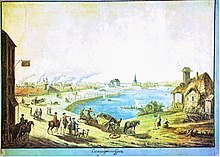
Russian historian Vasily Tatishchev and Russian engineer Georg Wilhelm de Gennin founded Yekaterinburg with the construction of a massive iron-making plant under the decree of Russian emperor Peter the Great in 1723. [34] They named the city after the emperor's wife, Yekaterina, who later became empress regnant Catherine I . [2] Officially, the city's founding date is 18 November 1723, when the shops carried out a test run of the bloomery for trip hammers. [2] The plant was commissioned 6 days later, on 24 November. [35] 1723 also saw the establishment of Yekaterinburg fortress , which would encompass many of the settlement's earliest buildings. Dmitry Mamin-Sibiryak very vividly described the beginning of the construction of a mining plant and a fortress: "Imagine completely deserted banks of the Iset river, covered with forest. In the spring of 1723, soldiers from Tobolsk, peasants of the assigned settlements, hired craftsmen appeared, and everything around came to life, as if by the dictates of a fairy tale. They dropped the forest, prepared a place for the dam, laid blast furnaces, raised the rampart, set up barracks and houses for the authorities... ". [36]
In 1722–1726 the Verkhne-Uktussky mining plant was built, [37] which was officially called the plant of the princess Elizabeth (the future village of Elizabeth, or Elizavetinskoe) and became a part of modern Yekaterinburg in 1934. [38] In 1726, Wilhelm de Gennin founded an auxiliary Verkh-Isetsky plant with a working settlement 2 versts from Yekaterinburg upstream ('verkh' in Russian) the Iset River. [39] The plant's dam formed the Verkh-Isetsky pond. Colloquially called by the Russian acronym VIZ, it was a satellite town until in 1926, with a population of over 20,000 people by this time, it was incorporated into Yekaterinburg as the core of the Verkh-Isetsky district. [39]

Yekaterinburg was one of the industrial cities of Russia prompted at the beginning of the 18th century by decrees of Tsar Peter the Great which demanded the development of the metalworking industry. With extensive use of iron, the city was built to a regular square plan with ironworks and residential buildings at the centre. These were surrounded by fortified walls so that Yekaterinburg was at the same time both a manufacturing centre and a fortress at the frontier between Europe and Asia. It, therefore, found itself at the heart of Russia's strategy for further development of the entire Ural region. The so-called Siberian Route became operational in 1763 and placed the city on an increasingly important transit route, which led to its development as a focus of trade and commerce between east and west, and gave rise to the description of the city as the "window to Asia". With the growth in trade and the city's administrative importance, the ironworks became less critical, and the more important buildings were increasingly built using expensive stone. Small manufacturing and trading businesses proliferated. In 1781 Russia's empress, Catherine the Great, granted Yekaterinburg town status and nominated it as the administrative centre for the wider region within Perm Governorate . [3] In 1807, the role of the capital of the mining and smelting region was confirmed by assigning it the status of the only "mountain city" in Russia. Until 1863, Yekaterinburg remained subordinate to the head of the mining plants of the Ural ridge , the minister of finance and personally to the emperor, and enjoyed considerable freedom from the governor's power. Since the 1830s, mountainous Yekaterinburg has become the center of mechanical engineering. [36]

In 1820–1845, 45% of the world's gold was mined in Yekaterinburg. This is the first ever "Gold Rush". [40] Until 1876, 80% of the coins in circulation in the Russian Empire were produced at the Yekaterinburg mint. [41]
Following the October Revolution , the family of deposed Tsar Nicholas II was sent to internal exile in Yekaterinburg where they were imprisoned in the Ipatiev House in the city. In July 1918, the Czechoslovak Legions were closing on Yekaterinburg. In the early hours of the morning of 17 July, the deposed Tsar, his wife Alexandra , and their children Grand Duchesses Olga , Tatiana , Maria , Anastasia , and Tsarevich Alexei were murdered by the Bolsheviks at the Ipatiev House. Other members of the Romanov family were killed at Alapayevsk later the same day. The Legions arrived less than a week later and captured the city. [42] [43] The city remained under the control of the White movement in which a provisional government was established. The Red Army took back the city and restored Soviet authority on 14 July 1919. [44] [45]

In the years following the Russian Revolution and the Russian Civil War , political authority of the Urals was transferred from Perm to Yekaterinburg. On 19 October 1920, Yekaterinburg established its first university, the Ural State University , as well as polytechnic, pedagogical, and medical institutions under the decree of Soviet leader Vladimir Lenin . Enterprises in the city ravaged by the war were nationalised, including: the Metalist (formerly Yates) Plant, the Verkh-Isetsky (formerly Yakovleva) Plant, and the Lenin flax-spinning factory (formerly Makarov). In 1924, the city of Yekaterinburg was renamed Sverdlovsk after the Bolshevik leader Yakov Sverdlov . [46] [28] [44]
By the 1934, following a series of administrative reforms carried by the early Soviet government, the earliest Russian settlements which predated Yekaterinburg and laid the basis of its founding, were incorporated into the city proper. [38] [47]
During the reign of Stalin, Sverdlovsk was one of several places developed by the Soviet government as a centre of heavy industry. Old factories were reconstructed and new large factories were built, especially those specialised in machine-building and metalworking. These plants included Magnitogorsk and the Chelyabinsk Tractor Plant in Chelyabinsk oblast , and Uralmash in Sverdlovsk. During this time, the population of Sverdlovsk tripled in size, and it became one of the fastest-growing cities of the Soviet Union. At that time, very large powers were given to the regional authorities. By the end of the 1930s, there were 140 industrial enterprises, 25 research institutes, and 12 higher education institutions in Sverdlovsk. [48] [49]
During World War II, the city became the headquarters of the Ural Military District on the basis of which more than 500 different military units and formations were formed, including the 22nd Army and the Ural Volunteer Tank Corps. Uralmash became the main production site for armoured vehicles. Many state technical institutions and whole factories were relocated to Sverdlovsk away from cities affected by war (mostly Moscow), with many of them staying in Sverdlovsk after the victory. The Hermitage Museum collections were also partly evacuated from Leningrad to Sverdlovsk in July 1941 and remained there until October 1945. [50] In the postwar years, new industrial and agricultural enterprises were put into operation and massive housing construction began. [51] [44] The lookalike five-story apartment blocks that remain today in Kirovsky, Chkalovsky, and other residential areas of Sverdlovsk sprang up in the 1960s, under the direction of Nikita Khrushchev 's government. [52] In 1977, Ipatiev House was demolished by order of Boris Yeltsin in accordance to a resolution from the Politburo in order to prevent it from being used as a rallying location for monarchists . Yeltsin later became the first President of Russia and represented the people at the funeral of the former Tsar in 1998. [53] There was an anthrax outbreak in Sverdlovsk in April and May 1979, which was attributed to a release from the Sverdlovsk-19 military facility . [54]
During the 1991 coup d'état attempt , Sverdlovsk, the home city of President Boris Yeltsin, was selected by him as a temporary reserve capital for the Russian Federation, in case Moscow became too dangerous for the Russian government. A reserve cabinet headed by Oleg Lobov was sent to the city, where Yeltsin enjoyed strong popular support at that time. [55] Shortly after the failure of the coup and subsequent dissolution of the Soviet Union, the city regained its historical name of Yekaterinburg on 23 September 1991. However, Sverdlovsk Oblast, of which Yekaterinburg is the administrative centre, kept its name. [56] [57]
In the 2000s, an intensive growth of trade, business, and tourism began in Yekaterinburg. In 2003, Russian President Vladimir Putin and German Chancellor Gerhard Schröder negotiated in Yekaterinburg. On 15–17 June 2009, the SCO and BRIC summits were held in Yekaterinburg, which greatly improved the economic, cultural, and tourist situation in the city. On 13–16 July 2010, a meeting between Russian President Dmitry Medvedev and German Chancellor Angela Merkel took place in the city. [58]
In 2018, Yekaterinburg hosted four matches of the 2018 FIFA World Cup and hosted the inaugural University International Sports Festival in 2023. [59]

Geographically, Yekaterinburg is in North Asia, close to the Ural Mountains (which divide Europe from Asia), 1,667 km (1,036 mi) east of the nation's capital Moscow.
The city has a total area of 1,111 km 2 (429 sq mi) .
Yekaterinburg is on the eastern side of the Urals. The city is surrounded by wooded hills, partially cultivated for agricultural purposes. Yekaterinburg is located on a natural watershed, so there would be many bodies of water close and in the city. The city is bisected by the Iset River , which flows from the Urals into the Tobol River . There are two lakes in the city, Lake Shuvakish and Lake Shartash. The city borders Verkh-Isetskiy Pond, through which the Iset River flows. Lake Isetskoye and Lake Baltym are both near the city, with Lake Isetskoye located near Sredneuralsk , and Lake Baltym located near the towns of Sanatornyy and Baltym.
Yekaterinburg uses the Yekaterinburg Time, which is five hours ahead of UTC (UTC+5), and two hours ahead of Moscow Time . [60]
The city possesses a humid continental climate ( Dfb ) under the Köppen climate classification . [61] It is characterised by sharp variability in weather conditions, with well-marked seasons. The Ural Mountains, despite their insignificant height, block air from the west, from the European part of Russia. As a result, the Central Urals are open to the invasion of cold arctic air and continental air from the West Siberian Plain. Equally, warm air masses from the Caspian Sea and the deserts of Central Asia can freely penetrate from the south. Therefore, the weather in Yekaterinburg is characterised by sharp temperature fluctuations and weather anomalies: in winter, from frost at −40 °C to thaw and rain; in summer, from frosts to temperatures above 35 °C (95 °F) . [61]
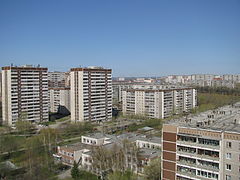
The distribution of precipitation is determined by the circulation of air masses, relief, and air temperatures. The main part of the precipitation is brought by cyclones with a western air mass transfer, that is, from the European part of Russia, while their average annual amount is 601 mm. The maximum falls on a warm season, during which about 60–70% of the annual amount falls. For the winter period is characterized by snow cover with an average capacity of 40–50 cm. The coefficient of moistening(the ratio of yearly precipitation and potential evaporation ) – 1. [61]
- The average temperature in January is −12.6 °C (9.3 °F) . The record minimum temperature is −44.6 °C (−48.3 °F) (6 January 1915);
- The average July temperature is 18.9 °C (66.0 °F) . The record maximum temperature is 40.0 °C (104.0 °F) (11 July 2023);
- The average annual temperature is 2.1 °C (35.8 °F) ;
- The average annual wind speed is 2.9 m/s (10 km/h; 6.5 mph) ;
- The average annual humidity is 75%;
- The average annual precipitation is 534 mm (21.0 in) ;
| Climate data for Yekaterinburg (1991–2020, extremes 1831–present) |
|---|
| Month | Jan | Feb | Mar | Apr | May | Jun | Jul | Aug | Sep | Oct | Nov | Dec | Year |
|---|
| Record high °C (°F) | 5.6
(42.1) | 9.4
(48.9) | 18.1
(64.6) | 28.8
(83.8) | 34.7
(94.5) | 36.4
(97.5) | 40.0
(104.0) | 37.2
(99.0) | 31.9
(89.4) | 24.7
(76.5) | 13.5
(56.3) | 5.9
(42.6) | 40.0
(104.0) |
|---|
| Mean daily maximum °C (°F) | −9.3
(15.3) | −6.6
(20.1) | 0.9
(33.6) | 10.1
(50.2) | 18.3
(64.9) | 22.6
(72.7) | 24.3
(75.7) | 21.4
(70.5) | 15.0
(59.0) | 6.9
(44.4) | −2.6
(27.3) | −7.8
(18.0) | 7.8
(46.0) |
|---|
| Daily mean °C (°F) | −12.6
(9.3) | −10.8
(12.6) | −3.6
(25.5) | 4.7
(40.5) | 12.2
(54.0) | 16.9
(62.4) | 18.9
(66.0) | 16.2
(61.2) | 10.4
(50.7) | 3.6
(38.5) | −5.4
(22.3) | −10.7
(12.7) | 3.3
(37.9) |
|---|
| Mean daily minimum °C (°F) | −15.5
(4.1) | −14.1
(6.6) | −7.3
(18.9) | 0.3
(32.5) | 6.9
(44.4) | 12.0
(53.6) | 14.4
(57.9) | 12.2
(54.0) | 6.8
(44.2) | 1.0
(33.8) | −7.8
(18.0) | −13.3
(8.1) | −0.4
(31.3) |
|---|
| Record low °C (°F) | −44.6
(−48.3) | −42.4
(−44.3) | −39.2
(−38.6) | −21.8
(−7.2) | −13.5
(7.7) | −5.3
(22.5) | 1.5
(34.7) | −2.2
(28.0) | −9.0
(15.8) | −22.0
(−7.6) | −39.2
(−38.6) | −44.0
(−47.2) | −44.6
(−48.3) |
|---|
| Average mm (inches) | 25
(1.0) | 19
(0.7) | 25
(1.0) | 31
(1.2) | 47
(1.9) | 73
(2.9) | 93
(3.7) | 75
(3.0) | 45
(1.8) | 41
(1.6) | 33
(1.3) | 28
(1.1) | 534
(21.0) |
|---|
| Average extreme snow depth cm (inches) | 33
(13) | 42
(17) | 38
(15) | 5
(2.0) | 0
(0) | 0
(0) | 0
(0) | 0
(0) | 0
(0) | 1
(0.4) | 8
(3.1) | 21
(8.3) | 42
(17) |
|---|
| Average rainy days | 1 | 1 | 5 | 13 | 20 | 20 | 19 | 22 | 22 | 17 | 6 | 1 | 147 |
|---|
| Average snowy days | 26 | 23 | 18 | 10 | 4 | 0.4 | 0 | 0 | 2 | 13 | 23 | 25 | 144 |
|---|
| Average (%) | 79 | 75 | 68 | 60 | 58 | 63 | 68 | 73 | 75 | 75 | 78 | 79 | 71 |
|---|
| Mean monthly | 47 | 94 | 164 | 206 | 256 | 272 | 269 | 217 | 143 | 78 | 51 | 37 | 1,834 |
|---|
| Source 1: Pogoda.ru |
| Source 2: NOAA (sun 1961–1990) |
Historical population| Year | | |
|---|
| 1897 | 37,399 | — |
|---|
| 1926 | 134,831 | +260.5% |
|---|
| 1939 | 425,533 | +215.6% |
|---|
| 1959 | 778,602 | +83.0% |
|---|
| 1970 | 1,025,045 | +31.7% |
|---|
| 1979 | 1,211,172 | +18.2% |
|---|
| 1989 | 1,364,621 | +12.7% |
|---|
| 2002 | 1,293,537 | −5.2% |
|---|
| 2010 | 1,349,772 | +4.3% |
|---|
| 2021 | 1,544,376 | +14.4% |
|---|
According to the results of the 2021 Census , the population of Yekaterinburg was 1,544,376 ; [64] up from 1,349,772 recorded in the 2010 Census . [7]
As of 2021, the ethnic composition of Yekaterinburg was: [65]
| Ethnicity | Population | Percentage |
|---|
| | 1,172,704 | 91.0% |
| | 27,431 | 2.1% |
| | 13,102 | 1.0% |
| | 8,769 | 0.7% |
| | 6,121 | 0.5% |
| | 4,987 | 0.4% |
| | 4,755 | 0.4% |
| | 4,307 | 0.3% |
| | 4,014 | 0.3% |
| Others | 42,033 | 3.3% |

Christianity is the predominant religion in the city, of which most are adherents to the Russian Orthodox Church. The Yekaterinburg and Verkhotursky diocese is located in the Holy Trinity Cathedral in the city. Other religions practised in Yekaterinburg include Islam , Old Believers , Catholicism , Protestantism , and Judaism .
Yekaterinburg has a significant Muslim community, but it suffers from a lack of worship space: there are only two small mosques . Another mosque was built in the nearby city of Verkhnyaya Pyshma . On 24 November 2007, the first stone was laid in the construction of a large Cathedral Mosque with four minarets , and space for 2,500 parishioners in the immediate vicinity of the cathedral and a synagogue , thus forming the "area of the three religions". [66] The mosque was planned to be built for the SCO summit, but due to funding problems, construction did not move from zero and is now frozen.
Construction of a Methodist church started in 1992, and with the help of American donations, finished in 2001. [67] A synagogue was opened in 2005, on the same place a 19th-century synagogue was demolished in 1962.
Most of the city's religious buildings were destroyed during the Soviet era, in addition to the synagogue, the three largest Orthodox churches in Yekaterinburg were demolished – the Epiphany Cathedral, the Ekaterininsky Cathedral, and the Great Zlatoust Church . Other Christian churches such as the Lutheran Church of Yekaterinburg and the Roman Catholic Church of St. Anne (a new Catholic St. Anne's Church was built in 2000) were demolished as well. Other churches were used as warehouses and industrial sites. The only religious building in Yekaterinburg in the Soviet era was the Cathedral of St. John the Baptist. Recently, some churches are being rebuilt. Since 2006, according to the surviving drawings, the Great Zlatoust Church was restored in 2012. On 17 April 2010, the city was visited by Patriarch Kirill . [68]
Yekaterinburg is the administrative centre of Sverdlovsk Oblast . [1] Within the framework of the administrative divisions , it is, together with twenty-nine rural localities , incorporated as the City of Yekaterinburg, [9] an administrative unit with the status equal to that of the districts . [1] As a municipal division, the City of Yekaterinburg is incorporated as Yekaterinburg Urban Okrug. [10]
| Administrative districts of Yekaterinburg |
|---|
| |
| Label | | Name | Area (2019) | Population (2019) | Founded | Head | Website | Dialing code(s) | Subdivisions |
|---|
| 1 | | Akademicheskiy | | 81,000 | 2020 | Smirnyagin Nikolai Sergeevich | | +7 3432, +7 3433 | 3 |
|---|
| 2 | | Verkh-Isetsky | 240 square kilometres (93 sq mi) | 221,207 | 1919 | Morozov Andrey Mikhailovich | 1 December 2021 at the | +7 3432, +7 3433 | 5 |
|---|
| 3 | | Zheleznodorozhnyy | 126.3 square kilometres (48.8 sq mi) | 221,207 | 1938 | Pershin Vitaly Pavlovich | 1 March 2022 at the | +7 343 | 8 |
|---|
| 4 | | Kirovsky | 72 square kilometres (28 sq mi) | 228,864 | 1943 | Bolikov Vladimir Yurievich | 15 March 2022 at the | +7 343 | 7 |
|---|
| 5 | | Leninsky | 25 square kilometres (9.7 sq mi) | 156,723 | 1934 | Beruashvili Elena Zauryevna | 15 March 2022 at the | +7 343 | 3 |
|---|
| 6 | | Oktyabrsky | 157 square kilometres (61 sq mi) | 148,981 | 1934 | Kostenko Igor Vitalievich | 10 November 2021 at the | +7 3432 | 11 |
|---|
| 7 | | Ordzhonikidzevsky | 102 square kilometres (39 sq mi) | 286,482 | 1934 | Kravchenko Roman Gennadievich | 16 March 2022 at the | +7 3433 | 6 |
|---|
| 8 | | Chkalovsky | 402 square kilometres (155 sq mi) | 275,571 | 1943 | Shipitsyn Evgeny Viktorovich | 9 May 2019 at the | +7 3432 | 10 |
|---|
Each district is not a municipal formation, and the historical centre of the city is divided into five inner-city districts (except Chkalovsky and Ordzhonikidzevsky).
A district named Akademicheskiy was formed from the parts of Leninsky and Verkh-Isetsky districts on 3 January 2020. [70] On 1 October 2021, more settlements were transferred from Verkh-Isetsky to Akademicheskiy district. [71]
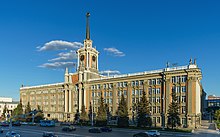
The Charter of Yekaterinburg establishes a four-link system for the organisation of local authorities, which includes: the Head of Yekaterinburg, who serves as the chairman of the Yekaterinburg City Duma, the Yekaterinburg City Duma, the Administration of the City of Yekaterinburg, and the Chamber of Accounts. [74]
According to the charter of Yekaterinburg, the highest official of the municipal formation is the mayor of Yekaterinburg. The mayor is elected by universal suffrage, but since 3 April 2018, the procedure for direct elections of the mayor of the City of Yekaterinburg was abolished. The mayor of the city is endowed with representative powers and powers to organize activities and guide the activities of the City Duma. In addition, the mayor of the city exercises other powers such as concluding a contract with the head of the city administration and ensuring compliance with the Russian Constitution, Russian legislation, the city charter, and other normative acts. [75] [76]
In the event of a temporary absence of the mayor of Yekaterinburg, his authority under his written order is exercised by the deputy mayor of Yekaterinburg. [77]
The representative body of the municipal formation is the Yekaterinburg City Duma, which represents the city's entire population. The membership of the Duma is 36 deputies (18 deputies were elected in single-mandate constituencies and 18 in a single electoral district). Residents of the city elect deputies on the basis of universal suffrage for a period of 5 years. [74]
The executive and administrative body of the municipal formation is the Administration of the City of Yekaterinburg, led by the head of the Administration, currently held by Aleksandr Yacob. The administration is endowed with its own powers to resolve issues of local importance, but it is under the control and accountable to the Yekaterinburg City Duma. The building of the Administration of Yekaterinburg is located on 1905 Square . [76]
The Chamber of Accounts is a permanently operating body of external municipal financial control. The Chamber is formed by the apparatus of the City Duma and is accountable to it. The Chamber consists of the chairman, deputy chairman, auditors and staff. The structure and number of staff of the chamber, including the number of auditors, is determined by the decision of the City Duma. The term of office of the Chamber staff is 5 years. The Chamber of Accounts is a legal entity. [77]

In accordance with the regional charter, Yekaterinburg is the administrative centre of the Sverdlovsk Oblast. [1] The executive power is exercised by the governor of Sverdlovsk Oblast, the legislative power by the legislative assembly of Sverdlovsk Oblast, and the judicial power by the Sverdlovsk Regional Court, located in the building of the Palace of Justice. [78] The building serving the regional government is the White House and the building serving the legislative assembly is located next to it on October Square. The ministries of the Sverdlovsk Region are located in the building of the regional government, as well as in other separate buildings of the city. [79]
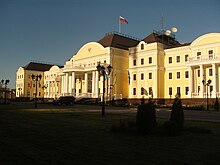
Yekaterinburg serves as the centre of the Ural Federal District. As a result, it serves as the residence of the presidential envoy , the highest official of the district and part of the administration of the President of Russia. The residence is located the building of the regional government on October Square near the Iset River embankment.

In addition, Yekaterinburg serves as the centre of the Central Military District and more than 30 territorial branches of the federal executive bodies, whose jurisdiction extends not only to Sverdlovsk Oblast, but also to other regions in the Ural Mountains, Siberia, and the Volga Region.
According to the results of the September 2013 elections, the mayor of the city was Yevgeny Roizman , nominated by the Civil Platform party. Out of the 36 seats in the City Duma, 21 belong to United Russia , 7 to A Just Russia , 3 to the Civil Platform, 2 to the Communist Party and 1 seat to the LDPR . The turnout in the mayoral elections was 33.57%. [80]
Russian federal legislative election, 2016 | | | 78,289 | 38.4% | |
| | | 31,288 | 15.4% | |
| | | 25,869 | 12.7% | |
| | | 22,293 | 10.9% | |
| | | 11,340 | 5.6% | |
| Party | Candidate | Votes | % | ±% |
|---|
It was the last popular vote in Yekaterinburg. Since 2018, there have been no elections, but a vote in the Municipal Duma. On 25 September 2018 the majority of the representatives in the Duma voted in favour of the Vice-Governor of Sverdlovsk oblast, Alexander Vysokinskiy.
Yekaterinburg is one of the largest economic centres in Russia. It is included in the City-600 list (it unites the 600 largest cities in the world that produce 60% of global GDP), compiled by the McKinsey Global Institute, a research organisation. In 2010, the consulting company estimated the gross product of Yekaterinburg to be about $19 billion (according to the calculations of the company, it should grow to $40 billion by 2025). [82] [83]
By volume of the economy, Yekaterinburg ranks third in the country, after Moscow and St. Petersburg. According to a research of the Institute for Urban Economics, in the ranking of the largest cities and regional capital cities according to economic standards for 2015, Yekaterinburg ranked third. The city's gross urban product (GVP) was 898 billion rubles. Per capita GDP was 621.0 thousand rubles (18th place). [84] In 2015, the gross urban product of the Yekaterinburg metropolitan area amounted to 50.7 billion international dollars (the fourth place in the country) or 25.4 thousand international dollars in terms of per inhabitant of the metropolitan area. [85]
In the Soviet era, Yekaterinburg (as Sverdlovsk) was a purely industrial city, with a share of industry in the economy of 90% (of which 90% were in defense production). With Chelyabinsk and Perm, the three cities formed what to be the Urals industrial hub. [86]
The former head of Yekaterinburg, Arkady Chernetsky, has set the goal of diversifying the city's economy, which has resulted in the development of sectors such as warehousing, transportation, logistics, telecommunications, financial sector, wholesale and retail trade, etc. in Yekaterinburg. [86] Economist-geographer Natalia Zubarevich points out that at the present stage, Yekaterinburg has practically lost its industrial specialisation. [87]
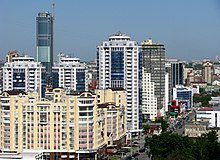
The standard of living in Yekaterinburg exceeds the average standard across Russia. According to the Department of Sociology of the Financial University under the Government of the Russian Federation, it is among the top ten cities with the highest standard of living. Compared to other Russian cities with a population of around or over one million, in 2015, Yekaterinburg held a leading position in terms of average monthly wages and retail turnover, in terms of the total volume of investments in fourth place of fixed assets, and second place in housing placement. [88] [89]

The average monthly wage in Yekaterinburg following the results of 2019 was 54,976 rubles. This is the first place among the millionth municipalities of the Russian Federation. [90] There are on average 440,300 people employed by large and middle-sized organisations and companies. The unemployment rate at the end of 2015 was 0.83% of the total economically active population. Locals labelled the main problems of the city such the current state of the healthcare system, housing system, and transportation system. [89] [91]
The budget of Yekaterinburg in 2015 was executed on income in the amount of 32,063.6 million rubles, for expenses in the amount of 32,745.8 million rubles. Among the budget expenditures: 17 billion rubles were spent on education, over 1 billion rubles on culture, and about 900 million rubles on health. The main part of the revenue of the city treasury was its own tax and non-tax revenues (more than 18 billion rubles). The revenues from the regional and federal budgets were at the lowest level in 10 years. Specialists noted a decrease in tax revenues and an increase in tax debt (exceeded 2 billion rubles). [89] [92]
The main budget expenditures are the development of the economy (which accounts for 19% of expenditures) and the social security of the townspeople (11% of expenditures go). Cities such as Perm, Kazan and Ufa, spend for these purposes in a smaller percentage of costs (from 2 to 6%). Also, a fairly strict budgetary discipline is noted—the budget deficit is kept at the level of 2% of its volume. [93]

Yekaterinburg is one of the largest financial and business centres in Russia, with offices of multinational corporations, representative offices of foreign companies, and a large number of federal and regional financial and credit organisations. The financial market of Yekaterinburg is characterised by stability and independence, based both on the broad presence of large foreign and Moscow credit organisations and on the availability of large and stable local financial holdings. [94]
The financial sector of Yekaterinburg has more than 100 banks, including 11 foreign banks. The list of the largest Russian banks for assets for 2016 included 10 banks registered in Yekaterinburg, including but not all: Ural Bank for Reconstruction and Development, SKB-Bank, Uraltransbank, and UM Bank. [95] [96]
IT "SKB Kontur" from Yekaterinburg – the largest software manufacturer in Russia – first place according to the RAEX rating [97]
Also in Yekaterinburg is the Ural headquarters of the Central Bank of Russia. Since 7 August 2017, by order of the Bank of Russia, the branches of the Siberian, Far Eastern and part of the Prevolzhsky Federal Districts have been transferred to the control of the Ural Megaregal Directorate. Thus, this is one of the three main departments of the Mega-regulator in the territory of Russia. [98]
A major role in the formation of Yekaterinburg as a business centre has its infrastructural potential, which is growing at a high rate: transport accessibility for Russian and foreign economic entities, the availability of hotels, advanced communication services, business related services (consulting, exhibition activities, etc.). [94] Yekaterinburg has its own central business district, Yekaterinburg City. [99]
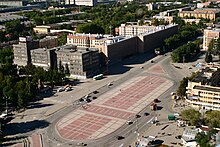
Yekaterinburg has been a major industrial centre since its foundation. In the 18th century, the main branches were smelting and processing of metal. Since the beginning of the 19th century, machine building appeared, and in the second half of the 19th century, light and food (especially milling) industry was widely spread. A new stage in the development of production occurred during the period of industrialisation – at this time in the city, factories were built, which determined the industry specialisation of heavy engineering. During World War II, Yekaterinburg (as Sverdlovsk) hosted about sixty enterprises evacuated from Central Russia and Ukraine. As a result, there was a sharp increase in the production capacity of existing plants and the emergence of new branches of the Urals industry.
At present, more than 220 large and medium-sized enterprises are registered in Yekaterinburg, 197 of them in manufacturing industries. [94] In 2015, they shipped 323,288 million rubles worth of own-produced goods. Production by industry was divided accordingly: metallurgical production and metalworking 20.9%, food production 13.3%, production of electrical equipment, electronic and optical equipment 9.2%, production of vehicles 8.4%, production of machinery and equipment 6.4%, chemical production 5.5%, production of other nonmetallic mineral products 3.7%, production of rubber and plastic products 2.8%, pulp and paper production, publishing and printing 0.5%, and other 29.3%. [100]
Several headquarters of large Russian industrial companies are located in the city: IDGC of Urals, Enel Russia, Steel-Industrial Company, Russian Copper Company, Kalina, NLMK-Sort, VIZ-Stal, Sinara Group, Uralelectrotyazhmash, Automation Association named after academician NA Semikhatov, Ural Heavy Machinery Plant (Uralmash), Fat Plant, Fores, confectionery association Sladko, Machine Building Plant named after M.I. Kalinin, Ural Turbine Plant, Uralkhimmash and others. [101]

Yekaterinburg ranks first in retail trade of the Russian Federation per capita, ahead of Moscow. [102] The consumer market contributes significantly to Yekaterinburg's economy. Revenue of retail stores in 2015 amounted to 725.9 billion rubles, and the number of retailers totaled 4,290. [103] As of 1 January 2016, 36 shopping centers operate in the city, taking up a total area of which was 1,502,700 m 2 (16,175,000 sq ft) . The availability of shopping centres per 1,000 inhabitants increased to 597.2 m 2 (6,428 sq ft) . [104]
Retail areas amounted to 2,019,000 m 2 (21,730,000 sq ft) , with the availability of retail space reached 1,366.3 m 2 (14,707 sq ft) per 1,000 inhabitants. According to these statistics, Yekaterinburg holds leading positions among other major cities of Russia. In the consumer market of Yekaterinburg, 1041 network operators are represented. The number of wholesale enterprises totalled 1,435. Among the Federal construction stores represented in the city, you can select: Leroy Merlin, [105] Castorama, [106] Domostroy, [107] Maxidom, [108] OBI, [109] Sdvor. [110] Yekaterinburg has an agricultural market named Shartashsky. [104] [111]
The revenue of catering in 2015 totalled 38.6 billion rubles. The network of catering enterprises in Yekaterinburg is presented as follows: 153 restaurants, 210 bars, 445 cafes, 100 coffee houses, 582 dining rooms, 189 eateries, 173 fast-food establishments, 10 tea shops, 319 other types of institutions (buffets, cafeterias, catering companies). 82.6% of catering enterprises provide additional services to consumers. [112]
The revenue of the services industry in 2015 totalled 74.9 billion rubles. The fastest pace in the city is developing hairdressing services, sewing and knitting atelier services, pawnshop services, fitness centre services. The network of public service enterprises in Yekaterinburg includes 5,185 facilities. In 2015, the provision of service areas for service enterprises totaled 382.1 m 2 (4,113 sq ft) per 1,000 citizens. The highest concentration of household services is observed in the Verkh-Isetsky, Oktyabrsky and Leninsky districts. [113]
Greenwich Shopping Center, as of 2021, is the largest shopping center in Europe. [114]
The largest store in the world by area is Sima-Land. [115]
Yekaterinburg is a major centre for the Russian tourist industry. In 2015, the city was one of the top five most visited Russian cities (others being Moscow, St. Petersburg, Novosibirsk , and Vladivostok ) according to the Global Destinations Cities Index, which represents the payment system Mastercard . [116] In recent years, a lot of work has been done to create a positive image of Yekaterinburg as a centre for international tourism, including holding of summits for the Shanghai Cooperation Organisation (SCO) in 2008 and 2009 and the international exhibition Innoprom in 2009 and 2010. [117] In 2014, Yekaterinburg ranked third among Russian cities in popularity among foreign tourists after Moscow and St. Petersburg. [118]
In 2015, the total flow of inbound tourism grew by 10% compared to the previous year and amounted to 2.1 million people. [119] In recent years, there has been a tendency to reduce the role of business tourism in the overall flow: if in 2013 about 80% of trips were business, in 2015 their number was already 67%. Most tourists go to "bow to the memory of the last [czar] and his family." In addition, new tourist ideas are developing such as the Bazhov theme, the geological and mineralogical theme, industrial tourism, and the event calendar. [120]
Yekaterinburg is the third largest transport hub of Russia, behind Moscow and St. Petersburg. The city has 6 federal highways, 7 main railway lines, and an international airport. The location of Yekaterinburg in the central part of the region allows for 7 to 10 hours to get from it to any large city of the Urals. [121] The formation of Yekaterinburg as an important transportation hub is largely due to the city's favourable geographical location on a low stretch of the Ural Mountains, through which it was convenient to lay the main roads connecting the European and Eastern parts of Russia. [122]

Yekaterinburg is one of the ten Russian megacities with the largest car fleet (0.437 megacars were registered in the city in 2014), which has been intensively increasing in recent years (by 6–14% annually). [123] [124] The level of car ownership in 2015 has reached 410 cars per 1,000 people. [125] Its pace in the past few years has seriously exceeded the pace of development and the capacity of the road infrastructure. For the first time, transport problems started to appear in Yekaterinburg in the 1980s and though it did not seem threatening at first, the situation gets worse every year. Studies have shown that as early as 2005, the capacity limit for the road network was reached, which has now led to permanent congestion. [126] To increase the capacity of the street-road network, stage-by-stage reconstruction of streets is being carried out, as well as multi-level interchanges being built. In order to reduce the transit traffic, the Sverdlovsk Oblast administration announced two road projects in 2014: the Yekaterinburg Ring Road (EKAD) and an overpass road on Sovetskaya Street. The Yekaterinburg Ring Road would surround the largest municipalities of Yekaterinburg. Its purpose would be to help the city's economy and reduce traffic on the Middle Ring Road of the city, making it easier for civilians to commute around the city than going through the city's traffic congestion. Eventually, the Ring Road would connect to other federal roads in order for easier access between other Russian cities. Construction of the road started in the same year. The projects were assigned to the Ministry of Transport and Communications since the projects were crucial to the city's economy. Officials hope the road projects will build environments more conducive to improving local quality of life and outside investments. Completing these major inter-regional roads will increase productive traffic by 50% to 100%, improving the local economy with its ease of access to industries. [127]
Since 2014, the project for the introduction of paid parking in the central part of Yekaterinburg is being implemented. The project is implemented in parallel with the increase in the number of intercepting parking lots and the construction of parking lots. At the end of 2015, in the central part of the city there were 2,307 paid parking places. [125]
The total length of the road network in Yekaterinburg is 1,311.5 km (814.9 mi) , of which 929.8 km (577.8 mi) is cobbled carriageways, 880 km (550 mi) is with upgraded coverage, 632 km (393 mi) is backbone networks, of which 155 km (96 mi) are on the citywide backbone network movement. 20 interchanges have been constructed at different levels within the city limits, including 11 on the EKAD and 9 on the middle ring. 74 transport facilities (27 bridges across the Iset River, Patrushikha, Mostovka, Istok Rivers, 13 dams on the Iset, Patrushikha, Istok, Olkhovka, Warm, Shilovka Rivers, 23 road overpasses , and 18 out-of-the-way pedestrian crossings) were built as well. [128]
Yekaterinburg is served by the following highways: [129]

Yekaterinburg uses almost all types of public transport. The largest transportation services—the Municipal Association of Bus Enterprises, the Tram-Trolleybus Office, and the Yekaterinburg Metro —transported 207.4 million people in 2015. [130] The total volume of passenger transportation by all land transport modes decreases annually. If the annual passenger traffic of municipal transport was 647.1 million people in 2002, and according to this index the city occupied the third place in the country with a wide margin, then in 2008 this figure would be 412 million people (the fourth place in Russia). [131] [132]

Since 1991, the city operates the sixth metro in Russia and the thirteenth in the CIS . At the moment there is one line with 9 stations. In 2015 49.9 million passengers were transported; according to this metric the Yekaterinburg Metro is the fourth in Russia, behind the Moscow Metro, Saint Petersburg Metro, and Novosibirsk Metro . [133] Although the metro is the second most popular type of public transport, in recent years significant problems have appeared in its work: loss-making, obsolete rolling stock, and a shortage of funds for modernisation. [134] The tram network was established in 1929 and currently [ when? ] plays a leading role in the urban transport system. The volume of passengers carried for 2013 is 127.8 million, [135] but this declines every year (245 million people in 2013 [136] ). In 2016 there were 30 routes operating 459 cars. The total length of the tracks is 185.5 km. As of 2016 [ update ] , the construction of a tram line "Ekaterinburg-Verkhnyaya Pyshma" was planned. [137]

There are 93 bus routes operating in Yekaterinburg, including 30 municipal ones (EMUP "MOAP"). [138] In 2007, 114.5 million passengers were transported by municipal intercity buses (124.6 million in 2006). [139] The decrease in volume is due to the increasing role of the fixed-route taxis in the urban transport system of Yekaterinburg, as well as the high cost of travel. However, the city bus transport network provides significant employment for the people of Ekaterinburg, including the formidable babushkas who collect passenger fares. In the park of EMPU, there are 537 buses. [140] In 2013, there are 19 routes, which employ 250 trolleybuses. The total length of trolleybus lines is 168.4 km. The number of passengers transported by trolleybus in 2007 amounted to 78.4 million (84.3 million in 2006). [139]
In addition, the city operates an electric train route linking the north-western and the southern parts of Yekaterinburg, from Sem' Klyuchey to Elizavet.
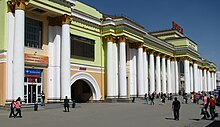
Yekaterinburg is a major railway junction. In the Yekaterinburg node, 7 main lines converge (to Perm , Tyumen , Kazan , Nizhny Tagil , Chelyabinsk , Kurgan , and Tavda ). The Sverdlovsk Railway Administration is located in the city, which serves trains on the territory of the Sverdlovsk and Tyumen Regions, the Perm Territory, the Khanty-Mansiysk and Yamalo-Nenets Autonomous Districts, as well as parts of the Omsk Region, and there is a single road traffic control centre. The Perm–Yekaterinburg–Tyumen section is now part of the main route of the Trans-Siberian Railway .
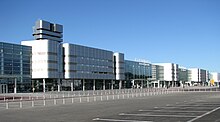
Yekaterinburg is served by two primary airports: Koltsovo International Airport (SVX) and the smaller Yekaterinburg Aramil Airport . Koltsovo Airport is one of the largest airports in the country, serving 5.404 million passengers (including 3.485 million serviced by domestic airlines, 1.919 million at international flights) in 2017, making it the sixth busiest airport in Russia . [141]

Yekaterinburg has an extensive network of municipal, regional and federal health facilities. There are 54 hospitals, designed at a capacity of 18,200 beds, [142] 272 ambulatory polyclinics, and 156 dental clinics and offices. [143] Some health facilities are based on medical research institutes such as the Research Institute of Phthisiopulmonology, [144] the Research Institute of Dermatology and Immunopathology, [145] and the Ural State Medical University, as well as others.
In clean areas of the city, there is the Yekaterinburg Medical Centre, which includes the Sverdlovsk Regional Clinical Hospital No. 1 (also includes a polyclinic and a boarding house), Central City Hospital No. 40 (polyclinic, therapeutic building, surgical building, infectious body, neuro-surgical building, maternity hospital), Regional Cardiology Centre, Centre for Prevention and Control of AIDS, and MNTK Eye Microsurgery. [146]
Other large medical centres are the Uralmash Health Centre (Hospital No. 14), the Hospital of veterans of the Great Patriotic War, the district hospital of the Ministry of Internal Affairs, the district military hospital, the Oncology Centre, the Sverdlovsk Oblast Psychiatric Hospital, the Disaster Medicine Centre, the Sanguis Blood Transfusion Centre, children's versatile hospital No. 9, and the regional rehabilitation centre on Chusovsky lake. There are about 300 pharmacies in the city. [143] The number of doctors in public medical institutions is 11,339 people (83.9 per 10,000 people) and the number of nurses is 16,795 (124 per 10,000 people).
Private medical institutions also operate in the city. [147]

Yekaterinburg's education system includes institutions of all grades and conditions: preschool, general, special (correctional), and vocational (secondary and higher education), as well as others. Today, the city is one of the largest educational centres of Russia, with Yekaterinburg considered to be the leading educational and scientific centre of the Urals . [148]

There are 164 educational institutions in Yekaterinburg: 160 of them operate in the morning and the other 4 in the evening. In 2015, 133,800 people were enrolled in general education institutions, which holds a capacity of 173,161 people. [149] Yekaterinburg's education system also includes state pre-school educational institutions, non-state pre-school institutions, out-of-town health camps, and municipal city health facilities with a one-day stay. [150] Five educational institutions of the city: SUNC UrFU, Gymnasium No. 2, Gymnasium No. 9, Gymnasium No. 35, and Lyceum No. 135, were included in the rating of the five hundred best schools in the country by the Moscow Center for Continuous Mathematical Education and the Ministry of Education and Science of the Russian Federation . [151]
On 16 July 1914, the Ural Mining Institute of Emperor Nicholas II (now the Ural State Mining University ) was established as Yekaterinburg's first educational institution. [152] In 1930, the Sverdlovsk Power Engineering College (now the Ural Technical Institute of Communications and Informatics) was opened to train specialists in the field of communications. The Alexei Maximovich Gorky Ural State University (now the Ural Federal University ) became the first university in Yekaterinburg by decree of the Council of People's Commissars of the RSFSR , signed by Vladimir Lenin on 19 October 1920. The Sverdlovsk Engineering and Pedagogical Institute (today the Russian State Vocational and Pedagogical University) became the first university of the USSR for the training of engineering and pedagogical personnel when it was opened in 1979.

In terms of the level of qualification of the graduates, Yekaterinburg's universities are among the leading in Russia, in particular in terms of the number of graduates representing the current managing elite of the country, Yekaterinburg universities are second only to the educational institutions of Moscow and Saint Petersburg. [153] [154] Currently, there are 20 state universities in the city, which currently holds a total of 140,000 students. [155] In addition, there are 14 non-state institutions of higher education in the city, such as the Yekaterinburg Academy of Contemporary Art and the Yekaterinburg Theological Seminary. The prestigious architecture school, the Ural State Academy of Architecture and Arts , is also located within the city limits. Other institutions of higher education Ural State Pedagogical University, Ural State University of Forestry, Ural State University of Railway Transport, Ural State University of Economics, Military Institute of Artillery, Ural State Conservatory , Ural State Agricultural Academy, Ural State Law Academy , Ural State Medical University, Ural State Academy of Performing Arts, Ural Academy of Public Service, and Institute of International Relations .
In May 2011, the Ural State University and Ural State Technical University merged to form the Boris N. Yeltsin Ural Federal University , making it the largest university in the Urals and the largest university in Russia. As of 1 January 2016, the university had 35,300 students and 2,950 teachers. The university's budget in 2015 totalled 9,1 billion rubles and the volume of research and development work totalled 1,6 billion rubles. [156] As of 2021, UrFU is the largest university in Russia in terms of the number of students, being on the 351st place in the QS World University Rankings. [157] [158] The number of publications of the university in the Web of Science database is about a thousand per year. [159]
There are many branches of non-resident universities in the city, including the Ural branch of the Siberian State University of Telecommunications and Informatics, the Ural branch of the Russian Academy of Private Law, the Yekaterinburg branch of the Plekhanov Russian Economic Academy, the Yekaterinburg branch of the University of the Russian Academy of Education, the Yekaterinburg branch of the Moscow State University, and Sholokhov Humanitarian University, as well as others.

In Yekaterinburg, a large number of print publications are published: about 200 newspapers, the most read being the Ural Worker , Vecherny Yekaterinburg , Oblastnaya Gazeta , and For Change! , and 70 magazines, with most read being Red Burda and I'm Buying . [160] [161]
A television studio was built in Yekaterinburg (as Sverdlovsk) in 1955 and on 6 November of the same year, the first telecast appeared. Coloured television later appeared in 1976. [162] Now the television is broadcast by 19 companies, including but not all: STRC Ural, Channel Four, 41 Home, Channel 10, OTV, Union (Orthodox), and UFO 24. Broadcasting is carried out from the TV tower on Lunacharsky street (television studio GTRK Ural), the TV tower on the Moskovskiy Hill, and from the TV tower (radio relay tower) on Blyukher Street. In 1981, construction of a new television tower was started, which was to become the second tallest in Russia after the Ostankino Tower and cover the territory of most of the Sverdlovsk region, but economic difficulties postponed construction. As a result, the television tower was the tallest uncompleted structure in the world. On 24 March 2018, the television tower was demolished by detonation for the city's beautification in preparation of the 2018 FIFA World Cup . [163] The Shartash radio mast, which broadcasts, is the tallest structure in the city, with a height of 263 meters. [164] In addition, several dozens of national and local news agencies are broadcast in Yekaterinburg, with the most watched being ITAR-TASS Ural, RUIA-Ural, and Interfax-Ural.
At the moment [ when? ] , there are 26 internet providers and 6 cellular operators in the city. [165] According to Yekaterinburg News , the city has signed a cooperative agreement with the Russian mobile operator Vimpelcom , working under the Beeline brand. The partnership will involve cooperation on investment projects and social programmes focused on increasing access to mobile services in the city. Beeline has launched an initiative to provide Wi-Fi services in 500 public trams and trolley buses in Yekaterinburg. [166]
Operators of mobile communication in Yekaterinburg| Generation | Mobile communication standard | Operators |
|---|
| | | , , , , Motive |
| | | MTS, MegaFon, Beeline, Tele2 Russia, Motive |
| | | MTS, MegaFon, Beeline, Tele2 Russia, Motive |
| | , | MTS, MegaFon, Beeline, Tele2 Russia |
| | | MTS, MegaFon, Beeline, Tele2 Russia |
| | | MTS, MegaFon, Beeline, Tele2 Russia |
| | | MTS, MegaFon, Beeline, Tele2 Russia, Motive, |
| | | MTS, MegaFon, Beeline, |

Yekaterinburg is a multipurpose cultural centre of the Urals Federal District. [148] There are about fifty libraries in the city. The largest library organisations are the Sverdlovsk Oblast Universal Scientific Library, the V.G. Belinsky Scientific Library, which is the largest public library in Sverdlovsk Oblast, and the Municipal Library Association, which is composed of 41 libraries throughout the city, including the AI Herzen Central City Library. [167]
There are about 50 different museums in the city. [168] Yekaterinburg has unique museum collections, such as the collections of Russian paintings in the Yekaterinburg Museum of Fine Arts and the Nevyansk icons in the Nevyansk Icon Museum , with more than 300 icons representing the eighteenth through the twentieth centuries on display. There is also a unique exhibit, the Kaslinsky cast iron pavilion, which received main awards at the 1900 World Exhibition in Paris. The Kasli Pavilion was registered by UNESCO as the only cast-iron architectural structure in the world, which is in the museum collection. [169] Museums of the city also have collections of jewellery and stone ornaments. The United Museum of Writers of the Urals presents exhibitions in memory of writers such as Dmitry Mamin-Sibiryak and Pavel Bazhov . It also is the home of the Shigirskaya Kladovaya ( Шигирская кладовая ), or Shigir Collection, which includes the oldest known wooden sculpture in the world. The sculpture was found near Nevyansk and originally estimated to have been made approximately 9,500 years ago, but now is estimated to have been made 11,500 years ago. [170] Yekaterinburg museums annually participate in the international event Long Night of Museums .
Yekaterinburg has the third most theatres in Russia. [171] The influence of theatrical life of the city was made by the Moscow Art Academic Theater and the Central Theater of the Soviet Army when they evacuated to Yekaterinburg (as Sverdlovsk) during World War II, and they had their own theater in the city. [172] Notable theatres that operate in the city are Academic Theater of Musical Comedy, Drama Theater, Kolyada-Theater , the youth theatre, and the puppet theatre, as well as others. The Yekaterinburg Opera and Ballet Theater received four awards at the Golden Mask 2020 Festival in Moscow, including the main Golden Mask for the Best Opera Performance [173]
In 2014, the city showcased its education, literary, art, and theatre culture through the Russian Year of Culture Programme. [174]
The city has a well-developed film industry. Opened back in 1909, Laurage was the first cinema in Yekaterinburg. In 1943, the Sverdlovsk Film Studio was opened and produced its first feature film Silva a year later. After the Second World War, the studio produced up to ten feature films a year. There are more than 20 cinemas in Yekaterinburg, the oldest of which is the Salyut, while the most capacious is the Cosmos spacecraft. [175] [176] There are also chains of movie theatres such as Premier-Zal, Kinomaks, and Kinoplex, which usually open in shopping and entertainment centres.
A number of popular Russian rock bands, such as Urfin Dzhyus, Chaif , Chicherina , Nautilus Pompilius , Nastya, Trek, Agata Kristi , Slaughter to Prevail and Smyslovye Gallyutsinatsii , were originally formed in Yekaterinburg ( Ural Rock is often considered as a particular variety of rock music. Yekaterinburg and St. Petersburg are actually considered to be the main centres of the genre in Russia). Also, opera singers like Boris Shtokolov , Yuri Gulyayev , Vera Bayeva graduated from the Urals State Conservatory. The Ural Philharmonic Orchestra (currently conducted by Dmitry Liss ), founded by Mark Paverman and located in Yekaterinburg, is also very popular in Russia and in Europe, as well as the Ural Academic Popular Chorus, a folk-singing and dance ensemble. [ citation needed ]
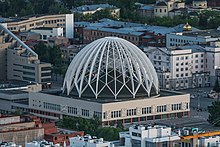
Yekaterinburg V. I. Filatov State Circus is located in the centre of the city, on the western bank of the Iset River. In 2012, the Yekaterinburg Circus was nominated "Best Circus of the Year" for the circus show Sharivari by the Rosgoscirk and the Ministry of Culture . [177]
The Presidential Center named after Boris Yeltsin was built in Yekaterinburg in 2015. It is considered to be a public, cultural and educational center. Center has its art gallery, library, museum equipped with the newest multimedia technologies that help to present the documents, video materials and archive photos. In 2017, the Yeltsin Center was recognized as the best museum in Europe by the Council of Europe, the first of the museums in Russia. [178]
The Urals Society of Natural Science Lovers pushed Yekaterinburg to have a zoo. Currently, the zoo has more than 1,000 animals that belong to more than 350 species. The zoo covers an area of 2.7 hectares.
On 18 June 2011, Yekaterinburg launched Red Line as a pedestrian tourist route for self-guided tours by residents and visitors to go to 34 landmarks in the historical section of the city. [179]

Many buildings of Yekaterinburg are ranged from a different number of architectural styles. The city had a regular layout, based on the fortresses of the Renaissance and by the principles of French town planning during the 17th century. By the 18th century, the Baroque movement was not that influential in Yekaterinburg, with the style being seen in churches which later declined [180]
In the first half of the 19th century, neoclassicism grew influential in the Yekaterinburg's architecture. The estates were built in the neoclassic style, including the main house, wings, services, and often an English-style park. This style's influence in Yekaterinburg is mostly due to the contributions of architect Michael Malakhov, who worked in the city from 1815 to 1842. He designed the assemblies of the Verkhne-Isetsky factory as well as the Novo-Tikhvinsky Monastery. [180]
At the beginning of the 20th century, eclecticism became a dominant influence in Yekaterinburg's architecture. Buildings such as the Opera House and Yekaterinburg railway station were built in this style. During the 1920s and the 1930s, constructivism took effect, influencing residential complexes, industrial buildings, stadiums, etc. Architects Moses Ginzburg, Jacob Kornfeld, the Vesnina brothers, Daniel Friedman, and Sigismund Dombrovsky contributed greatly to the constructivism in the city. More than 140 structures in Yekaterinburg are designed through the constructivist style. [181]

During the 1930s to 1950s, there was a turn back to neoclassicism, with much attention paid to public buildings and monuments. Notable examples include the buildings of the Ural Industrial Institute on Lenin Avenue, the City Party Committee and the City Council Executive Committee building (now the City Administrative building), the District Officers' House, and the House of Defense complex. Cultural buildings are built in the squares in orderly composition. In these years, architects Golubev, K. T. Babykin, Valenkov worked fruitfully in Yekaterinburg with this style. In the 1960s, changes in the approach to construction led to widespread distribution of apartment blocks common in the Khrushchev era . Buildings built by individuals were rare, among them being: KKT "Kosmos", the Palace of Youth, and DK UZTM. [182]
From the 1960s to the 1980s, as industrial development grew in Yekaterinburg, so did rationalism . The situation changed in the 1990s when Russia transferred into a market economy. At that time, older buildings were restored, giving the urban area a new environment such as: the Cosmos Concert Hall, the Puppet Theater, the children's ballet theatre The Nutcracker, the Palace of Justice, the Cathedral of the Blood, and the Church of the Transfiguration . At the same time, the construction of new buildings was accompanied by the demolition of historical buildings, leading to the development of the "facade" phenomenon, where the facades of historic buildings are preserved while adjacent modern buildings are built. [183]
The centre of Yekaterinburg became the centre of new construction, where banks, business centres, hotels, luxury residential complexes, and sports and shopping centres were built. High-tech architecture grew influential, with buildings such as the Center for Railway Transportation Management, the Summit business centre, the Aquamarine residential complex, and the retail strip at Vaynera Street being notable examples. Along with this, postmodernism revived interest in the older architectural styles of Yekaterinburg, growing more emphasis on historicalism and contextualism. In the late 1990s, architects grew interested in regionalism . [183]
At the beginning of the 21st century, Yekaterinburg architects turned back to the Soviet-based avant-garde, and influence future city buildings with the neoconstructivist style. The practice of attracting large foreign investors to projects has become popular. In 2007, the construction of the Central business district started, being headed by the French architect Jean Pistre. [183] In 2010, Yekaterinburg became one of the largest centers for the construction of High-rise buildings. In the city, 1,189 high-rise buildings were built, including 20 skyscrapers, the tallest of which is the Iset Tower , with a height of 209 meters. [184]
Yekaterinburg is also a leading sports centre in Russia. A large number of well-known athletes, both world and Olympics champions, are associated with the city. Since 1952, Yekaterinburg athletes have won 137 medals at the Olympic Games (46 gold, 60 silver and 31 bronze). In the 2008 Summer Olympics , 8 residents of Yekaterinburg returned with medals (1 gold, 3 silver and 4 bronze). [185]

In 1965, Yekaterinburg (as Sverdlovsk), along with a number of Russian cities, hosted the Bandy World Championship . In 2018, Yekaterinburg was one of the 11 Russian cities that hosted the 2018 FIFA World Cup. The matches were played on the upgraded Yekaterinburg Arena (called Central Stadium before the World Cup). [186]
Yekaterinburg has a total of 1728 sports facilities, including 16 stadiums with stands, 440 indoor gyms and 45 swimming pools. There are 38 sports children's and youth schools for reserves for the Olympic Games, in which more than 30,000 people are participating. [187]
Sport clubs
Yekaterinburg has many professional sports clubs in sports such as volleyball, basketball, futsal , bandy , and ice hockey for both women and men. Bandy club SKA-Sverdlovsk , women's volleyball club VC Uralochka-NTMK , women's basketball club UMMC Yekaterinburg , and futsal club MFK Sinara Yekaterinburg were among the best teams in Russia and Europe.
| Club | Sport | Founded | Current League | League
Tier | Stadium |
|---|
| | | 1930 | | 1st | |
| | | 2006 | | 1st | |
| Avto Yekaterinburg | | 2009 | | Jr. 1st | |
| Spartak-Merkury | | 1992 | Women's Hockey Championship | 1st | Sports Palace Snezhinka |
| | | 1937 | | 1st | |
| | | 1935 | | 2nd | |
| | | 2006 | | 2nd | |
| | | 1938 | | 1st | |
| Lokomotiv-Izumrud Yekaterinburg | | 1945 | | 2nd | |
| | | 1966 | Women's Volleyball Superleague | 1st |
Metallurg-Forum |
| | | 1992 | | 1st | |
2018 FIFA World Cup

Yekaterinburg hosted four matches of the 2018 FIFA World Cup [59] Yekaterinburg is one of the 11 Russian cities that hosted the 2018 FIFA World Cup. The matches were played on the upgraded Yekaterinburg Arena . [186]
For the World Cup 2018, from 7 October 2015 to 29 December 2017, the Central Stadium was upgraded to bring it into compliance with FIFA requirements for the World Cup and was renamed Yekaterinburg Arena. The architectural concept of the new stadium is built on a combination of historical walls and the built-in core of the modern arena. During the reconstruction of the sports facility, which is a monument of history and culture, the facades are carefully preserved, and the arena itself is equipped with the latest technical achievements of the sports industry. Temporary stands extending outside the stadium's original perimeter were erected to comply with the FIFA requirement of seating for 35,000 spectators. They can hold a total of 12,000 spectators, but the seating will be removed after the World Cup, decreasing the seating capacity back to 23,000. [188] [189]
The FIFA Fan Fest in Yekaterinburg is located in the Mayakovsky Central Park of Entertainment and Culture. Located just outside the city centre in a popular and well-known amusement park, it will have a capacity to hold 17,000 people. [190]
Koltsovo Airport was also reconstructed and had a second runway built. In addition, work was done to prepare another passenger terminal, modernize the technical infrastructure, and launch the business aviation hangar. The airport's capacity in preparation for the World Cup has increased to two thousand people per hour. The street and road network was also upgraded. [191]
The United States, [192] United Kingdom, [193] Germany, [194] France, [195] China [196] and several other countries have consulates in Yekaterinburg.
The BRIC countries met for their first official summit on 16 June 2009, in Yekaterinburg, [197] with Luiz Inácio Lula da Silva , Dmitry Medvedev , Manmohan Singh , and Hu Jintao , the respective leaders of Brazil, Russia, India and China, all attending.
The foreign ministers of the BRIC countries had also met in Yekaterinburg previously on 16 May 2008.
In June 2013, at the 153rd General Assembly of the Bureau of International Expositions held in Paris, representatives from Yekaterinburg presented the city's bid to host the 2020 World Expo . Yekaterinburg's concept for the upcoming exhibition relates to the impact of globalisation on the modern world.
Russian President Vladimir Putin confirmed during a televised statement in English to earmark the required funds to build an exhibition complex large enough to receive the estimated 30 million visitors from more than 150 countries. [198]
Yekaterinburg later bid for the Expo 2025 . Yekaterinburg's concept for the bid exhibition relates to the technologies to make people happy by changing the world with innovation and quality of life. The host was announced on 23 November 2018 and Yekaterinburg lost out to Osaka, Japan.
Yekaterinburg hosted the Global Summit on Manufacturing and Industrialization (GMIS — 2019) GMIS under the auspices of the United Nations. [199] The annual INNOPROM exhibition is among the five largest industrial exhibitions in the world. [200]
Yekaterinburg is twinned with: [201]
- Anton Bakov , Leader of the Monarchist Party
- Irina Antonenko , Miss Russia 2010
- Aleksei Balabanov , film director, screenwriter, producer
- Vera Bazarova , pairs figure skater
- Pavel Bazhov , folklorist and children's author
- Old Man Bukashkin , artist and poet
- Pavel Datsyuk , ice hockey player
- Nikolay Durakov , bandy legend
- Chiang Fang-liang , former first lady of Taiwan
- Aleksey Fedorchenko , film director, producer
- Denis Galimzyanov , sprinter cyclist
- Anna Gavrilenko , Group rhythmic gymnast Olympic Gold medalist
- Nikolay Karpol , national women volleyball team coach
- Nikolai Khabibulin , ice hockey player
- Alexei Yashin , ice hockey player
- Alexei Khvostenko , avant-garde poet, singer-songwriter, artist, and sculptor
- Nikolay Kolyada , actor, director, writer, playwright, and playwriting teacher
- Ilya Kormiltsev , poet, translator, publisher
- Olga Kotlyarova , Olympic runner
- Maxim Kovtun , figure skater
- Vladislav Krapivin , children's author
- Valeria Savinykh , WTA Professional player
- Nikolay Krasovsky , mathematician
- Yulia Lipnitskaya , figure skater
- Iskander Makhmudov , businessman
- Vladimir Malakhov , ice hockey player
- Gennady Mesyats , vice-president of the Russian Academy of Sciences
- Maxim Miroshkin , pairs figure skater
- Vladimir Mulyavin (1941 – 2003), Belarusian musician and the founder of the folk-rock band Pesniary [202]
- Alfia Nazmutdinova , rhythmic gymnast
- Ernst Neizvestny , sculptor
- Oleg Platonov , writer, historian, and economist
- Daria Pridannikova , rhythmic gymnast
- Eduard Rossel , ex-governor of Sverdlovsk Oblast
- Boris Ryzhy , poet
- Mikhail Shchennikov , race walker
- Vera Sessina , rhythmic gymnast
- Georgy Shishkin , painter
- Vassily Sigarev , playwright, screenwriter, film director
- Anastasiia Tatareva , Group rhythmic gymnast Olympic Gold medalist
- Sergei Tchepikov , Olympic biathlon competitor
- Vladimir Tretyakov , ex-rector of the Ural State University
- Lev Vainshtein , Olympic shooter
- Sergei Vonsovsky , physicist
- Alexander Dudoladov , writer
- Alexander Malinin , singer
- Petr Yan , Former UFC Bantamweight Champion
- A ballistic missile submarine of the Project 667BDRM Delfin class ( NATO reporting name: Delta IV ) is named Ekaterinburg (K-84/"807") in honour of the city.
- The asteroid 27736 Ekaterinburg was named in the city's honour on 1 June 2007.
Related Research Articles
Sverdlovsk Oblast is a federal subject of Russia located in the Ural Federal District. Its administrative center is the city of Yekaterinburg, formerly known as Sverdlovsk. Its population is 4,268,998.

Irbit is a town in Sverdlovsk Oblast, Russia, located 203 kilometers (126 mi) from Yekaterinburg by train or 250 kilometers (160 mi) by car, on the right bank of the Nitsa. Population: 37,009 (2021 Census) ; 38,357 (2010 Census) ; 43,318 (2002 Census) ; 51,708 (1989 Soviet census) .
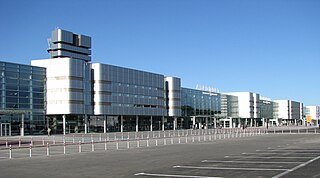
Koltsovo International Airport is the international airport serving Yekaterinburg, Russia, located 16 km (10 mi) southeast of the city. Being the largest airport in Sverdlovsk Oblast, Koltsovo also serves nearby towns such as Aramil, Sysert, and Polevskoy. In general, the airport is responsible for serving approximately 4,290,000 people yearly. The airport is a hub for Ural Airlines, RusLine and Aviacon Zitotrans. Due to its location in the center of Russia, Yekaterinburg's airport is included in the "Priority Airports" list of Russia's Federal Air Transport Agency (Rosaviatsia).

Serov is a mining and commercial town in Sverdlovsk Oblast, Russia, located on the eastern foothills of the Ural Mountains, on the left bank of the Kakva River, about 350 kilometers (220 mi) north of Yekaterinburg. Population: 99,373 (2010 Census) ; 99,804 (2002 Census) ; 104,158 (1989 Soviet census) .

Pervouralsk is a city in Sverdlovsk Oblast, Russia, located on the Chusovaya River 39 kilometers (24 mi) west of Yekaterinburg, the administrative center of the oblast. Population: 124,528 (2010 Census) ; 132,277 (2002 Census) ; 142,193 (1989 Soviet census) ; 122,000 (1974); 90,000 (1959); 44,000 (1939).

Sredneuralsk is a town under the administrative jurisdiction of the Town of Verkhnyaya Pyshma in Sverdlovsk Oblast, Russia, located on the shore of Iset Lake, at the head of the Iset River, 25 kilometers (16 mi) north of Yekaterinburg. Population: 20,449 (2010 Census) ; 19,555 ; 18,786 (1989 Soviet census) .

Anton Alekseyevich Bakov is a Russian businessman, monarchist politician, traveler, writer and human rights activist. He is the chairman of the Russian Monarchist Party, was a member of the 4th convocation of the State Duma of Russia from 2003 to 2007 and was a candidate at 2018 Russian presidential election. Due to being known for a long series of unusual political projects such as Ural franc, the writer Alexei Ivanov coined him a "political Leonardo".

Alexander Sergeevich Misharin is the former governor of Sverdlovsk Oblast, a region in Russia. He was appointed in 2009 after resignation of the previous governor, Eduard Rossel and resigned on May 14, 2012. Prior to his governorship, he made a career in the railway industry, rising to Russia's Deputy Railway Minister. He was appointed first vice-president of Russian Railways and head of Skorostniye Magistrali, the Russian high-speed rail developer and operator on November 28, 2012.

Isetsky District is an administrative district (raion), one of the twenty-two in Tyumen Oblast, Russia. As a municipal division, it is incorporated as Isetsky Municipal District . It is located in the west of the oblast. The area of the district is 2,751 square kilometers (1,062 sq mi). Its administrative center is the rural locality of Isetskoye. Population: 26,061 ; 26,565 (2002 Census) ; 25,862 (1989 Soviet census) . The population of Isetskoye accounts for 28.7% of the district's total population.

Gostiny Dvor – is a shopping (merchant) center in the historical center of Kamensk-Uralsky, Sverdlovsk oblast.

The Men's College building is a mansion in the historical center of Kamensk-Uralsky, Sverdlovsk oblast.

Zyryanov manor house is located in the historical center of Kamensk-Uralsky, Sverdlovsk oblast.

Church of the Intercession of the Most Holy Mother of God - is an Orthodox church in Kamensk-Uralsky, Sverdlovsk oblast.

Ural Aluminum Smelter Proletarian's Group of Houses is a complex of residential buildings in Kamensk-Uralsky, Sverdlovsk oblast.

The Rail Bridge over the Iset River - is an experimental bridge over the Iset River is a unique engineering structure made according to the advanced technology of the late 1930s in Kamensk-Uralsky, Sverdlovsk oblast.

Boris Yeltsin Street is a street in Yekaterinburg, Russia.
The coat of arms of Yekaterinburg is the official municipal coat of arms of Yekaterinburg, Russia. The current symbol was adopted on 23 May 2008 and consists of a French shield divided horizontally into two fields, with a white mine shaft and a white furnace within the top field, which is green, and a blue wavy bend within the bottom field, which is gold. A gold bear and gold sable are located to the left and right of the shield, respectively. A gold crown with a gold laurel wreath is located above the shield and a gold ribbon is located below the shield. A grey druse is located at the bottom center of the shield.
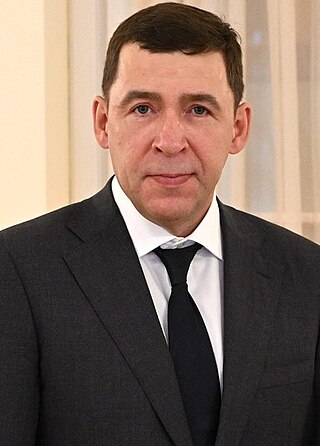
Yevgeny Vladmirovich Kuyvashev is a Russian politician serving as Governor of Sverdlovsk Oblast since 29 May 2012. He served as the acting governor from 14 May 2012 to 29 May 2012, and again from 17 April 2017 to 18 September 2017.

Alexander Leonidovich Burkov is a Russian politician who served as governor of Omsk Oblast from 2017 to 2023. He is a member of the Central Council of A Just Russia — For Truth party.
The 2022 Sverdlovsk Oblast gubernatorial election took place on 11 September 2022, on common election day. Governor Yevgeny Kuyvashev was re-elected for a third term.
- 1 2 3 4 5 6 Law #30-OZ
- 1 2 3 Haywood, A. J. (2010). Siberia: A Cultural History , Oxford University Press, p. 32
- ↑ Charter of Yekaterinburg, Article 24.1
- ↑ Official website of Yekaterinburg. Alexander Edmundovich Yakob, Head of Administration of the City of Yekaterinburg Archived 12 July 2015 at the Wayback Machine (in Russian)
- ↑ "Проект о внесении изменений в Генеральный план развития городского округа – муниципального образования «город Екатеринбург» на период до 2025 года" (in Russian). p. 168. [ permanent dead link ]
- 1 2 Federal State Statistics Service (21 May 2004). Численность населения России, субъектов Российской Федерации в составе федеральных округов, районов, городских поселений, сельских населённых пунктов – районных центров и сельских населённых пунктов с населением 3 тысячи и более человек [ Population of Russia, Its Federal Districts, Federal Subjects, Districts, Urban Localities, Rural Localities—Administrative Centers, and Rural Localities with Population of Over 3,000 ] (XLS) . Всероссийская перепись населения 2002 года [All-Russia Population Census of 2002] (in Russian).
- ↑ "Federal State Statistic Service" . Government of Russia. 1 January 2024 . Retrieved 6 June 2024 .
- 1 2 Государственный комитет Российской Федерации по статистике. Комитет Российской Федерации по стандартизации, метрологии и сертификации. №ОК 019-95 1 января 1997 г. « Общероссийский классификатор объектов административно-территориального деления. Код 65 401 », в ред. изменения №278/2015 от 1 января 2016 г.. (State Statistics Committee of the Russian Federation. Committee of the Russian Federation on Standardization, Metrology, and Certification. # OK 019-95 January 1, 1997 Russian Classification of Objects of Administrative Division (OKATO). Code 65 401 , as amended by the Amendment # 278/2015 of January 1, 2016. ).
- 1 2 3 Law #85-OZ
- ↑ "Об исчислении времени" . Официальный интернет-портал правовой информации (in Russian). 3 June 2011 . Retrieved 19 January 2019 .
- 1 2 "Срок регистрации домена закончился" . www.ekaterinburg.com . Archived from the original on 21 January 2013 . Retrieved 26 February 2022 .
- ↑ Upton, Clive ; Kretzschmar, William A. Jr. (2017). The Routledge Dictionary of Pronunciation for Current English (2nd ed.). Routledge. p. 1552. ISBN 978-1-138-12566-7 .
- ↑ "RUSSIA: Ural'skij Federal'nyj Okrug: Ural Federal District" . City Population.de . 4 August 2020 . Retrieved 2 October 2020 .
- ↑ "Рейтинг столичных городов России от Фонда "Институт экономики города" " . Urbaneconomics.ru .
- ↑ Kolossov, Vladimir; Eckert, Denis (1 January 2007). "Russian regional capitals as new international actors: the case of Yekaterinburg and Rostov" . Belgeo (1): 115–132. doi : 10.4000/belgeo.11686 .
- ↑ "Central Asian Chapter by Eurasian Respiratory and Allergy Consortium" . Era-cac.org . Archived from the original on 12 June 2018 . Retrieved 1 June 2018 .
- ↑ "Yekaterinburg - Entertainment - Russia.com" . Russia.com .
- ↑ "Конструктивизм. Жемчужина архитектуры Екатеринбурга" . www.e1.ru (in Russian). 16 January 2018 . Retrieved 21 December 2021 .
- ↑ "Как Екатеринбург за 10 лет стал столицей конструктивизма" . Strelka Mag (in Russian). Archived from the original on 5 March 2021 . Retrieved 21 December 2021 .
- ↑ Урал, Наш (19 May 2016). "Советская утопия: эпоха конструктивизма в Екатеринбурге" . Наш Урал (in Russian) . Retrieved 21 December 2021 .
- ↑ "Все кругом храпят, а Екатеринбург — пробужденный Когда уральский город объявил себя российской столицей стрит-арта, многие смеялись. А потом он стал ею" . Meduza (in Russian) . Retrieved 21 December 2021 .
- ↑ "Как Екатеринбург становится столицей стрит-арта" . Российская газета (in Russian). 16 April 2019 . Retrieved 21 December 2021 .
- ↑ "Екатеринбург – столица стрит-арта. Часть первая" . www.uralweb.ru (in Russian). Archived from the original on 3 March 2021 . Retrieved 21 December 2021 .
- ↑ "Памятникик археологии" . 1723.ru . Retrieved 20 May 2018 .
- 1 2 "1.2. Палкинские каменные палатки. Проект 1. | "Образование Урала" " . uraledu.ru (in Russian). Archived from the original on 5 April 2012 . Retrieved 20 May 2018 .
- ↑ ГАМАЮНСКАЯ КУЛЬТУРА – Уральская Историческая Энциклопедия . ural.ru (in Russian). Archived from the original on 22 July 2014 . Retrieved 20 May 2018 .
- 1 2 3 4 5 6 "Екатеринбург" . Геральдика Свердловской области . Официальный сайт областной думы законодательного собрания. Archived from the original on 8 March 2013 . Retrieved 6 December 2009 .
- ↑ Юрий, Коновалов (26 March 2004). "Первые русские поселения на реке Уктус" . www.okorneva.ru (in Russian) . Retrieved 7 June 2024 .
- 1 2 Кулешов, Николай (2001). "Горных заводов щит" . Домострой (4).
- ↑ Архипова, Нина (2001). "Тайны "превысочайшего Камня" ". Родина (11).
- ↑ Корепанов Н. С. Уктус — исток Екатеринбурга — Екатеринбург: Грачёв и партнёры, 2012. — 40 экз. — ISBN 978-5-91256-129-0
- 1 2 3 4 5 Юхт, Александр (1985). Государственная деятельность В. Н. Татищева в 20-е — начале 30-х годов XVIII века (in Russian). Moscow: Наука .
- ↑ "Библиотека истории: Ремесло историка в России – Бердинских В.А." history-library.com . Archived from the original on 1 April 2019 . Retrieved 20 May 2018 .
- ↑ Завод-крепость – История основания Екатеринбурга – Информационный портал Екатеринбурга . ekburg.ru (in Russian) . Retrieved 20 May 2018 .
- 1 2 "Основание Екатеринбурга" . Histrf.ru . Retrieved 20 February 2022 .
- ↑ Металлургические заводы Урала XVII—XX вв.: Энциклопедия / глав. ред. В. В. Алексеев. — Екатеринбург : Издательство «Академкнига», 2001.
- 1 2 ipravo.info. "О ликвидации Баженовского и Сысертского районов Уральской области и о расширении городской черты и пригородной зоны города Свердловска – Российский Правовой Портал" (in Russian). ipravo.info. Archived from the original on 19 June 2018 . Retrieved 19 June 2018 .
- 1 2 "History of the Verkh-Isetsky district" . Administration of Verkh-Isetsky district . Archived from the original on 16 December 2021 . Retrieved 7 June 2024 .
- ↑ "Золотой век Екатеринбурга" . Уралнаш. Интересно о Екатеринбурге . 9 October 2019. Archived from the original on 14 August 2021 . Retrieved 15 August 2021 .
- ↑ "50 интересных фактов об Екатеринбурге — Общенет" . obshe.net . Retrieved 15 August 2021 .
- ↑ Massie, Robert K. (22 February 2012). The Romanovs: The Final Chapter . Random House Publishing Group. ISBN 9780307873866 .
- ↑ "FSU News" . fsu.edu . Retrieved 15 May 2018 .
- 1 2 3 История Екатеринбурга – Информационный портал Екатеринбурга . ekburg.ru (in Russian) . Retrieved 20 May 2018 .
- ↑ "Временное Областное Правительство Урала – Энциклопедия Екатеринбурга – Энциклопедии & Словари" . enc-dic.com . Archived from the original on 20 May 2018 . Retrieved 20 May 2018 .
- ↑ Главная: НОВОСТИ . familii.ru (in Russian) . Retrieved 20 May 2018 .
- ↑ "Справочник по административно-территориальному делению Свердловской области" (PDF) . ГАСО (State Archive of the Sverdlovsk oblast). p. 37. Archived from the original (PDF) on 22 February 2017 . Retrieved 2 February 2013 .
- ↑ Rappaport, Helen (1999). Joseph Stalin: A Biographical Companion . ABC-CLIO. ISBN 978-1-57607-084-0 .
- ↑ Беркович Артём. "Пермь и Екатеринбург: история соперничества" . Муниципальный музей истории Екатеринбурга. Archived from the original on 25 May 2013 . Retrieved 16 December 2009 .
- ↑ In the name of Victory. Sverdlovsk-Yekaterinburg during the Great Patriotic War of 1941–1945 . 2005 – via Ekaterinburg: Institute of History and Archeology of the Ural Branch of the Russian Academy of Sciences.
- ↑ "Свердловск – 1983 год" . 1723.ru . Retrieved 20 May 2018 .
- ↑ "Интервью – АПИ-Урал" . apiural.ru . Retrieved 15 May 2018 .
- ↑ "President Yeltsin speaks about Tsar Murder" . BBC News . 17 July 1998 . Retrieved 4 April 2012 .
- ↑ Matthew S. Meselson, et al., "The Sverdlovsk Anthrax Outbreak of 1979", Science 266:5188 (18 November 1994): 1202–1208.
- ↑ Martin McCauley, "Who's who in Russia since 1900", Routledge , 1997: p.133.
- ↑ Ровно 18 лет назад Свердловск снова стал Екатеринбургом . Официальный портал Екатеринбурга (in Russian). Archived from the original on 16 April 2013 . Retrieved 15 May 2018 .
- ↑ "О возвращении городу Свердловску его исторического названия Екатеринбург, Указ Президиума Верховного Совета РСФСР от 23 сентября 1991 года №1674-1" . docs.cntd.ru . Retrieved 15 May 2018 .
- ↑ (www.dw.com), Deutsche Welle. "First BRIC summit concludes | DW | 16 June 2009" . DW.COM . Retrieved 20 May 2018 .
- 1 2 FIFA.com. "2018 FIFA World Cup Russia" . fifa.com . Archived from the original on 12 April 2014 . Retrieved 23 May 2018 .
- ↑ "Russia moves to year-round winter time" . BBC News . 22 July 2014 . Retrieved 20 May 2018 .
- 1 2 3 Грязнов Олег Николаевич; Гуляев Александр Николаевич; Рубан Наталья Валентиновна (2015). "Факторы инженерно-геологических условий города Екатеринбурга" . Izvestiia Uralʹskogo Gorno-Geologicheskoĭ Akademii (журнал) (3) (Известия Уральского государственного горного университета ed.). Екатеринбург: Федеральное государственное бюджетное образовательное учреждение высшего образования "Уральский государственный горный университет": 5–21. ISSN 2307-2091 .
- ↑ Погода и Климат – Климат Екатеринбург [ Weather and Climate – The Climate of Yekaterinburg ] (in Russian). Weather and Climate (Погода и климат) . Retrieved 8 November 2021 .
- ↑ "WMO Climate Normals for Sverdlovsk 1961–1990" . National Oceanic and Atmospheric Administration . Retrieved 29 October 2021 .
- ↑ Russian Federal State Statistics Service. Всероссийская перепись населения 2020 года. Том 1 [ 2020 All-Russian Population Census, vol. 1 ] (XLS) (in Russian). Federal State Statistics Service .
- ↑ "Национальный состав населения" (PDF) . Территориальный орган Федеральной службы государственной статистики по Свердловской области и Курганской области . Retrieved 7 June 2023 .
- ↑ "В Екатеринбурге заложили первый камень в основание соборной мечети – Уральская палата недвижимости" . upn.ru . Archived from the original on 10 October 2012 . Retrieved 5 October 2017 .
- ↑ "Четвертый канал" . channel4.ru . Archived from the original on 20 December 2010 . Retrieved 5 October 2017 .
- ↑ "Встреча Святейшего Патриарха Кирилла с общественностью Уральского федерального округа / Видеоматериалы / Патриархия.ru" . Патриархия.ru (in Russian) . Retrieved 18 October 2017 .
- ↑ "Устав Свердловской области (с изменениями на 7 декабря 2017 года), Устав Свердловской области от 23 декабря 2010 года №105-ОЗ, Закон Свердловской области от 23 декабря 2010 года №105-ОЗ" . docs.cntd.ru . Retrieved 2 May 2018 .
- 1 2 "Закон Свердловской области Губернатора Свердловской области № 141-ОЗ" . www.pravo.gov66.ru . Retrieved 12 March 2022 .
- 1 2 "Закон Свердловской области от 18.02.2021 № 9-ОЗ ∙ Официальное опубликование правовых актов ∙ Официальный интернет-портал правовой информации" . publication.pravo.gov.ru . Archived from the original on 12 March 2022 . Retrieved 12 March 2022 .
- 1 2 The population of the Russian Federation for municipalities as of 1 January 2019 Archived 16 October 2019 at the Wayback Machine (2 May 2019)
- ↑ "К 2023 году население Академического района вырастет до 120 тысяч человек" . Новый День (in Russian). 27 March 2019 . Retrieved 12 March 2022 .
- 1 2 "Chapter IV. Bodies and officials of local self-government of the municipality "city of Yekaterinburg" " . екатеринбург.рф . 25 July 2017. Archived from the original on 26 June 2016 . Retrieved 19 May 2018 .
- ↑ "Официальный интернет-портал правовой информации" . publication.pravo.gov.ru .
- 1 2 "Вы точно человек?" . КиберЛенинка . Retrieved 20 May 2018 .
- 1 2 "О внесении изменений в Устав муниципального образования "город Екатеринбург", Решение Екатеринбургской городской Думы Свердловской области от 12 октября 2010 года №62/29" . docs.cntd.ru .
- ↑ Article 42 of the Charter of Sverdlovsk Oblast
- ↑ "О ПРЕОБРАЗОВАНИИ И РЕОРГАНИЗАЦИИ АДМИНИСТРАЦИИ СВЕРДЛОВСКОЙ ОБЛАСТИ (с изменениями на: 06.02.1997), Постановление Правительства Свердловской области от 27 сентября 1995 года №13-П" . docs.cntd.ru .
- ↑ "Сведения о проводящихся выборах и референдумах" . sverdlovsk.vybory.izbirkom.ru . Archived from the original on 22 September 2013 . Retrieved 21 May 2018 .
- ↑ "Voting results for the Federal Electoral District – Election of Deputies of the State Duma of the Federal Assembly of the Russian Federation of the Seventh Convocation – September 18, 2016" . CEC. Archived from the original on 28 December 2016 . Retrieved 21 May 2018 .
- ↑ "Российские города отстают в развитии" . НИУ ВШЭ . 28 August 2014. Archived from the original on 5 February 2017 . Retrieved 7 July 2016 .
- ↑ "Urban world: Mapping the economic power of cities" . McKinsey Global Institute . March 2011. Archived from the original on 2 April 2024 . Retrieved 7 July 2016 .
- ↑ "Рейтинг столичных городов России от Фонда "Институт экономики города" | Институт экономики города" . urbaneconomics.ru . Retrieved 20 May 2018 .
- ↑ Economics of Russian cities and urban agglomeration , Institute for Urban Economics
- 1 2 Алексей Белоусов, Орнат Валентина. (13 October 2015). "Екатеринбург – глобальный город" . Мегаполис. Archived from the original on 27 August 2016 . Retrieved 7 July 2016 .
- ↑ Зубаревич Н.В. (2013). "Крупные города России: лидеры и аутсайдеры" (PDF) . Demoskop Weekly (журнал) (551–552) (Демоскоп Weekly ed.). М.: НИУ ВШЭ: 1–17. ISSN 1726-2887 .
- ↑ "Екатеринбург вошел в топ-10 городов с самым высоким уровнем жизни" . JustMedia . 17 December 2014 . Retrieved 14 May 2018 .
- 1 2 3 "Results of social and economic development of the municipal formation "city of Yekaterinburg" in 2015" . 2016. p. 202 – via Ekaterinburg: Department of Economics of the Administration of the City of Yekaterinburg.
- ↑ "Итоги социально-экономического развития Екатеринбурга" . Archived from the original on 2 December 2020 . Retrieved 19 October 2022 .
- ↑ Дарья Воронина. (19 June 2013). "Главными проблемами Екатеринбурга назвали медицину, ЖКХ и дороги" . Российская газета . Retrieved 7 July 2016 .
- ↑ Юлия Позднякова. (22 April 2016). "Расходы бюджета Екатеринбурга за 2015 год составили почти 33 млрд рублей" . Коммерсантъ . Retrieved 7 July 2016 .
- ↑ Полина Путякова. (30 August 2016). "Меряемся бюджетами: Откуда города берут деньги и на что тратят" . zvzda.ru. Archived from the original on 2 September 2016 . Retrieved 7 July 2016 .
- 1 2 3 Kachanova E.A. Strategic Priorities for the formation of finance for municipalities in the context of reforming the budgetary system Archived 15 December 2017 at the Wayback Machine , – Moscow: Russian Academy of National Economy and State Service under the President of the Russian Federation, 2013. – 354 p.
- ↑ Vyacheslav, Kostyuk (12 December 2014). "His alien" . The Ural Worker . Archived from the original on 10 April 2018 . Retrieved 20 May 2018 .
- ↑ "Крупнейшие банки России по капиталу" . Журнал "Коммерсантъ Деньги" . 25 July 2016. p. 60 . Retrieved 20 May 2018 .
- ↑ "Крупнейшие производители ПО" .
- ↑ "О распределении обязанностей по контролю и надзору за соблюдением законодательства Российской Федерации организациями, осуществляющими профессиональную деятельность на рынке ценных бумаг, деятельность центрального депозитария, деятельность по проведению организованных торгов, клиринговую деятельность и деятельность центрального контрагента, репозитарную деятельность, а также деятельность саморегулируемых организаций в сфере финансового рынка, объединяющих профессиональных участников рынка ценных бумаг, и об отмене отдельных распорядительных актов Банка России, Приказ Банка России от 07 августа 2017 года №ОД-2228" . docs.cntd.ru .
- ↑ "Падающие пиксели и огромный шар: как может выглядеть "Екатеринбург-Сити" " . РБК Недвижимость . 13 September 2016 . Retrieved 20 May 2018 .
- ↑ Development results, 2016 , pg 76
- ↑ "ТОП-100 крупнейших предприятий Свердловской области Екатеринбург" . Деловой квартал. 11 October 2011 . Retrieved 14 June 2016 .
- ↑ "ИТОГИ социально-экономического развития муниципального образования «город Екатеринбург» в 2019 году" . Archived from the original on 29 November 2020 . Retrieved 19 October 2022 .
- ↑ Development results, 2016 , p. 127–128
- 1 2 Development results, 2016 , p. 129
- ↑ "Леруа Мерлен" . Archived from the original on 18 October 2021 . Retrieved 27 April 2020 .
- ↑ "Castorama – строительный гипермаркет: купить товары для дома, дачи и ремонта" . Castorama.ru . Retrieved 20 February 2022 .
- ↑ "Домострой" . Archived from the original on 30 July 2019 . Retrieved 27 April 2020 .
- ↑ "Максидом - интернет-магазин товаров для дома" . www.maxidom.ru . Retrieved 20 February 2022 .
- ↑ "ОБИ строительный гипермаркет: товары для дачи, сада, дома и ремонта: каталог ОБИ" . Obi.ru . Retrieved 20 February 2022 .
- ↑ "Строительный Двор – интернет-магазин стройматериалов, купить с доставкой строительные материалы в магазинах сети" . Sdvor.com . Archived from the original on 13 May 2020 . Retrieved 20 February 2022 .
- ↑ Development results, 2016 , pg 130
- ↑ Development results, 2016 , pg 131–132
- ↑ Development results, 2016 , pg 133–135
- ↑ "Топ-20 самых больших торговых центров РФ" . marketmedia.ru (in Russian) . Retrieved 11 December 2021 .
- ↑ "Сима-Ленд" . 20 October 2016.
- ↑ Вячеславовна, Логунцова Ирина (2015). "Специфика и перспективы Российской индустрии туризма на современном этапе" . Государственное управление. Электронный вестник (52): 259–278.
- ↑ Геннадьевич, Шеломенцев Андрей; Сергеевна, Головина Анна (2011). "Индустрия туризма региона в контексте принципов саморегулирования региональных социально-экономических систем" . Экономика региона (1): 166–170. ISSN 2072-6414 .
- ↑ Екатеринбург поднялся на третье место в топе российских городов по популярности среди иностранных туристов . URBC.RU – новости экономики (in Russian) . Retrieved 20 May 2018 .
- ↑ "Число посетивших Екатеринбург туристов выросло в 2015 году на 10%" . Retrieved 20 May 2018 .
- ↑ "Туристический мастер-класс" . expert.ru . Archived from the original on 13 September 2016 . Retrieved 20 May 2018 .
- ↑ Маренков Г.В. (2012). "Транспортная инфраструктура Свердловской области – связующее звено между Европой и Азией" (PDF) . Инфраструктура России (Том 1 ed.). М.: Центр стратегического партнёрства. pp. 254–260. Archived from the original (PDF) on 12 July 2018 . Retrieved 8 October 2017 .
- ↑ Мальцева Ю.; Волкова М.В. (2015). "Изучение возможности постройки современного экологического жилья в Свердловской области" (PDF) (сборник трудов IX заочной международной научно-практической конференции (Екатеринбург, 30–31 мая 2015 г.)) (Система управления экологической безопасностью ed.). Екатеринбург: УрФУ. pp. 138–141.
- ↑ Ведомости (10 March 2015). "Автопарк России увеличился в 2014 году на 1 млн легковых машин" . Retrieved 8 October 2017 .
- ↑ "Вы точно человек?" . КиберЛенинка . Retrieved 8 October 2017 .
- 1 2 "ИТОГИ социально-экономического развития муниципального образования в 2015 году" . 2016. Archived from the original on 16 August 2021 . Retrieved 7 July 2022 .
- ↑ Цариков А.А.; Обухова Н.А.; Оглы Мирзоев Н.З. (2015). "Эволюция системы заторов на улично-дорожной сети города Екатеринбурга" (PDF) (журнал) (Эксплуатация автомобильного транспорта ed.). Екатеринбург: Общероссийская общественная организация "Российская академия транспорта". pp. 74–86. ISSN 2311-164X . Archived from the original (PDF) on 12 July 2016 . Retrieved 8 October 2017 .
- ↑ Reports, Yekaterinburg News. "Sverdlovsk focusing on two road projects" . Archived from the original on 6 October 2017 . Retrieved 14 June 2017 .
- ↑ Крицкий В.П. (2009). "Дорожное хозяйство Екатеринбурга" (PDF) . Дороги России-2009. Информационно-аналитический каталог (Издание второе, подготовлено к IХ Международной выставке-форуму "Дороги России XXI века" и Дню работников дорожного хозяйства 3000 экз ed.). Екатеринбург: Информационно-издательский холдинг "Реал-Медиа". pp. 204–205, 302. ISBN 978-5-98266-061-9 . Archived from the original (PDF) on 12 July 2018 . Retrieved 8 October 2017 .
- ↑ "Google Maps" . Google Maps . Retrieved 1 May 2018 .
- ↑ "Скандальный бывший МУП Мирошника лидер сферы общественного транспорта Екатеринбурга? По данным мэрии, именно трамваи перевезли больше всего горожан за 2015 год" . Ведомости-Урал. 18 March 2016. Archived from the original on 15 September 2016 . Retrieved 14 June 2016 .
- ↑ "БГД" . gks.ru . Archived from the original on 20 May 2016 . Retrieved 17 October 2017 .
- ↑ "Города Свердловской области" . gks.ru . Archived from the original on 10 July 2009 . Retrieved 8 October 2017 .
- ↑ "Основные технико-эксплуатационные характеристики метрополитенов за 2015 год" (PDF) . asmetro.ru. Archived from the original (PDF) on 8 August 2016 . Retrieved 14 June 2016 .
- ↑ Дмитрий Ольшванг. (18 March 2016). "Проблемы екатеринбургского метро: убытки, снижение пассажиропотока! Общественник Беззуб: "Если учитывать стоимость строительства станций, то цена билета на метро должна быть 144 рубля"..." Ведомости-Урал. Archived from the original on 15 September 2016 . Retrieved 14 June 2016 .
- ↑ "Шины для трамваев, бензин для поездов. Документы: на что транспортные МУПы Екатеринбурга тратят деньги" . uralpolit.ru . Retrieved 13 March 2014 .
- ↑ "Города Свердловской области" . gks.ru . Archived from the original on 30 June 2013 . Retrieved 18 October 2017 .
- ↑ "Строительство трамвайной линии Екатеринбург – Верхняя Пышма начнут в 2016 году" . Портал 66.ru. 22 July 2015 . Retrieved 22 July 2015 .
- ↑ "Официальный портал Екатеринбурга" . Официальный портал Екатеринбурга . Retrieved 18 October 2017 .
- 1 2 "Города Свердловской области" . gks.ru . Archived from the original on 10 July 2009 . Retrieved 18 October 2017 .
- ↑ Автобусный парк Екатеринбурга утепляют к зиме . УралИнформБюро (in Russian) . Retrieved 18 October 2017 .
- ↑ "Более 5,4 миллионов пассажиров обслужил аэропорт Кольцово в 2017 году (АвиаПорт)" . АвиаПорт.Ru (in Russian) . Retrieved 1 May 2018 .
- ↑ "БГД" . gks.ru . Archived from the original on 15 June 2009 . Retrieved 25 May 2018 .
- 1 2 According to the city directory Dubl.
- ↑ Уральский научно-исследовательский институт фтизиопульмонологии – филиал ФГБУ "НМИЦ ФПИ" Минздрава России . urniif.ru (in Russian) . Retrieved 25 May 2018 .
- ↑ "Официальный сайт ГБУ СО "Уральский научно-исследовательский институт дерматовенерологии и иммунопатологии" " . urniidvi.ru . Retrieved 25 May 2018 .
- ↑ Екатеринбургский центр МНТК "Микрохирургия глаза" . eyeclinic.ru (in Russian) . Retrieved 25 May 2018 .
- ↑ Открытие второго центра МРТ-диагностики в городе Екатеринбурге! . ekaterinburg.ldc.ru (in Russian) . Retrieved 25 May 2018 .
- 1 2 М.м, Рогалёва (2014). "Екатеринбург как современный мегаполис" . Человек в мире культуры (4): 14–17. ISSN 2227-9857 .
- ↑ Report of the head of the Yekaterinburg administration, 2016 Archived 5 February 2017 at the Wayback Machine , p. 14.
- ↑ Report of the head of the Yekaterinburg administration, 2016 Archived 5 February 2017 at the Wayback Machine , p. 13, 15.
- ↑ Лучшие школы России-2015 . РИА Новости (in Russian). 12 October 2015 . Retrieved 22 May 2018 .
- ↑ "Общие сведения об университете – ФГБОУ ВО "Уральский государственный горный университет" " . about.ursmu.ru . Archived from the original on 7 July 2016 . Retrieved 22 May 2018 .
- ↑ The second business rating of higher education Archived 29 September 2018 at the Wayback Machine – Federal Portal Russian Education, 22 May 2018
- ↑ Formation of the state elite 2008 Archived 5 February 2017 at the Wayback Machine – Federal Portal Russian Education, 22 May 2018
- ↑ "Российская академия наук намерена готовить кадры самостоятельно | Новости образования | Обучение Екатеринбург" . uchim66.ru . Archived from the original on 4 March 2016 . Retrieved 22 May 2018 .
- ↑ "УрФУ перестраивается в школы" . Коммерсантъ (Екатеринбург) . 22 April 2016 . Retrieved 22 May 2018 .
- ↑ "По количеству бюджетных мест мы уже обошли МГУ" . 7 April 2021.
- ↑ "Ural Federal University – UrFU" .
- ↑ Case study: Ural Federal University as a basic university of industry in the region Archived 1 April 2019 at the Wayback Machine . – Ekaterinburg: Ural Federal University, 2016. – p. 2, 9–10.
- ↑ "Гильдия издателей периодической печати" . 18 September 2011. Archived from the original on 18 September 2011 . Retrieved 26 February 2022 .
- ↑ "Welcome media-atlas.ru - BlueHost.com" . www.media-atlas.ru . Archived from the original on 15 June 2018 . Retrieved 26 February 2022 .
- ↑ Официальный сайт "Вести Урал" – Официальный сайт "Вести Урал" . Официальный сайт "Вести Урал" (in Russian). Archived from the original on 16 July 2012 . Retrieved 22 May 2018 .
- ↑ Вальханская, Наталья (24 March 2018). Взрыв и обрушение: снос телебашни в Екатеринбурге на видео очевидцев . Телеканал "Звезда" (in Russian) . Retrieved 22 May 2018 .
- ↑ "Тёмная башня" . 1723.ru . Retrieved 22 May 2018 .
- ↑ "Uralnets" . uralnets.ru . Retrieved 26 February 2022 .
- ↑ Fletcher, Martin. "Yekaterinburg signs cooperative agreement with Vimpelcom under Beeline brand" Archived 22 July 2013 at archive.today , Yekateringburg News , 19 July 2013. (Retrieved 22 July 2013).
- ↑ "WiseCms – troubles..." culture.ekburg.ru . Archived from the original on 11 July 2012 . Retrieved 24 May 2018 .
- ↑ "WiseCms – troubles..." Culture.ekburg.ru . Archived from the original on 19 January 2011 . Retrieved 24 May 2018 .
- ↑ "Триумф России на Всемирной выставке в Париже 1900 года – Новости РуАН" . новости-россии.ru-an.info . Retrieved 20 February 2022 .
- ↑ Lykova TR Cultural and historical centres of the Sverdlovsk region Archived 11 October 2016 at the Wayback Machine // method. instructions for studying the course "Cultural and Historical Centres of the Urals" for full-time or part-time students, direction 100400 – Tourism. – Ekaterinburg: UGLTU, 2014. – P. 15-16 .
- ↑ "Главная страница - АПИ-Урал" . www.apiural.ru . Retrieved 26 February 2022 .
- ↑ "Архитектура и планировка социалистического Свердловска. Часть 2" . 1723.ru . Retrieved 24 May 2018 .
- ↑ Вейн, Инна (10 November 2020). "Уральские актеры и режиссеры привезли домой сразу четыре "Золотые маски" " . Ekb.dk.ru (in Russian) . Retrieved 15 August 2021 .
- ↑ Fletcher, Martin. "Yekaterinburg to showcase city’s cultural achievements during Year of Culture" Archived 13 February 2014 at archive.today . Yekaterinburg News . 13 February 2014. (Retrieved 13 Feb 2014).
- ↑ Pozdnyakova, Julia (27 May 2016). "Sverdlovsk Oblast was in the picture" . Kommersant . Retrieved 24 May 2018 .
- ↑ "Интервью - АПИ-Урал" . www.apiural.ru . Retrieved 26 February 2022 .
- ↑ "Премией "Шаривари" отметили лучших деятелей циркового искусства – В МИРЕ ЦИРКА И ЭСТРАДЫ" . ruscircus.ru . Retrieved 25 May 2018 .
- ↑ "Ельцин Центр признали «лучшим европейским музеем 2017 года»" . The Village (in Russian) . Retrieved 15 August 2021 .
- ↑ Самые популярные достопримечательности Екатеринбурга соединит красная линия на тротуаре . Interfax-Russia.ru (in Russian). 17 June 2011 . Retrieved 25 May 2018 .
- 1 2 Yekaterinburg Encyclopedia (PDF) . Yekaterinburg: "Akademkniga". 2002. p. 30. ISBN 5-93472-068-6 – via PDF.
- ↑ Yekaterinburg Encyclopedia (PDF) . Yekaterinburg: "Akademkniga". 2002. pp. 30–31. ISBN 5-93472-068-6 – via PDF.
- ↑ Yekaterinburg Encyclopedia (PDF) . Yekaterinburg: "Akademkniga". 2002. p. 31. ISBN 5-93472-068-6 – via PDF.
- 1 2 3 Shvets, A. V. (2016). "Domestic architecture of the late XX – early XXI century" (PDF) . New Ideas of the New Century: Scientific. Compilation . 2 . Khabarovsk: Pacific State University: 355–362. Archived from the original (PDF) on 4 November 2016 . Retrieved 8 June 2018 – via PDF.
- ↑ GmbH, Emporis. "Yekaterinburg | Buildings | EMPORIS" . Emporis . Archived from the original on 8 April 2015 . Retrieved 8 June 2018 . {{ cite web }} : CS1 maint: unfit URL ( link )
- ↑ "Официальный портал Екатеринбурга" . Официальный портал Екатеринбурга . Archived from the original on 8 August 2010 . Retrieved 22 May 2018 .
- 1 2 "The announcement ceremony of the host cities of the 2018 World Cup united the whole of Russia" . ru.fifa.com . Archived from the original on 3 September 2014 . Retrieved 23 May 2018 .
- ↑ "База данных показателей муниципальных образований" . gks.ru . Archived from the original on 14 August 2009 . Retrieved 23 May 2018 .
- ↑ sport, Guardian (4 October 2017). "Outer space: the Russia World Cup stadium with a novel seating extension" . the Guardian . Retrieved 23 May 2018 .
- ↑ "Construction: Tsentralnyj Stadion Yekaterinburg – StadiumDB.com" . stadiumdb.com . Retrieved 23 May 2018 .
- ↑ FIFA.com. "2018 FIFA World Cup Russia - News - FIFA Fan Fest venues announced for 2018 FIFA World Cup Russia" . fifa.com . Retrieved 23 May 2018 .
- ↑ Azmukhanov, Alexander (3 May 2018). "The three most expensive projects of the region for the World Cup" . Oblastnaya Gazeta . Retrieved 22 May 2018 .
- ↑ "Official website of the U.S. Consulate General in Yekaterinburg" . Archived from the original on 8 April 2012 . Retrieved 19 April 2012 .
- ↑ "Official website of the British Consulate General in Yekaterinburg" . Archived from the original on 3 January 2012 . Retrieved 19 April 2012 .
- ↑ "Official website of the German Consulate General in Yekaterinburg" . Retrieved 19 April 2012 .
- ↑ "Official website of the French Consulate General in Yekaterinburg" . Archived from the original on 29 April 2012 . Retrieved 19 April 2012 .
- ↑ "Chinese Consulate General in Yekaterinburg" . Retrieved 7 September 2013 .
- ↑ "First summit for emerging giants" . BBC News . 16 June 2009 . Retrieved 16 June 2009 .
- ↑ Hamilton, Louis (18 June 2013). "Yekaterinburg presents city's bid for 2020 World Expo" . Yekaterinburg News. Archived from the original on 27 November 2013 . Retrieved 20 June 2013 .
- ↑ "Глобальный саммит по производству и индустриализации (GMIS – 2019)" . Росконгресс . Retrieved 12 December 2021 .
- ↑ КИРЯГИН, Кирилл (22 July 2015). "ИННОПРОМ – в пятёрке крупнейших промышленных выставок мира" . ural.aif.ru (in Russian) . Retrieved 12 December 2021 .
- ↑ "Побратимы и тезки Екатеринбурга" . ekb-room.ru (in Russian). The Ekb Room. 20 October 2014. Archived from the original on 18 November 2018 . Retrieved 22 December 2020 .
- ↑ "Museum Vladimir Mulyavin in Belarusian State Philharmonic" . Retrieved 22 April 2022 .
- Екатеринбургская городская Дума. Решение №8/1 от 30 июня 2005 г. «О принятии Устава муниципального образования "Город Екатеринбург"», в ред. Решения №1/27 от 27 января 2015 г. «О внесении изменений в Устав муниципального образования "Город Екатеринбург"». Вступил в силу со дня официального опубликования. Опубликован: "Вестник Екатеринбургской городской Думы", №95, 15 июля 2005 г. (Yekaterinburg City Duma. Decision # 8/1 of June 30, 2005 On the Adoption of the Charter of the Municipal Formation of the "City of Yekaterinburg" , as amended by the Decision # 1/27 of January 27, 2015 On Amending the Charter of the Municipal Formation of the "City of Yekaterinburg" . Effective as of the day of the official publication.).
- Областная Дума Законодательного Собрания Свердловской области. Областной закон №30-ОЗ от 20 мая 1997 г. «Об административно-территориальном устройстве Свердловской области», в ред. Закона №32-ОЗ от 25 апреля 2012 г. «О внесении изменений в Областной закон "Об административно-территориальном устройстве Свердловской области"». Вступил в силу со дня официального опубликования за исключением отдельных положений, вступающих в силу в иные сроки. Опубликован: "Областная газета", №81, 3 июня 1997 г. (Oblast Duma of the Legislative Assembly of Sverdlovsk Oblast. Oblast Law # 30-OZ of May 20, 1997 On the Administrative-Territorial Structure of Sverdlovsk Oblast , as amended by the Law # 32-OZ of April 25, 2012 On Amending the Oblast Law "On the Administrative-Territorial Structure of Sverdlovsk Oblast" . Effective as of the day of the official publication with the exception of several clauses which take effect on a different date.).
- Областная Дума Законодательного Собрания Свердловской области. Закон №85-ОЗ от 12 июля 2007 г. «О границах муниципальных образований, расположенных на территории Свердловской области», в ред. Закона №107-ОЗ от 29 октября 2013 г. «Об упразднении отдельных населённых пунктов, расположенных на территории города Ивделя, и о внесении изменений в Приложение 39 к Закону Свердловской области "О границах муниципальных образований, расположенных на территории Свердловской области"». Вступил в силу через 10 дней после официального опубликования. Опубликован: "Областная газета", №232–249, 17 июля 2007 г. (Oblast Duma of the Legislative Assembly of Sverdlovsk Oblast. Law # 85-OZ of July 12, 2007 On the Borders of the Municipal Formations on the Territory of Sverdlovsk Oblast , as amended by the Law # 107-OZ of October 29, 2013 On Abolishing Several Inhabited Localities on the Territory of the Town of Ivdul and on Amending the Law of Sverdlovsk Oblast "On the Borders of the Municipal Formations on the Territory of Sverdlovsk Oblast" . Effective as of the day which is 10 days after the official publication.).
- Official website of Yekaterinburg (in Russian)
| |
|---|
| : • |
| Administrative districts | |
|---|
| Cities and towns | |
|---|
| | |
|---|
- Places - European, Western and Northern Russia
YEKATERINBURG: FACTORIES, URAL SIGHTS, YELTSIN AND THE WHERE NICHOLAS II WAS KILLED
Sverdlovsk oblast.
Sverdlovsk Oblast is the largest region in the Urals; it lies in the foothills of mountains and contains a monument indicating the border between Europe and Asia. The region covers 194,800 square kilometers (75,200 square miles), is home to about 4.3 million people and has a population density of 22 people per square kilometer. About 83 percent of the population live in urban areas. Yekaterinburg is the capital and largest city, with 1.5 million people. For Russians, the Ural Mountains are closely associated with Pavel Bazhov's tales and known for folk crafts such as Kasli iron sculpture, Tagil painting, and copper embossing. Yekaterinburg is the birthplace of Russia’s iron and steel industry, taking advantage of the large iron deposits in the Ural mountains. The popular Silver Ring of the Urals tourist route starts here.
In the summer you can follow in the tracks of Yermak, climb relatively low Ural mountain peaks and look for boulders seemingly with human faces on them. You can head to the Gemstone Belt of the Ural mountains, which used to house emerald, amethyst and topaz mines. In the winter you can go ice fishing, ski and cross-country ski.
Sverdlovsk Oblast and Yekaterinburg are located near the center of Russia, at the crossroads between Europe and Asia and also the southern and northern parts of Russia. Winters are longer and colder than in western section of European Russia. Snowfalls can be heavy. Winter temperatures occasionally drop as low as - 40 degrees C (-40 degrees F) and the first snow usually falls in October. A heavy winter coat, long underwear and good boots are essential. Snow and ice make the sidewalks very slippery, so footwear with a good grip is important. Since the climate is very dry during the winter months, skin moisturizer plus lip balm are recommended. Be alert for mud on street surfaces when snow cover is melting (April-May). Patches of mud create slippery road conditions.
Yekaterinburg
Yekaterinburg (kilometer 1818 on the Trans-Siberian Railway) is the fourth largest city in Russia, with of 1.5 million and growth rate of about 12 percent, high for Russia. Located in the southern Ural mountains, it was founded by Peter the Great and named after his wife Catherine, it was used by the tsars as a summer retreat and is where tsar Nicholas II and his family were executed and President Boris Yeltsin lived most of his life and began his political career. The city is near the border between Europe and Asia.
Yekaterinburg (also spelled Ekaterinburg) is located on the eastern slope of the Ural Mountains in the headwaters of the Iset and Pyshma Rivers. The Iset runs through the city center. Three ponds — Verkh-Isetsky, Gorodskoy and Nizhne-Isetsky — were created on it. Yekaterinburg has traditionally been a city of mining and was once the center of the mining industry of the Urals and Siberia. Yekaterinburg remains a major center of the Russian armaments industry and is sometimes called the "Pittsburgh of Russia.". A few ornate, pastel mansions and wide boulevards are reminders of the tsarist era. The city is large enough that it has its own Metro system but is characterized mostly by blocky Soviet-era apartment buildings. The city has advanced under President Vladimir Putin and is now one of the fastest growing places in Russia, a country otherwise characterized by population declines
Yekaterinburg is technically an Asian city as it lies 32 kilometers east of the continental divide between Europe and Asia. The unofficial capital of the Urals, a key region in the Russian heartland, it is second only to Moscow in terms of industrial production and capital of Sverdlovsk oblast. Among the important industries are ferrous and non-ferrous metallurgy, machine building and metalworking, chemical and petrochemicals, construction materials and medical, light and food industries. On top of being home of numerous heavy industries and mining concerns, Yekaterinburg is also a major center for industrial research and development and power engineering as well as home to numerous institutes of higher education, technical training, and scientific research. In addition, Yekaterinburg is the largest railway junction in Russia: the Trans-Siberian Railway passes through it, the southern, northern, western and eastern routes merge in the city.
Accommodation: There are two good and affordable hotels — the 3-star Emerald and Parus hotels — located close to the city's most popular landmarks and main transport interchanges in the center of Yekaterinburg. Room prices start at RUB 1,800 per night.
History of Yekaterinburg
Yekaterinburg was founded in 1723 by Peter the Great and named after his wife Catherine I. It was used by the tsars as a summer retreat but was mainly developed as metalworking and manufacturing center to take advantage of the large deposits of iron and other minerals in the Ural mountains. It is best known to Americans as the place where the last Tsar and his family were murdered by the Bolsheviks in 1918 and near where American U-2 spy plane, piloted by Gary Powers, was shot down in 1960.
Peter the Great recognized the importance of the iron and copper-rich Urals region for Imperial Russia's industrial and military development. In November 1723, he ordered the construction of a fortress factory and an ironworks in the Iset River Valley, which required a dam for its operation. In its early years Yekaterinburg grew rich from gold and other minerals and later coal. The Yekaterinburg gold rush of 1745 created such a huge amount of wealth that one rich baron of that time hosted a wedding party that lasted a year. By the mid-18th century, metallurgical plants had sprung up across the Urals to cast cannons, swords, guns and other weapons to arm Russia’s expansionist ambitions. The Yekaterinburg mint produced most of Russia's coins. Explorations of the Trans-Baikal and Altai regions began here in the 18th century.
Iron, cast iron and copper were the main products. Even though Iron from the region went into the Eiffel Tower, the main plant in Yekaterinburg itself was shut down in 1808. The city still kept going through a mountain factory control system of the Urals. The first railway in the Urals was built here: in 1878, the Yekaterinburg-Perm railway branch connected the province's capital with the factories of the Middle Urals.
In the Soviet era the city was called Sverdlovsk (named after Yakov Sverdlov, the man who organized Nicholas II's execution). During the first five-year plans the city became industrial — old plants were reconstructed, new ones were built. The center of Yekaterinburg was formed to conform to the historical general plan of 1829 but was the layout was adjusted around plants and factories. In the Stalin era the city was a major gulag transhipment center. In World War II, many defense-related industries were moved here. It and the surrounding area were a center of the Soviet Union's military industrial complex. Soviet tanks, missiles and aircraft engines were made in the Urals. During the Cold War era, Yekaterinburg was a center of weapons-grade uranium enrichment and processing, warhead assembly and dismantlement. In 1979, 64 people died when anthrax leaked from a biological weapons facility. Yekaterinburg was a “Closed City” for 40 years during the Cold Soviet era and was not open to foreigners until 1991
In the early post-Soviet era, much like Pittsburgh in the 1970s, Yekaterinburg had a hard struggle d to cope with dramatic economic changes that have made its heavy industries uncompetitive on the world market. Huge defense plants struggled to survive and the city was notorious as an organized crime center in the 1990s, when its hometown boy Boris Yeltsin was President of Russia. By the 2000s, Yekaterinburg’s retail and service was taking off, the defense industry was reviving and it was attracting tech industries and investments related to the Urals’ natural resources. By the 2010s it was vying to host a world exhibition in 2020 (it lost, Dubai won) and it had McDonald’s, Subway, sushi restaurants, and Gucci, Chanel and Armani. There were Bentley and Ferrari dealerships but they closed down
Transportation in Yekaterinburg
Getting There: By Plane: Yekaterinburg is a three-hour flight from Moscow with prices starting at RUB 8,000, or a 3-hour flight from Saint Petersburg starting from RUB 9,422 (direct round-trip flight tickets for one adult passenger). There are also flights from Frankfurt, Istanbul, China and major cities in the former Soviet Union.
By Train: Yekaterinburg is a major stop on the Trans-Siberian Railway. Daily train service is available to Moscow and many other Russian cities.Yekaterinburg is a 32-hour train ride from Moscow (tickets RUB 8,380 and above) or a 36-hour train ride from Saint Petersburg (RUB 10,300 and above). The ticket prices are round trip for a berth in a sleeper compartment for one adult passenger). By Car: a car trip from Moscow to Yekateringburg is 1,787 kilometers long and takes about 18 hours. The road from Saint Petersburg is 2,294 kilometers and takes about 28 hours.
Regional Transport: The region's public transport includes buses and suburban electric trains. Regional trains provide transport to larger cities in the Ural region. Buses depart from Yekaterinburg’s two bus stations: the Southern Bus Station and the Northern Bus Station.
Regional Transport: According the to Association for Safe International Road Travel (ASIRT): “Public transportation is well developed. Overcrowding is common. Fares are low. Service is efficient. Buses are the main form of public transport. Tram network is extensive. Fares are reasonable; service is regular. Trams are heavily used by residents, overcrowding is common. Purchase ticket after boarding. Metro runs from city center to Uralmash, an industrial area south of the city. Metro ends near the main railway station. Fares are inexpensive.
“Traffic is congested in city center. Getting around by car can be difficult. Route taxis (minivans) provide the fastest transport. They generally run on specific routes, but do not have specific stops. Drivers stop where passengers request. Route taxis can be hailed. Travel by bus or trolleybuses may be slow in rush hour. Trams are less affected by traffic jams. Trolley buses (electric buses) cannot run when temperatures drop below freezing.”
Entertainment, Sports and Recreation in Yekaterinburg
The performing arts in Yekaterinburg are first rate. The city has an excellent symphony orchestra, opera and ballet theater, and many other performing arts venues. Tickets are inexpensive. The Yekaterinburg Opera and Ballet Theater is lavishly designed and richly decorated building in the city center of Yekaterinburg. The theater was established in 1912 and building was designed by architect Vladimir Semyonov and inspired by the Vienna Opera House and the Theater of Opera and Ballet in Odessa.
Vaynera Street is a pedestrian only shopping street in city center with restaurants, cafes and some bars. But otherwise Yekaterinburg's nightlife options are limited. There are a handful of expensive Western-style restaurants and bars, none of them that great. Nightclubs serve the city's nouveau riche clientele. Its casinos have closed down. Some of them had links with organized crime. New dance clubs have sprung up that are popular with Yekaterinburg's more affluent youth.
Yekaterinburg's most popular spectator sports are hockey, basketball, and soccer. There are stadiums and arenas that host all three that have fairly cheap tickets. There is an indoor water park and lots of parks and green spaces. The Urals have many lakes, forests and mountains are great for hiking, boating, berry and mushroom hunting, swimming and fishing. Winter sports include cross-country skiing and ice skating. Winter lasts about six months and there’s usually plenty of snow. The nearby Ural Mountains however are not very high and the downhill skiing opportunities are limited..
Sights in Yekaterinburg
Sights in Yekaterinburg include the Museum of City Architecture and Ural Industry, with an old water tower and mineral collection with emeralds. malachite, tourmaline, jasper and other precious stone; Geological Alley, a small park with labeled samples of minerals found in the Urals region; the Ural Geology Museum, which houses an extensive collection of stones, gold and gems from the Urals; a monument marking the border between Europe and Asia; a memorial for gulag victims; and a graveyard with outlandish memorials for slain mafia members.
The Military History Museum houses the remains of the U-2 spy plane shot down in 1960 and locally made tanks and rocket launchers. The fine arts museum contains paintings by some of Russia's 19th-century masters. Also worth a look are the History an Local Studies Museum; the Political History and Youth Museum; and the University and Arboretum. Old wooden houses can be seen around Zatoutstovsya ulitsa and ulitsa Belinskogo. Around the city are wooded parks, lakes and quarries used to harvest a variety of minerals. Weiner Street is the main street of Yekaterinburg. Along it are lovely sculptures and 19th century architecture. Take a walk around the unique Literary Quarter
Plotinka is a local meeting spot, where you will often find street musicians performing. Plotinka can be described as the center of the city's center. This is where Yekaterinburg holds its biggest events: festivals, seasonal fairs, regional holiday celebrations, carnivals and musical fountain shows. There are many museums and open-air exhibitions on Plotinka. Plotinka is named after an actual dam of the city pond located nearby (“plotinka” means “a small dam” in Russian).In November 1723, Peter the Great ordered the construction of an ironworks in the Iset River Valley, which required a dam for its operation. “Iset” can be translated from Finnish as “abundant with fish”. This name was given to the river by the Mansi — the Finno-Ugric people dwelling on the eastern slope of the Northern Urals.
Vysotsky and Iset are skyscrapers that are 188.3 meters and 209 meters high, respectively. Fifty-story-high Iset has been described by locals as the world’s northernmost skyscraper. Before the construction of Iset, Vysotsky was the tallest building of Yekaterinburg and Russia (excluding Moscow). A popular vote has decided to name the skyscraper after the famous Soviet songwriter, singer and actor Vladimir Vysotsky. and the building was opened on November 25, 2011. There is a lookout at the top of the building, and the Vysotsky museum on its second floor. The annual “Vysotsky climb” (1137 steps) is held there, with a prize of RUB 100,000. While Vysotsky serves as an office building, Iset, owned by the Ural Mining and Metallurgical Company, houses 225 premium residential apartments ranging from 80 to 490 square meters in size.
Boris Yeltsin Presidential Center
The Boris Yeltsin Presidential Center (in the city center: ul. Yeltsina, 3) is a non-governmental organization named after the first president of the Russian Federation. The Museum of the First President of Russia as well as his archives are located in the Center. There is also a library, educational and children's centers, and exposition halls. Yeltsin lived most of his life and began his political career in Yekaterinburg. He was born in Butka about 200 kilometers east of Yekaterinburg.
The core of the Center is the Museum. Modern multimedia technologies help animate the documents, photos from the archives, and artifacts. The Yeltsin Museum holds collections of: propaganda posters, leaflets, and photos of the first years of the Soviet regime; portraits and portrait sculptures of members of Politburo of the Central Committee of the Communist Party of various years; U.S.S.R. government bonds and other items of the Soviet era; a copy of “One Day in the Life of Ivan Denisovich” by Alexander Solzhenitsyn, published in the “Novy Mir” magazine (#11, 1962); perestroika-era editions of books by Alexander Solzhenitsyn, Vasily Grossman, and other authors; theater, concert, and cinema posters, programs, and tickets — in short, all of the artifacts of the perestroika era.
The Yeltsin Center opened in 2012. Inside you will also find an art gallery, a bookstore, a gift shop, a food court, concert stages and a theater. There are regular screenings of unique films that you will not find anywhere else. Also operating inside the center, is a scientific exploritorium for children. The center was designed by Boris Bernaskoni. Almost from the its very opening, the Yeltsin Center has been accused by members of different political entities of various ideological crimes. The museum is open Tuesday to Sunday, from 10:00am to 9:00pm.
Where Nicholas II was Executed
On July, 17, 1918, during this reign of terror of the Russian Civil War, former-tsar Nicholas II, his wife, five children (the 13-year-old Alexis, 22-year-old Olga, 19-year-old Maria and 17-year-old Anastasia)the family physician, the cook, maid, and valet were shot to death by a Red Army firing squad in the cellar of the house they were staying at in Yekaterinburg.
Ipatiev House (near Church on the Blood, Ulitsa Libknekhta) was a merchant's house where Nicholas II and his family were executed. The house was demolished in 1977, on the orders of an up and coming communist politician named Boris Yeltsin. Yeltsin later said that the destruction of the house was an "act of barbarism" and he had no choice because he had been ordered to do it by the Politburo,
The site is marked with s cross with the photos of the family members and cross bearing their names. A small wooden church was built at the site. It contains paintings of the family. For a while there were seven traditional wooden churches. Mass is given ay noon everyday in an open-air museum. The Church on the Blood — constructed to honor Nicholas II and his family — was built on the part of the site in 1991 and is now a major place of pilgrimage.
Nicholas and his family where killed during the Russian civil war. It is thought the Bolsheviks figured that Nicholas and his family gave the Whites figureheads to rally around and they were better of dead. Even though the death orders were signed Yakov Sverdlov, the assassination was personally ordered by Lenin, who wanted to get them out of sight and out of mind. Trotsky suggested a trial. Lenin nixed the idea, deciding something had to be done about the Romanovs before White troops approached Yekaterinburg. Trotsky later wrote: "The decision was not only expedient but necessary. The severity of he punishment showed everyone that we would continue to fight on mercilessly, stopping at nothing."
Ian Frazier wrote in The New Yorker: “Having read a lot about the end of Tsar Nicholas II and his family and servants, I wanted to see the place in Yekaterinburg where that event occurred. The gloomy quality of this quest depressed Sergei’s spirits, but he drove all over Yekaterinburg searching for the site nonetheless. Whenever he stopped and asked a pedestrian how to get to the house where Nicholas II was murdered, the reaction was a wince. Several people simply walked away. But eventually, after a lot of asking, Sergei found the location. It was on a low ridge near the edge of town, above railroad tracks and the Iset River. The house, known as the Ipatiev House, was no longer standing, and the basement where the actual killings happened had been filled in. I found the blankness of the place sinister and dizzying. It reminded me of an erasure done so determinedly that it had worn a hole through the page. [Source: Ian Frazier, The New Yorker, August 3, 2009, Frazier is author of “Travels in Siberia” (2010)]
“The street next to the site is called Karl Liebknecht Street. A building near where the house used to be had a large green advertisement that said, in English, “LG—Digitally Yours.” On an adjoining lot, a small chapel kept the memory of the Tsar and his family; beneath a pedestal holding an Orthodox cross, peonies and pansies grew. The inscription on the pedestal read, “We go down on our knees, Russia, at the foot of the tsarist cross.”
Books: The Romanovs: The Final Chapter by Robert K. Massie (Random House, 1995); The Fall of the Romanovs by Mark D. Steinberg and Vladimir Khrustalëv (Yale, 1995);
See Separate Article END OF NICHOLAS II factsanddetails.com
Execution of Nicholas II
According to Robert Massie K. Massie, author of Nicholas and Alexandra, Nicholas II and his family were awakened from their bedrooms around midnight and taken to the basement. They were told they were to going to take some photographs of them and were told to stand behind a row of chairs.
Suddenly, a group of 11 Russians and Latvians, each with a revolver, burst into the room with orders to kill a specific person. Yakob Yurovsky, a member of the Soviet executive committee, reportedly shouted "your relatives are continuing to attack the Soviet Union.” After firing, bullets bouncing off gemstones hidden in the corsets of Alexandra and her daughters ricocheted around the room like "a shower of hail," the soldiers said. Those that were still breathing were killed with point black shots to the head.
The three sisters and the maid survived the first round thanks to their gems. They were pressed up against a wall and killed with a second round of bullets. The maid was the only one that survived. She was pursued by the executioners who stabbed her more than 30 times with their bayonets. The still writhing body of Alexis was made still by a kick to the head and two bullets in the ear delivered by Yurovsky himself.
Yurovsky wrote: "When the party entered I told the Romanovs that in view of the fact their relatives continued their offensive against Soviet Russia, the Executive Committee of the Urals Soviet had decided to shoot them. Nicholas turned his back to the detachment and faced his family. Then, as if collecting himself, he turned around, asking, 'What? What?'"
"[I] ordered the detachment to prepare. Its members had been previously instructed whom to shoot and to am directly at the heart to avoid much blood and to end more quickly. Nicholas said no more. he turned again to his family. The others shouted some incoherent exclamations. All this lasted a few seconds. Then commenced the shooting, which went on for two or three minutes. [I] killed Nicholas on the spot."
Nicholas II’s Initial Burial Site in Yekaterinburg
Ganina Yama Monastery (near the village of Koptyaki, 15 kilometers northwest of Yekaterinburg) stands near the three-meter-deep pit where some the remains of Nicholas II and his family were initially buried. The second burial site — where most of the remains were — is in a field known as Porosyonkov (56.9113628°N 60.4954326°E), seven kilometers from Ganina Yama.
On visiting Ganina Yama Monastery, one person posted in Trip Advisor: “We visited this set of churches in a pretty park with Konstantin from Ekaterinburg Guide Centre. He really brought it to life with his extensive knowledge of the history of the events surrounding their terrible end. The story is so moving so unless you speak Russian, it is best to come here with a guide or else you will have no idea of what is what.”
In 1991, the acid-burned remains of Nicholas II and his family were exhumed from a shallow roadside mass grave in a swampy area 12 miles northwest of Yekaterinburg. The remains had been found in 1979 by geologist and amateur archeologist Alexander Avdonin, who kept the location secret out of fear that they would be destroyed by Soviet authorities. The location was disclosed to a magazine by one his fellow discovers.
The original plan was to throw the Romanovs down a mine shaft and disposes of their remains with acid. They were thrown in a mine with some grenades but the mine didn't collapse. They were then carried by horse cart. The vats of acid fell off and broke. When the carriage carrying the bodies broke down it was decided the bury the bodies then and there. The remaining acid was poured on the bones, but most of it was soaked up the ground and the bones largely survived.
After this their pulses were then checked, their faces were crushed to make them unrecognizable and the bodies were wrapped in bed sheets loaded onto a truck. The "whole procedure," Yurovsky said took 20 minutes. One soldiers later bragged than he could "die in peace because he had squeezed the Empress's -------."
The bodies were taken to a forest and stripped, burned with acid and gasoline, and thrown into abandoned mine shafts and buried under railroad ties near a country road near the village of Koptyaki. "The bodies were put in the hole," Yurovsky wrote, "and the faces and all the bodies, generally doused with sulfuric acid, both so they couldn't be recognized and prevent a stink from them rotting...We scattered it with branches and lime, put boards on top and drove over it several times—no traces of the hole remained.
Shortly afterwards, the government in Moscow announced that Nicholas II had been shot because of "a counterrevolutionary conspiracy." There was no immediate word on the other members of the family which gave rise to rumors that other members of the family had escaped. Yekaterinburg was renamed Sverdlov in honor of the man who signed the death orders.
For seven years the remains of Nicholas II, Alexandra, three of their daughters and four servants were stored in polyethylene bags on shelves in the old criminal morgue in Yekaterunburg. On July 17, 1998, Nicholas II and his family and servants who were murdered with him were buried Peter and Paul Fortress in St. Petersburg along with the other Romanov tsars, who have been buried there starting with Peter the Great. Nicholas II had a side chapel built for himself at the fortress in 1913 but was buried in a new crypt.
Near Yekaterinburg
Factory-Museum of Iron and Steel Metallurgy (in Niznhy Tagil 80 kilometers north of Yekaterinburg) a museum with old mining equipment made at the site of huge abandoned iron and steel factory. Officially known as the Factory-Museum of the History of the Development of Iron and Steel Metallurgy, it covers an area of 30 hectares and contains a factory founded by the Demidov family in 1725 that specialized mainly in the production of high-quality cast iron and steel. Later, the foundry was renamed after Valerian Kuybyshev, a prominent figure of the Communist Party.
The first Russian factory museum, the unusual museum demonstrates all stages of metallurgy and metal working. There is even a blast furnace and an open-hearth furnace. The display of factory equipment includes bridge crane from 1892) and rolling stock equipment from the 19th-20th centuries. In Niznhy Tagil contains some huge blocks of malachite and
Nizhnyaya Sinyachikha (180 kilometers east-northeast of Yekaterinburg) has an open air architecture museum with log buildings, a stone church and other pre-revolutionary architecture. The village is the creation of Ivan Samoilov, a local activist who loved his village so much he dedicated 40 years of his life to recreating it as the open-air museum of wooden architecture.
The stone Savior Church, a good example of Siberian baroque architecture. The interior and exterior of the church are exhibition spaces of design. The houses are very colorful. In tsarist times, rich villagers hired serfs to paint the walls of their wooden izbas (houses) bright colors. Old neglected buildings from the 17th to 19th centuries have been brought to Nizhnyaya Sinyachikha from all over the Urals. You will see the interior design of the houses and hear stories about traditions and customs of the Ural farmers.
Verkhoturye (330 kilometers road from Yekaterinburg) is the home a 400-year-old monastery that served as 16th century capital of the Urals. Verkhoturye is a small town on the Tura River knows as the Jerusalem of the Urals for its many holy places, churches and monasteries. The town's main landmark is its Kremlin — the smallest in Russia. Pilgrims visit the St. Nicholas Monastery to see the remains of St. Simeon of Verkhoturye, the patron saint of fishermen.
Ural Mountains
Ural Mountains are the traditional dividing line between Europe and Asia and have been a crossroads of Russian history. Stretching from Kazakhstan to the fringes of the Arctic Kara Sea, the Urals lie almost exactly along the 60 degree meridian of longitude and extend for about 2,000 kilometers (1,300 miles) from north to south and varies in width from about 50 kilometers (30 miles) in the north and 160 kilometers (100 miles) the south. At kilometers 1777 on the Trans-Siberian Railway there is white obelisk with "Europe" carved in Russian on one side and "Asia" carved on the other.
The eastern side of the Urals contains a lot of granite and igneous rock. The western side is primarily sandstone and limestones. A number of precious stones can be found in the southern part of the Urals, including emeralds. malachite, tourmaline, jasper and aquamarines. The highest peaks are in the north. Mount Narodnaya is the highest of all but is only 1884 meters (6,184 feet) high. The northern Urals are covered in thick forests and home to relatively few people.
Like the Appalachian Mountains in the eastern United States, the Urals are very old mountains — with rocks and sediments that are hundreds of millions years old — that were one much taller than they are now and have been steadily eroded down over millions of years by weather and other natural processes to their current size. According to Encyclopedia Britannica: “The rock composition helps shape the topography: the high ranges and low, broad-topped ridges consist of quartzites, schists, and gabbro, all weather-resistant. Buttes are frequent, and there are north–south troughs of limestone, nearly all containing river valleys. Karst topography is highly developed on the western slopes of the Urals, with many caves, basins, and underground streams. The eastern slopes, on the other hand, have fewer karst formations; instead, rocky outliers rise above the flattened surfaces. Broad foothills, reduced to peneplain, adjoin the Central and Southern Urals on the east.
“The Urals date from the structural upheavals of the Hercynian orogeny (about 250 million years ago). About 280 million years ago there arose a high mountainous region, which was eroded to a peneplain. Alpine folding resulted in new mountains, the most marked upheaval being that of the Nether-Polar Urals...The western slope of the Urals is composed of middle Paleozoic sedimentary rocks (sandstones and limestones) that are about 350 million years old. In many places it descends in terraces to the Cis-Ural depression (west of the Urals), to which much of the eroded matter was carried during the late Paleozoic (about 300 million years ago). Found there are widespread karst (a starkly eroded limestone region) and gypsum, with large caverns and subterranean streams. On the eastern slope, volcanic layers alternate with sedimentary strata, all dating from middle Paleozoic times.”
Southern Urals
The southern Urals are characterized by grassy slopes and fertile valleys. The middle Urals are a rolling platform that barely rises above 300 meters (1,000 feet). This region is rich in minerals and has been heavily industrialized. This is where you can find Yekaterinburg (formally Sverdlovsk), the largest city in the Urals.
Most of the Southern Urals are is covered with forests, with 50 percent of that pine-woods, 44 percent birch woods, and the rest are deciduous aspen and alder forests. In the north, typical taiga forests are the norm. There are patches of herbal-poaceous steppes, northem sphagnous marshes and bushy steppes, light birch forests and shady riparian forests, tall-grass mountainous meadows, lowland ling marshes and stony placers with lichen stains. In some places there are no large areas of homogeneous forests, rather they are forests with numerous glades and meadows of different size.
In the Ilmensky Mountains Reserve in the Southern Urals, scientists counted 927 vascular plants (50 relicts, 23 endemic species), about 140 moss species, 483 algae species and 566 mushroom species. Among the species included into the Red Book of Russia are feather grass, downy-leaved feather grass, Zalessky feather grass, moccasin flower, ladies'-slipper, neottianthe cucullata, Baltic orchis, fen orchis, helmeted orchis, dark-winged orchis, Gelma sandwart, Krasheninnikov sandwart, Clare astragalus.
The fauna of the vertebrate animals in the Reserve includes 19 fish, 5 amphibian and 5 reptile. Among the 48 mammal species are elks, roe deer, boars, foxes, wolves, lynxes, badgers, common weasels, least weasels, forest ferrets, Siberian striped weasel, common marten, American mink. Squirrels, beavers, muskrats, hares, dibblers, moles, hedgehogs, voles are quite common, as well as chiropterans: pond bat, water bat, Brandt's bat, whiskered bat, northern bat, long-eared bat, parti-coloured bat, Nathusius' pipistrelle. The 174 bird bird species include white-tailed eagles, honey hawks, boreal owls, gnome owls, hawk owls, tawny owls, common scoters, cuckoos, wookcocks, common grouses, wood grouses, hazel grouses, common partridges, shrikes, goldenmountain thrushes, black- throated loons and others.
Activities and Places in the Ural Mountains
The Urals possess beautiful natural scenery that can be accessed from Yekaterinburg with a rent-a-car, hired taxi and tour. Travel agencies arrange rafting, kayaking and hiking trips. Hikes are available in the taiga forest and the Urals. Trips often include walks through the taiga to small lakes and hikes into the mountains and excursions to collect mushrooms and berries and climb in underground caves. Mellow rafting is offered in a relatively calm six kilometer section of the River Serga. In the winter visitor can enjoy cross-mountains skiing, downhill skiing, ice fishing, dog sledding, snow-shoeing and winter hiking through the forest to a cave covered with ice crystals.
Lake Shartash (10 kilometers from Yekaterinburg) is where the first Ural gold was found, setting in motion the Yekaterinburg gold rush of 1745, which created so much wealth one rich baron of that time hosted a wedding party that lasted a year. The area around Shartash Lake is a favorite picnic and barbecue spot of the locals. Getting There: by bus route No. 50, 054 or 54, with a transfer to suburban commuter bus route No. 112, 120 or 121 (the whole trip takes about an hour), or by car (10 kilometers drive from the city center, 40 minutes).
Revun Rapids (90 kilometers road from Yekaterinburg near Beklenishcheva village) is a popular white water rafting places On the nearby cliffs you can see the remains of a mysterious petroglyph from the Paleolithic period. Along the steep banks, you may notice the dark entrance of Smolinskaya Cave. There are legends of a sorceress who lived in there. The rocks at the riverside are suited for competitive rock climbers and beginners. Climbing hooks and rings are hammered into rocks. The most fun rafting is generally in May and June.
Olenii Ruchii National Park (100 kilometers west of Yekaterinburg) is the most popular nature park in Sverdlovsk Oblast and popular weekend getaway for Yekaterinburg residents. Visitors are attracted by the beautiful forests, the crystal clear Serga River and picturesque rocks caves. There are some easy hiking routes: the six-kilometer Lesser Ring and the 15-kilometer Greater Ring. Another route extends for 18 km and passes by the Mitkinsky Mine, which operated in the 18th-19th centuries. It's a kind of an open-air museum — you can still view mining an enrichment equipment here. There is also a genuine beaver dam nearby.
Among the other attractions at Olenii Ruchii are Druzhba (Friendship) Cave, with passages that extend for about 500 meters; Dyrovaty Kamen (Holed Stone), created over time by water of Serga River eroding rock; and Utoplennik (Drowned Man), where you can see “The Angel of Sole Hope”., created by the Swedish artist Lehna Edwall, who has placed seven angels figures in different parts of the world to “embrace the planet, protecting it from fear, despair, and disasters.”
Image Sources: Wikimedia Commons
Text Sources: Federal Agency for Tourism of the Russian Federation (official Russia tourism website russiatourism.ru ), Russian government websites, UNESCO, Wikipedia, Lonely Planet guides, New York Times, Washington Post, Los Angeles Times, National Geographic, The New Yorker, Bloomberg, Reuters, Associated Press, AFP, Yomiuri Shimbun and various books and other publications.
Updated in September 2020
- Facebook
- Twitter
- Google+
- e-mail
Page Top
This site contains copyrighted material the use of which has not always been authorized by the copyright owner. Such material is made available in an effort to advance understanding of country or topic discussed in the article. This constitutes 'fair use' of any such copyrighted material as provided for in section 107 of the US Copyright Law. In accordance with Title 17 U.S.C. Section 107, the material on this site is distributed without profit. If you wish to use copyrighted material from this site for purposes of your own that go beyond 'fair use', you must obtain permission from the copyright owner. If you are the copyright owner and would like this content removed from factsanddetails.com, please contact me.









































![Custom Line 140′ [NEW] - Featured Custom Line 140′ [NEW] - Featured](https://www.mennyacht.com/wp-content/uploads/2022/11/CustomLine140NewCruising_0006_63284-1000x667.jpg)


























































































IMAGES
COMMENTS
Solaris is a motor yacht with an overall length of m. The yacht's builder is Lloyd Werft from Germany, who launched Solaris in 2021. The superyacht has a beam of m, a draught of m and a volume of . GT.. Solaris features exterior design by Marc Newson Ltd and interior design by Marc Newson Ltd. Up to 36 guests can be accommodated on board the superyacht, Solaris, and she also has accommodation ...
77m Damen Yachting. 2020. New video footage of the elegant 140m mega yacht SOLARIS reveals more of her spectacular design features following her official launch from the Lloyd Werft shipyard in February — which was slightly hampered by a case of heavy fog. She has now left the German shipyard to undergo sea trials before her expected delivery ...
SOLARIS, a 139.7 m Motor Yacht built in Germany and delivered in 2021, is the flagship of Lloyd Werft. Her top speed is 18.0 kn and her cruising speed is 15.0 kn and her power comes from eight MTU diesel engines. She has a gross tonnage of 11247.0 GT and a 22.0 m beam. She was designed by Marc Newson. SOLARIS is in the top 5% by LOA in the world.
Lloyd Werft Bremerhaven has delivered the exceptional 140m/459ft luxury mega yacht SOLARIS on the 27th of May 2021. The pale-grey hull and white superstructure give M/Y SOLARIS the appearance of an explorer yacht, and an arch joining the sides of the superstructure overhead is an iconic element of her design.
140 metre Lloyd Werft superyacht Solaris pictured in Gibraltar. Solaris, one of the largest superyachts to launch in 2021, has been spotted passing through Gibraltar. The yacht is now underway for Barcelona after departing Gibraltar on June 6. It comes after the 140 metre superyacht was recently delivered following sea trials in the North Sea.
28 May 2021. Yesterday marked the delivery of 140m luxury explorer yacht SOLARIS to her new owner. Having successfully completed sea trials, SOLARIS has departed Lloyd Werft's yard in Bremerhaven to embark upon life after launch. One of the most highly anticipated and reported-on launches of 2021, SOLARIS' delivery marks the finalisation of ...
We bring you an exclusive first look at the new 140-metre Lürssen superyacht Scheherazade as she heads south across the North Sea for the first time. Fleet Updates Exclusive: First look at Lürssen's 140m superyacht Scheherazade. Written by Charl van Rooy. Fri, 05 Jun 2020 | 11:00.
A 140-metre superyacht called UAE One has been revealed by the Milan-based designer Enzo Manca. The superyacht design is, according to Manca, "very different from the usual megayachts." The bold concept has been tailored for the United Arab Emirates, "with the idea it should become the official flagship mega yacht of the state."
di super yacht in acciaio e alluminio oltre i 40 metri. OUR LEGENDARY DREAM TEAM The result of collaboration between the Product Strategy Committee, the Ferretti Group Engineering Department and architect ... Pershing 140 taglia il mare con l'eleganza di una lama luminosa. Carena innovativa, alte prestazioni, comfort impareggiabile,
Pershing 140. The salon is a clear, comfortable and uncluttered space, because the galley is down on the lower deck, along with the crew cabins. The owner's suite is on the main deck, with a private lounge area and head, while the four guest cabins, two double and two twin en suites, lie below in a hull which carries its beam well forward.
140m (459 ft) Yachts Listed Below. Select a boat with a length of 140m (459 ft) or contact the CharterWorld Team for the full selection of all 3000+ charter yachts available worldwide. Adapt your search results here: New Search. Charter Yachts Listed: 1-5 of 5 ...
The hull number one of Pershing 140 installs four MTU 16 V 2000 M96L engines, each with 2,600 HP. The hydro-jet propulsion assures excellent performance levels, both at cruising and maximum speed, which can achieve 35 knots and 38 knots respectively. Consistent with the DNA of the Pershing range, the domotics and electronic systems are all ...
The Pershing 140 is not only Pershing's first all-aluminum superyacht. It is also the first yacht with a raised helm station directly connected to the sun deck. It is the first to set the area dedicated to the owner on the main deck and is also the first to have a beach area that can open fully on three sides. ... 2028 Riva 54 METRI. Request ...
The Pershing 140 is not only Pershing's first all-aluminum superyacht. It is also the first yacht with a raised helm station directly connected to the sun deck. It is the first to set the area dedicated to the owner on the main deck and is also the first to have a beach area that can open fully on three sides.
OCEAN VICTORY yacht was built in Italy by the Fincantieri shipyard and delivered in 2014. She ranks 12th on the list of the world's largest yachts, with her ...
Tri-Deck Luxury Hi- Speed Yacht. Principle Dimensions. Length Overall - 139'3" (42.40m) Length Waterline - 107'3" (32.75m) Beam - 27'1" (8.250 m) Draft - 6'2" (1.88m) Fuel - 15,000 gal (56,781 l) Speed. Based on tank tests at the Wolfson Unit of the University of Southampton, and preliminary sea trials 70 Knots is expected with all propulsion ...
Find Azimut Yachts for sale in your area & across the world on YachtWorld. Offering the best selection of Azimut Yachts to choose from. ... 2023 Azimut Magellano 25 Metri. US$5,999,990. ↓ Price Drop. MarineMax Naples | Fort Lauderdale, Florida. Request Info; Price Drop; 1999 Azimut 42. US$230,000. ↓ Price Drop. Yacht Guru of America | North ...
Custom Line 140′ [NEW] At 42.15 metres in length overall and with a maximum beam of 8.57 metres the new Custom Line flagship marries timeless elegance with Italian design and leading-edge technology. Created in partnership with the Product Strategy Committee led by Mr. Piero Ferrari and the Ferretti Group Engineering Department.
36m. 44M. The highly innovative aesthetic of the Grande Trideck introduces the ideal: a new and spectacular half-raised aft deck that expands the boundaries of the classic triple-decker concept. The final and fascinating ensemble of four cascading terraces makes for a uniquely dynamic and sea-immersive effect, giving traditional onboard spaces ...
Crn, specializzato nella progettazione, ingegnerizzazione e costruzione di superyacht pure custom fino a 95 metri, sarà presente al prossimo Monaco Yacht Show 2024, in programma dal 25 al 28 ...
News, notes and thoughts: 4 April, 2011 / Free travel on new high-speed trains should allay fans' fears about long journey to Ekaterinburg - the most far-flung city on Russia's list of sites for 2018 World Cup. Let's hope the train will not break down in the middle of nowhere. 1 February, 2011 / Today is the 80th anniversary of the birth of Boris Yeltsin, the first president of Russia.
Yekaterinburg [lower-alpha 1] is a city and the administrative centre of Sverdlovsk Oblast and the Ural Federal District, Russia.The city is located on the Iset River between the Volga-Ural region and Siberia, with a population of roughly 1.5 million residents, [14] up to 2.2 million residents in the urban agglomeration. Yekaterinburg is the fourth-largest city in Russia, the largest city in ...
14. Visit the Old Water Tower. Source: Photo by Wikimedia Commons user Dom kobb used under CC BY-SA 3.0. The old water tower is one of Yekaterinburg's oldest structures dating back to the 1800s and stands as a monument of industrial architecture. It is one of the city's endearing symbols.
In the Ilmensky Mountains Reserve in the Southern Urals, scientists counted 927 vascular plants (50 relicts, 23 endemic species), about 140 moss species, 483 algae species and 566 mushroom species.